Forest and Bird
NATURE’S HEROINES

Six unsung women of conservation and the difference they made
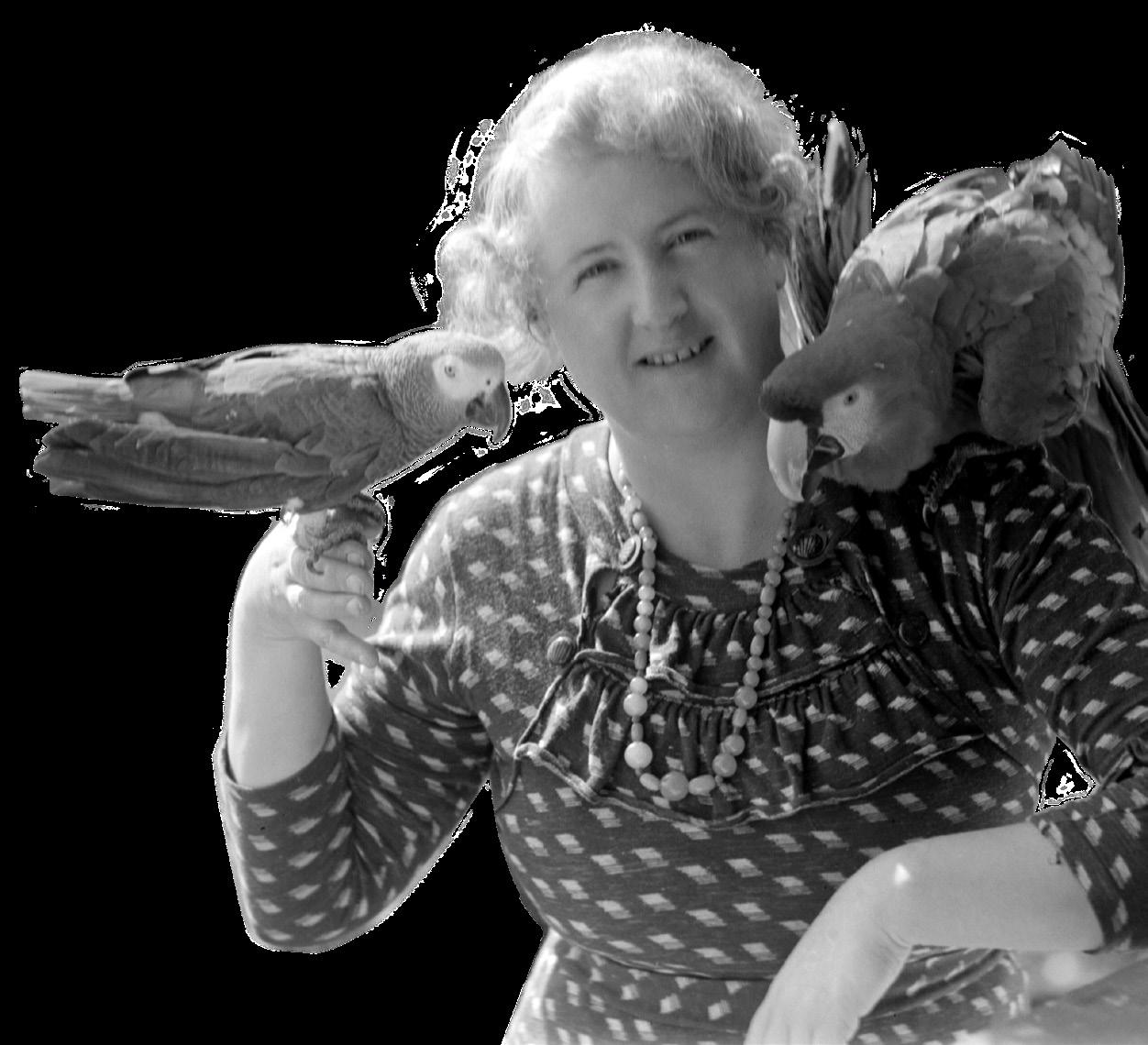
TE REO O TE TAIAO № 388 WINTER 2023
NEW ZEALAND’S INDEPENDENT VOICE FOR NATURE • EST. 1923 CREATE A BIRD-SAFE GARDEN SANCTUARY
COVER SHOT Puawānanga (Clematis paniculate). Rob Suisted. Our 1950s custom cover was inspired by issue 110 of Forest and Bird, published in November 1953, which also featured New Zealand’s native bush clematis.
PAPER ENVELOPE Pīwauwau rock wren. Jeremy Sanson RENEWAL Pepe para riki common copper butterfly. Donald Laing
EDITOR Caroline Wood E editor@forestandbird.org.nz
ART DIRECTOR/DESIGNER Rob Di Leva, Dileva Design E rob@dileva.co.nz
PRINTING Webstar www.webstar.co.nz PROOFREADER David Cauchi
ADVERTISING ENQUIRIES Karen Condon T 0275 420 338 E karen.condon@xtra.co.nz

MEMBERSHIP &
T 0800 200 064 E membership@forestandbird.org.nz
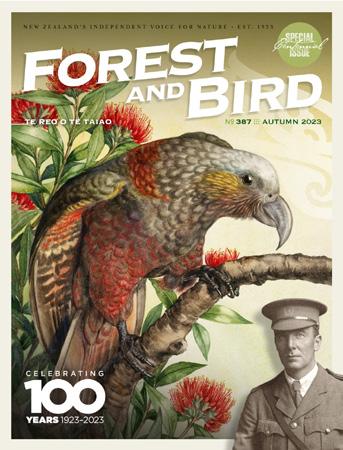
Thank you for supporting us! Forest & Bird is New Zealand’s largest and oldest independent conservation charity.

Join today at www.forestandbird.org.nz/joinus or email membership@forestandbird.org.nz or call 0800 200 064
Every member receives four copies of Forest & Bird magazine a year.

Forest & Bird is printed on elemental chlorine-free paper made from FSC® certified wood fibre and pulp from responsible sources.
CIRCULATION
Forest & Bird is published quarterly by the Royal Forest and Bird Protection Society of New Zealand Inc. Registered at PO Headquarters, Wellington, as a magazine. ISSN 0015-7384 (Print), ISSN 2624-1307 (Online). Copyright: All rights reserved. Opinions expressed by contributors in the magazine are not necessarily those of Forest & Bird. Contents ISSUE 388 • Winter 2023 Editorial 2 Lessons from the past 4 Letters + competition winners News 6 Round up of centennial events 8 Forest & Bird’s 2023 conference 10 New climate campaign, Time to stop trawling, Mining threatens kauri and freshwater 12 Te Kuha win, Glenbrook gain Cover 14 Backyard bird feeding guide 16 Keeping birds wild 17 Ready set count, Garden Bird Survey 18 Make your garden bird friendly 19 For the love of birds Climate 20 Listen to the land 23 The future won’t take care of itself 31 On the frontline Future conservation 24 Can genomics save hoiho? Biodiversity 28 Critters and Wikinerds 44 Still vanishing Forest & Bird project 32 Rewilding riflemen Centennial stories 34 Unsung women conservationists 42 Stamping our identity 54 Finding our voice 14 24
Pest-free NZ
38 Hedgedevils: A prickly problem
Freshwater
40 Shine a light
Fundraising
41 Singing for birds and bush
Forest & Bird branch
46 For Arowhenua
Marine
48 Dolphin delights
Special report
50 Protecting southern kauri (part II)
Photography

53 Top shots
Going places
54 Auckland Whale and Dolphin Safari, Hauraki Gulf

Our partners
60 Cathy Hansby: Bird works
Tribute
61 Ken Catt: Marine life champion
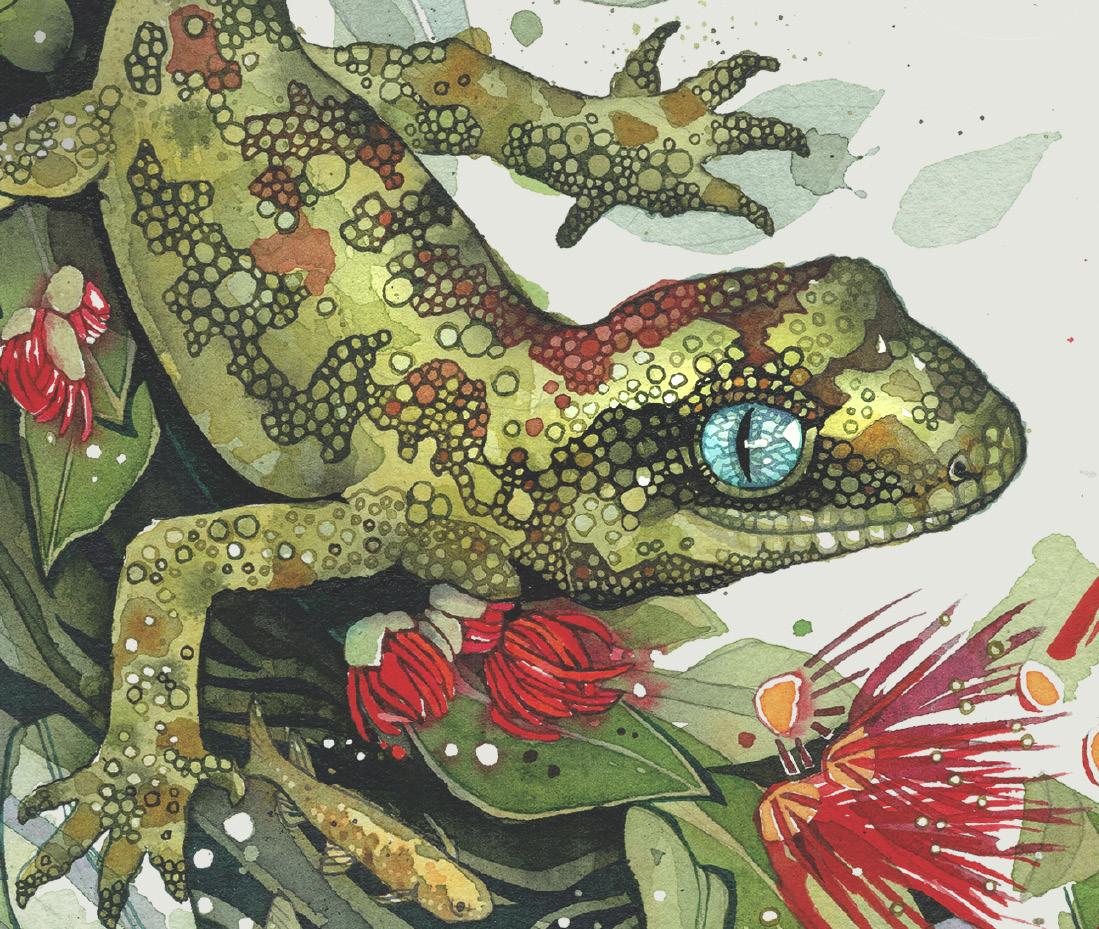
Market place
62 Classifieds

Last word
64 A clever bird thing
Parting shot
IBC Bellbird and bee
CONTACT NATIONAL OFFICE
Forest & Bird National Office
Ground Floor, 205 Victoria Street
Wellington 6011
PO Box 631, Wellington 6140
T 0800 200 064 or 04 385 7374
E office@forestandbird.org.nz
W www.forestandbird.org.nz
CONTACT A BRANCH
See www.forestandbird.org.nz/ branches for a full list of our 50 Forest & Bird branches.
www.facebook.com/ ForestandBird
@forestandbird
@Forest_and_Bird
www.youtube.com/ forestandbird
Royal Forest and Bird Protection Society of New Zealand Inc. Forest & Bird is a registered charitable entity under the Charities Act 2005. Registration No CC26943.
PATRON Her Excellency The Rt Honourable Dame Cindy Kiro, GNZM, QSO Governor-General of New Zealand
CHIEF EXECUTIVE Nicola Toki PRESIDENT Mark Hanger TREASURER Alan Chow BOARD MEMBERS Chris Barker, Kaya Freeman, Kate Graeme, Richard Hursthouse, Ben Kepes, Ines Stäger CONSERVATION AMBASSADORS Sir Alan Mark, Gerry McSweeney, Craig Potton DISTINGUISHED LIFE MEMBERS Graham Bellamy, Linda Conning, Philip Hart, Joan Leckie, Hon. Sandra Lee-Vercoe, Carole Long, Peter Maddison, Sir Alan Mark, Gerry McSweeney, Craig Potton, Fraser Ross, Eugenie Sage, Guy Salmon, Lesley Shand
42 48
LESSONS FROM THE PAST
The sea floor is covered in a choking layer of silt, smothering and suffocating many forms of marine life. Every time the sea is rough or the swells increase, the disturbance lifts the fine pumice silt back into suspension to continue its deadly effect. It reduces the light reaching algae and seaweeds, causing them to perish … The world below the ocean surface is not seen by many and is easily and conveniently ignored by both authorities and the public. It’s the ongoing tragedy of the hills of Tairāwhiti and the moana that the silt-laden and slashladen rivers flow into.”
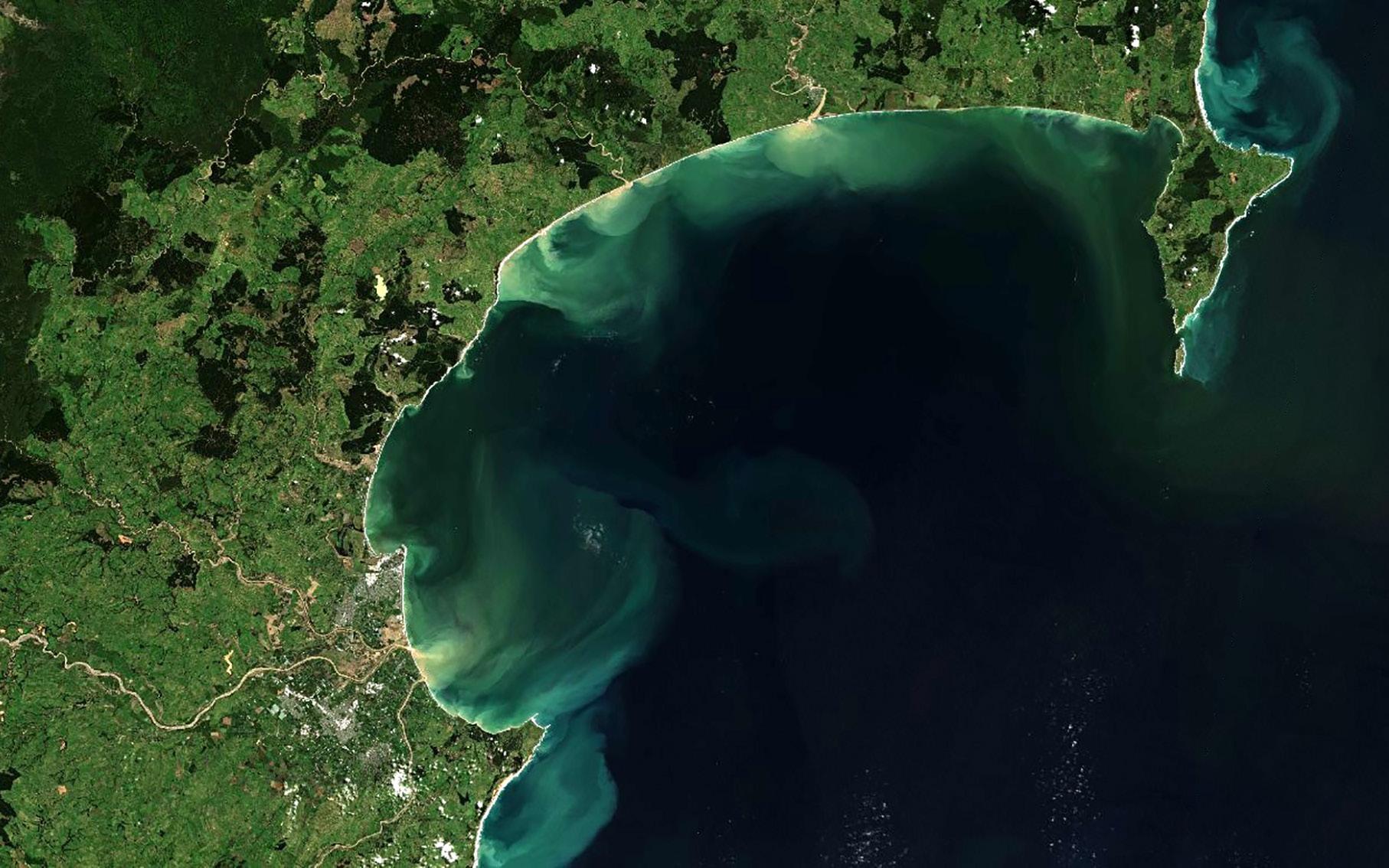
These words were written by Quentin Bennett in a Forest & Bird magazine article in November 1990. He was talking about the devastating impacts of Cyclone Bola on the marine environment, more than three decades before this year’s storms and floods in Te Tairāwhiti, Te Matau-a-Māui Hawke’s Bay, and Tāmaki Makaurau Auckland.
The East Coast of the North Island, from Hawke’s Bay to the East Cape, has a history of extreme weather events. Its steep hillsides and geography mean high rainfall events have a bigger impact than in many other parts of our country.

Following Cyclone Bola in 1988, it was suggested taxpayer-funded managed retreat from key erosionprone lands in Te Tairāwhiti and planting of these areas would likely cost less than the payout from the next natural disaster to hit the region. But, other than
increased pine afforestation, little eventuated.
Thirty years later, and Tairāwhiti has experienced recent multiple disastrous floods – in August 2014, three events in 2017/18, then in November 2021, March 2022, and most recently Cyclone Gabrielle.
The trend is frightening, especially as climate change is bringing more extreme weather events with increasing regularity.
Following Cyclone Gabrielle, multiple scars emerged on steep clear-felled hillsides, with eroded soil creating mountains of silt that headed into the ocean, smothering marine life, just as Quentin described back in 1990.
Forest & Bird has been pushing for decades for these fragile landscapes to be rested or retired. We want to see restoration planting and proper pest control to help the forests recover and bind the soils together.
Anything less than a full commitment to a managed retreat from industrial forestry and hill country farming on unsuitable land is a decision to let the whenua and moana die. It is not a question of whether we as a nation can afford to do this, it’s more the case that we can’t afford not to do it.

My hope is that someone reading this in another 30 years will be able to say that we as a nation lived up to our responsibilities, that the landscapes of Tairāwhiti are more resilient, silt loads in rivers are declining, the moana is recovering, and tāngata whenua are thriving.
☛ For more on the environmental impacts of the recent storms and flooding, and Forest & Bird’s response, see pages 20–23.
EDITORIAL
Ngā manaakitanga Mark Hanger Forest & Bird President Perehitini, Te Reo o te Taiao
“
| Forest & Bird Te Reo o te Taiao 2
Satellite image showing silt flowing into Hawke’s Bay following Cyclone Gabrielle. Koordinates
CELEBRATE CHRISTMAS IN THE SUBS
EXPLORE THE WILDS OF FIORDLAND & THE SUBANTARCTIC ISLANDS THIS SUMMER
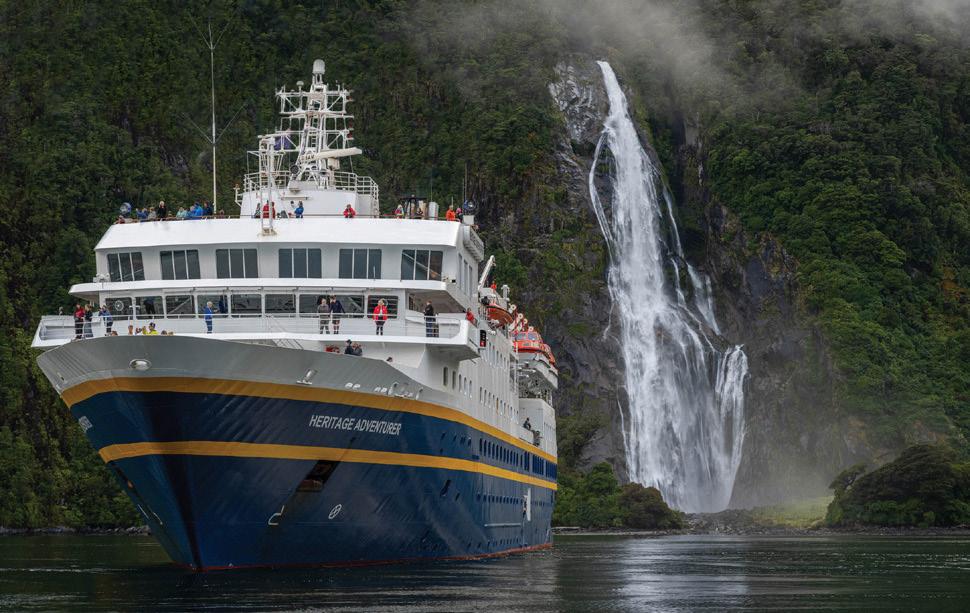
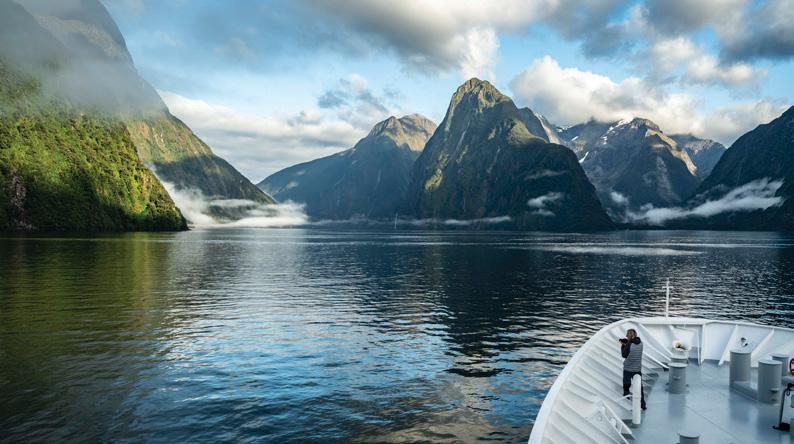
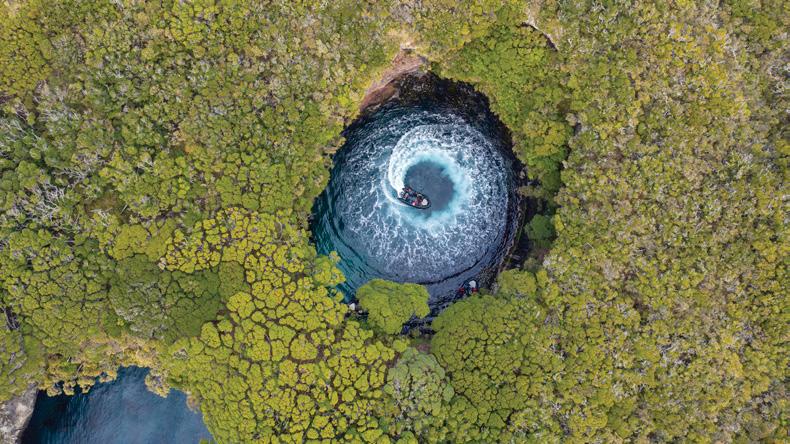
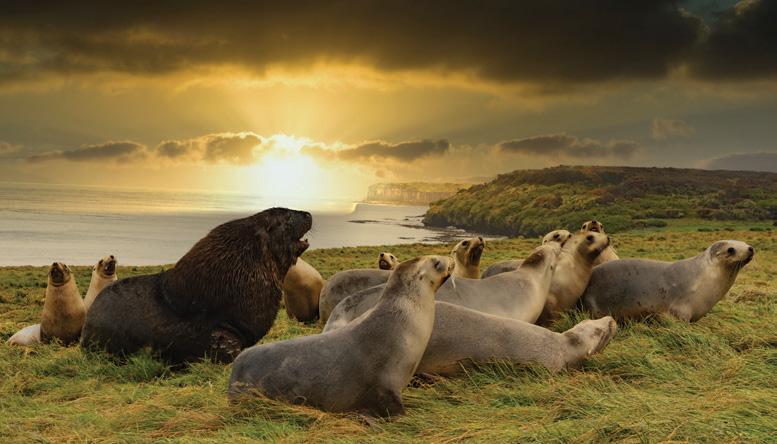
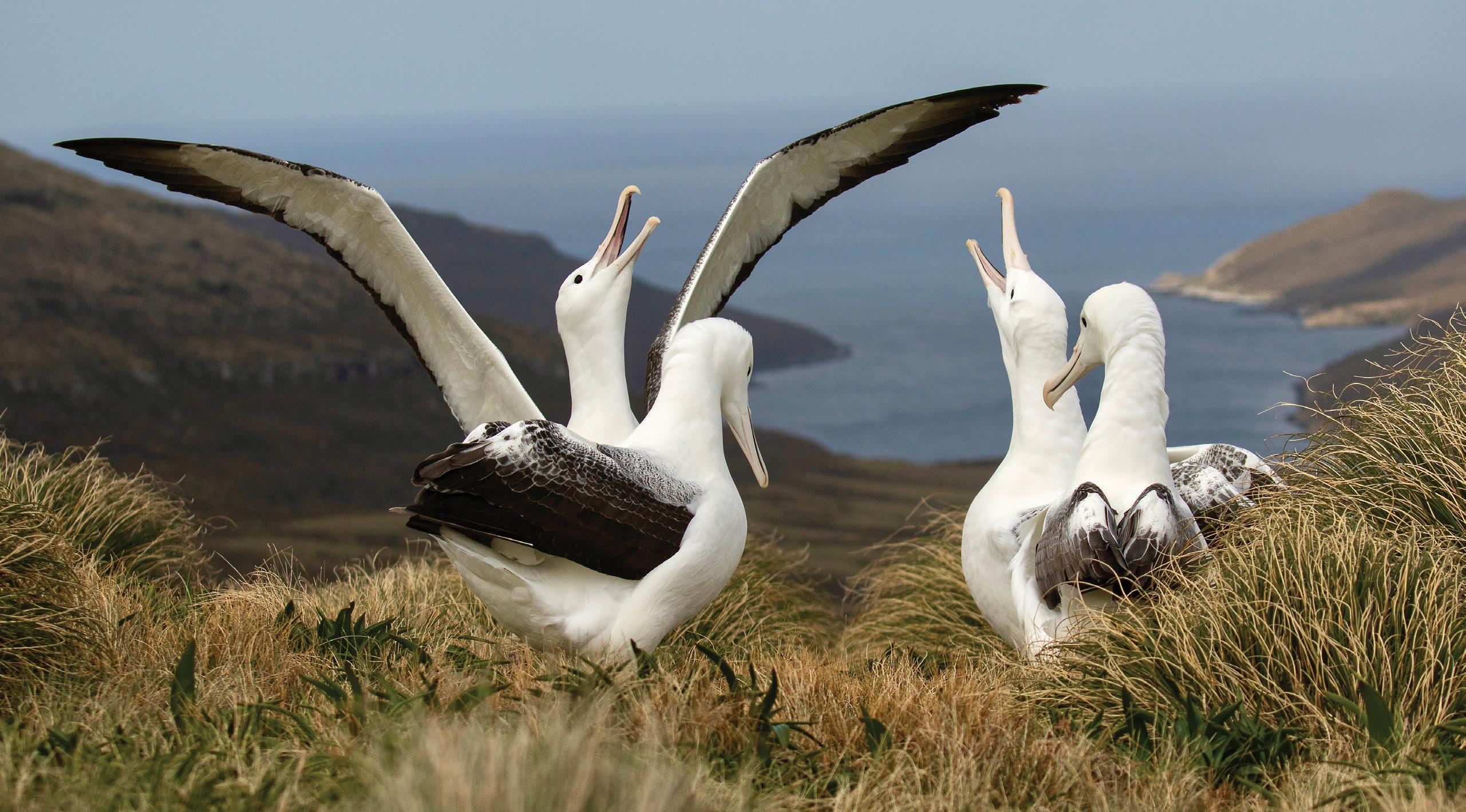
Discover the wilds of New Zealand’s Subantarctic Auckland, Snares and Campbell Islands, the untamed wilderness of Fiordland’s ice-carved mountains, forests and fiords, and Stewart and Ulva Island on this iconic 12-day Kiwi voyage. Celebrate Christmas in this very special part of remotest New Zealand, observe life at the New Zealand/Hooker’s Sea Lion colony on Enderby Island and wade through waist-deep fields of flowering megaherbs. Share in the magic of the rarely seen albatross ‘gamming’ courting ritual, observe the antics of Snares Crested Penguins navigating the trecherous Penguin Slide and much more.
BEYOND FIORDLAND | 12 Days
20 – 31 December 2023
$12,750pp + KIDS SAVE 70%* Superior Deck 4 Stateroom, twin share

INCLUDES
• Pre cruise hotel night in Queenstown including dinner & breakfast
• All on board accommodation & meals

• House wine & beer with lunch & dinner
• All shore excursions^
• Pre & Post cruise transfers
• Lecture series by noted naturalists
FOREST & BIRD MEMBERS SAVE 5%* PLUS a contribution from your fare is donated to Forest & Bird to support their ongoing conservation work!

Fiordland
The Snares Stewart Island
Auckland Islands
Queenstown Invercargill
Campbell Island
*T&Cs apply, new bookings only, children under the age of 18 years, must travel with a full fare paying adult, excludes F&B discount. ^Excludes optional excursions.
KIDS SAVE 70%
© Luis Davilla
© Chris Todd © Heritage Expeditions
See our website for more Subantarctic adventures! WWW.HERITAGE–EXPEDITIONS.COM Freephone 0800 262 8873 info@heritage-expeditions.com
© Doug Gimesy
*
LETTERS
YOUR FEEDBACK
Forest & Bird welcomes your thoughts on conservation topics. Please email letters up to 200 words, with your name, home address, and phone number, to editor@ forestandbird.org.nz, or by post to the Editor, Forest & Bird magazine, 205 Victoria Street, Wellington 6011, by 1 August 2023. We don’t always have space to publish all letters or use them in full. Opinions expressed on the Letters page are not necessarily those of Forest & Bird.
DEGROWTH MATTERS
Thanks for publishing the Sahra Kress article on degrowth (Autumn 2023). It seems very timely, given the latest updates from the IPCC. Climate breakdown is just one of the planetary boundaries we are breaching, although it is probably the most urgent. Currently, we seem locked into a cycle of public apathy and blame-deflection reinforcing political cowardice and inaction. As well as getting political, each of us should, I think, ask ourselves what we are doing to cut our own GHG [greenhouse gas] footprint? For most of us, a big component is likely to be travel, especially aviation. It’s worth noting that a sustainable annual GHG footprint would be around two tonnes CO2 equivalent per human and one return economy flight AKL–LHR emits about four times that amount. Even domestic car trips across the country have a significant footprint. Saving individual native species is of little consequence if our lifestyle is contributing to Earth’s sixth mass extinction.
Graham Townsend Christchurch
The Degrowth Revolution (Autumn 2023) was a great read and ticks all the boxes – everyone can contribute a bit to degrowth with just some behavioural change. A useful tool for households and small businesses can be the free and easy carbon calculator with a reduction planner at www.carbonneutraltrust.org.nz. Once you know your own CO2 emission footprint, you realise what can be reduced – often quite painlessly and inexpensively. We are an able and responsible team of five million.
Rolf Mueller-Glodde Carbon Neutral Trust NZ
NEW AGENCY NEEDED
Thousands of pest animals infest the North Island’s alpine and native forest communities, wetlands, and dunelands. The animals include several species of deer plus feral pigs, goats, sheep, cattle, and horses. Every year, they devour huge tonnages of our native plants, while
BEST LETTER WINNER
WRITE AND WIN
The best contribution to the Letters page will receive a new edition of The South Island of New Zealand – From the Road by Robin Morrison (Massey University Press, $75). Originally published to much acclaim in 1981, this new reprint coincides with an exhibition of Morrison’s images at the Auckland War Memorial Museum.

their hooves disturb fragile soils on erosion-prone slopes. This destruction is exacerbated by the damage possums, rats, mice, stoats, weasels, ferrets, rabbits, hares, hedgehogs, and feral cats do to native plants, birds, lizards, and invertebrates. Ecosystem destruction by pest animals for over a century in native forests on the North Island’s Raukūmara, Te Ūrewera, Ahimanawa, Kāweka, Kaimanawa, Ruahine, and Tararua ranges contributed to the devastation caused by Cyclone Gabrielle’s huge downpours. The result? Billions of dollars of damage in Te Tairāwhiti and Hawkes Bay. The destruction of landscapes, settlements, farms, horticulture, roads, railways, telecommunications, and coastal areas was catastrophic. Government budgets should fund an agency similar to the former New Zealand Forest Service’s Noxious Animals Division, to employ cullers to shoot alien herbivores and poison and trap smaller pests. This will give the indigenous ecosystems of our axial ranges time to recover, increasing their resilience against future storms of Cyclone Gabrielle’s ferocity, while restoring the forests’ crucial carbon-sequestration function.
Chris Horne Wellington
DON’T KILL THE GOOSE
I refute all that Peter Jackson said, in practical and philosophical terms, but he had every right to air his views (“Funding DOC”, Autumn 2023). Given what has happened with Cyclone Bola and, more recently, Cyclone Gabrielle, we are reaping the consequences of poor land management, not least being unwise native forest clearance. The thoughts that our last few remaining (and still retreating) precious taonga could be exploited for timber (along with tourism) to fund the Department of Conservation’s core function is a complete anathema to me. If he is so keen to still use native trees for timber, I ask him the same question I ask others who propose the same kinds of exploitation: How about growing new native forests for such purposes rather than exploiting existing natural forests? Yes, we
| Forest & Bird Te Reo o te Taiao 4
could benefit from native timber, but not from natural sources, and we need much more research into the silviculture of native species with timber potential. As for tourism, this is a real double-edged sword for our natural areas and so much has been put at risk by the impact of tourism in many of our natural areas. Great care is needed to not kill the [golden] goose.
Martin Nicholls New Plymouth
AUNTIE ACES IT
On receiving the impressive special Centennial issue (Autumn 2023), I was immediately taken by the picture of the kākā on the front cover that looked familiar. The reason was revealed when I checked my copy of the second edition of the Forest & Bird publication New Zealand Forest-Inhabiting Birds that was a gift from an aunt, probably in 1949 or 1950. The same picture is in that book, where it is named the “brown kākā”. The picture appears to be identical except that the cover version seems to be a mirror-image of the other, with the kākā facing to the right rather than the left. The book is certainly a great source of information on the birds. Thank you again for the outstanding issue of the magazine.
Roger Purchas Palmerston North
Editor’s note: Well spotted! The Autumn cover featured Lily Daff’s original artwork, one of 52 commissioned by Forest & Bird to show New Zealanders the beauty of their unique birdlife. The Society’s first colour cover featuring Daff’s “brown kākā” was published in August 1933. Ninety years later, the original painting is still in pristine condition in the Alexander Turnbull Library. This whakapapa provided the inspiration for our 100th birthday issue and art deco cover. You can read more about Daff’s life and impact on page 37.
RADICAL CONNECTIONS
While I found Dr John Flux’s article “Radical Connections” (Autumn 2023) very interesting, I also found it somewhat negative. It’s easy to point out what’s wrong with the way things are or with the efforts being taken by us humans to improve our natural world, but this article had few proposed alternatives and those that were proposed weren’t backed by successful real world examples. The “ecological way to tackle introduced predators” was indicated to be starting with mice and working up to the apex predators and suggested that current approaches being taken are wrong. I would like to see a follow-up article where Dr Flux provides
BOOK GIVEAWAY
We are giving away two copies of Takahē Bird of Dreams by Alison Ballance, the inspiring story of the rediscovery and then recovery of the takahē (Potton & Burton, $59.99).

To enter, email your entry to draw@forestandbird.org.nz, put TAKAHĒ in the subject line, and include your name and address in the email. Or write your name and address on the back of an envelope and post to TAKAHĒ draw, Forest & Bird, PO Box 631, Wellington 6140. Entries close 1 August 2023.
The winners of Soundings, diving for stories in the beckoning sea by Kennedy Warne were Ron Vautier, of Hamilton, and Suzanne Hills, of Runanga. The winners of The New Zealand Seashore Guide by Sally Carson and Rod Morris were Nick Wiffen, of Motueka, and Ruth Underwood, of Mount Maunganui.
proposed solutions alongside successful examples of each. This would be a much more constructive, positive, and beneficial article than the rather doom-and-gloom article that was printed.
Jared Oliver Dunedin
John Flux responds: I agree with Jared – I do feel negative. There are no “successful examples”. Take RHD (Rabbit Haemorrhagic Disease), discovered in China from a load of rabbits imported from Germany. The Australians brought in RHD for trials, but it escaped (what’s new?), and any ecologist could have told them the result, because all hosts adapt to a virus or any other parasite. Then farmers illegally imported it into New Zealand to kill the rabbits on their land and caused the oscillating rabbit numbers we warned them about. Whenever rabbit numbers fall, predators turn to birds, at random, anywhere, but RHD keeps being spread by disgruntled farmers worldwide. Last year, it arrived in South Africa and is now killing protected rare native rabbits and hares. In Europe, where rabbits and hares are valuable game, they have to be caught and inoculated. In short, I guess my solution is to stop trying to “improve the natural world” and just let it adapt the way it sees fit, but get back to 50% native forest or more. Humanity occupies far too much space.
John Flux Wellington
5 Winter 2023 |
100 YEARS AND COUNTING...
Standing in the dappled light of a leafy canopy, in a small clearing at the heart of the Waikākāriki wetland is the family of Forest & Bird’s founder Captain Ernest “Val” Sanderson. They are accompanied by chief executive Nicola Toki, iwi representatives, Kāpiti Mayor Janet Holborow, and other invited guests.
We are here to watch the unveiling of new signage about Sanderson’s life and legacy in Paekākāriki, a place that inspired his passion for protecting nature. It has been installed along the newly named “Sanderson’s Way” – a gentle tree-lined path that forms part of Te Araroa Trail.


The sign was blessed by Dr Taku Parai, of Ngāti Toa Rangatira, and six tōtara were planted in memory of Sanderson by members of his whānau and invited guests.
The Waikākāriki wetland is a sliver of land that runs between State Highway 59 and the Kāpiti railway line.
Volunteers from local conservation group Ngā Uruoa, led by Paul Callister, have spent
several years painstakingly ripping out invasive weeds, planting native plants, and bringing Waikākāriki back to life. It was Paul who first suggested a permanent tribute to Sanderson here in the recovering wetland.
Sanderson lived and worked in Paekākāriki village while running Forest & Bird for more than 20 years. His house overlooked Kāpiti Island, the inspiration for the establishment of the Society on 28 March 1923.
Ten members of Val Sanderson’s family travelled to Paekākāriki in late April to attend a weekend of celebrations, exhibitions, and children’s activities in memory of Forest & Bird’s founder. Those present included three grandsons Justin Jordan, Giles Jordan, and Guido Panduri, as well as Sanderson’s niece Enid White.
“The name ‘Sanderson’s Way’ has a double meaning to us,” explained Justin. “This small patch of land is a fine example of how anyone – and all of us – can help make a difference. We need to keep growing these small patches by
working together.”
The weekend’s celebrations included an “Inspired by Sanderson” exhibition featuring artefacts that once belonged to him, along with early examples of Forest & Bird’s publicity materials, including posters, magazines, and books. Kāpiti-Mana Branch chair Pene Burton-Bell, who helped organise the weekend’s activities, said Sanderson’s mission to give nature a voice had motivated her and many others to become conservation volunteers.
“Our branch was established in 1974, nearly three decades
NEWS
NATURE
It’s been wonderful to see some of you at our centennial celebrations around the country, including the opening of Sanderson’s Way. Zoë Brown
Justin Jordan and Nicola Toki Bob Zuur
Sanderson’s family at the start of the newly named ‘Sanderson’s Way’. Bob Zuur
| Forest & Bird Te Reo o te Taiao 6
after Sanderson’s death, and has achieved many wins for nature since then,” she said. “I think Captain Val would have been pleased to see what has been achieved so far. It gives me hope for the future.”
Justin generously gifted a collection of Captain Val’s treasured possessions to Forest & Bird, including a perfectly preserved Underwood portable typewriter that his grandfather used to smash out countless letters to government officials.

“Forest & Bird was started by a volunteer who saw our native birds and bush disappearing and decided to do something about it,” said Nicola Toki.
BIG BIRTHDAY BASHES
Three stunning landscapes – Bushy Park Tarapuruhi, Pelorus Bridge Scenic Reserve, near Nelson, and Forest & Bird’s Lenz Reserve, the Catlins, provided the backdrop for Big Birthday Bash parties around the country. More than 600 people from across the motu joined in the March celebrations marking 100 years of Forest & Bird. There was cake aplenty, with creative nature-themed delicacies being whipped up, plus scavenger hunts and conservation activities for the whole whānau. Several branches also organised birthday parties and special events, including Golden Bay, North Canterbury, West Coast, and Manawatū. A huge thank you to the branch members, project volunteers, and staff who helped organise all of these events.
FORCE OF NATURE CONCERTS
Three concerts have been held to date starting with a sold-out performance at Tāmaki Makaurau Auckland Arts Festival on 17 March, before heading south to Wānaka and Ōtautahi Christchurch. The Force of Nature concerts showcased the work of eight New Zealand composers, who created modern classical music inspired by Forest & Bird’s whakapapa. The new works were well received by the audience and critics alike. Forest & Bird would like to thank Jenni Murphy-Scanlon, chief executive of the Performing Arts Community Trust, for her hours of work on this music-meets-nature project. Watch this space for future concerts around the motu!

You can experience the music at home by buying a Force of Nature CD. Check out this review here www.fivelines.nz/articles/ forceofnature. The CD is available from Forest & Bird’s online shop at shop.forestandbird.org.nz
CENTENNIAL SPEAKER SERIES
“That same spirit remains at the heart of Forest & Bird today. We continue to campaign for change – to churn out submissions and letters, just using computers instead of typewriters!

“Sanderson and his legacy prove we can make a difference for our wild places and wildlife – especially when we come together.”
Forests for Human Health and Wellbeing kicked off Forest & Bird’s 12-month centennial speaker series on International Day of Forests in March. The panellists included Dr Geoffrey Handsfield, Senior Research Fellow and Forest Therapy Guide, Rongoā Māori Practitioner Rob McGowan, and Dean BaigentMercer. Forest & Bird is encouraging everyone to plant native trees this winter. Keep an eye out for commemorative planting events coming soon. The second speaker series focused on Forest & Bird’s new stamps – see page 42.
Find out more about Forest & Bird’s Centennial Celebrations programme at www.forestandbird.org.nz/natures-voice-100-years-and-counting. See pages 34, 42, and 54 for more centennial-related events.
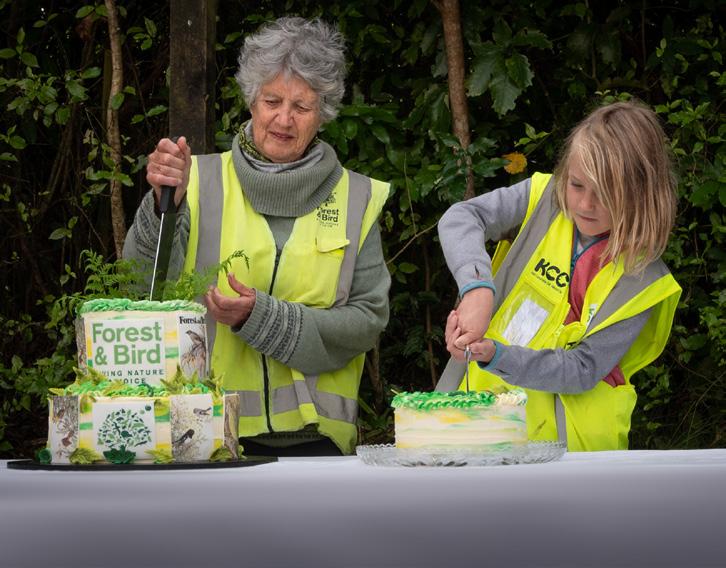 Force of Nature concert, Auckland Arts Festival Andi Crown.
Esther Williams and Matai Moore, Bushy Park Tarapuruhi.
Sanderson in his Paekākāriki garden, circa 1930s.
Force of Nature concert, Auckland Arts Festival Andi Crown.
Esther Williams and Matai Moore, Bushy Park Tarapuruhi.
Sanderson in his Paekākāriki garden, circa 1930s.
7 Winter 2023 |
Sanderson’s Underwood portable typewriter.
After a hiatus of three years, Forest & Bird’s annual conference is back! Join us at Te Papa, Wellington, to celebrate a century of conservation mahi, discuss current environmental challenges and solutions, and look ahead to the next 100 years.

The theme is bold leadership in a time of crisis, and Forest & Bird’s chief executive Nicola Toki will deliver a State of the Nation address explaining why looking after the environment matters more than ever in our fastchanging world.
A series of thought-provoking sessions will follow with an exciting line up of guest speakers, including a keynote address from Simon Upton, the Parliamentary Commissioner for the Environment. The MC for the day will be Jesse Mulligan, of RNZ and Discovery’s The Project.
Gisborne Mayor Rehette Stoltz will join Federated Farmers President Terry Copeland and Air New Zealand’s Chief Sustainability Officer Kiri Hannifin in a panel discussion about business and community responses to the climate and biodiversity crises.
The conference will also provide an opportunity to explore the future of conservation – drawing on expertise from iwi leaders and academics, including Dr Amanda Black, co-director at Bio-Protection Aotearoa Research Centre, and Mananui Ramsden, chairperson of Te Rūnaka o Koukourata, Banks Peninsula. They will challenge the audience to think outside the box.
There will be a panel discussion of leading political and environmental journalists, who will discuss crisis communication and what it will take for politicians and business leaders to act on environmental issues and climate apathy. This session includes Eloise Gibson, climate change editor at Stuff NZ, Dale Husband (Ngāti Maru), of Waatea News, TV3’s Isobel Ewing, and Marc Daalder from Newsroom.
This session will be followed by a rangatahi panel of
CENTENNIAL CONFERENCE
SATURDAY 29 JULY 2023
TE PAPA, WELLINGTON
inspiring young Kiwi environmental leaders, who will provide perspectives from a generation that will live with the consequences of the choices we are making today. Professor Jacinta Ruru, Māori Law Professor and legal scholar, will join Nicola Toki to wrap up the day with a session about shifting our mindset and looking forward to the future.
In the evening, we will be celebrating Forest & Bird’s first 100 years at this year’s Sanderson dinner and conservation awards ceremony, where we will be honoured to hear from historian, author, and environmentalist Dame Anne Salmond.

You can see the full Centennial Conference programme and register at www.forestandbird.org. nz/conference-registration

100 NATURE HEROES
We are looking forward to launching Forest & Bird’s Conservation Heroes tribute during National Volunteer Week (18–24 June 2023). Do you know someone who is a conservation hero for nature who deserves some recognition? You don’t need to be a Forest & Bird member to nominate a hero or be nominated. Nominees will receive a certificate in recognition of their work to protect te taiao. Nominations will be open until February 2024. Please keep an eye on your inbox and social media or check our website for more information. In the meantime, check out page 34 for six women heroes in Forest & Bird’s history.
NATURE NEWS
Juvenile kea, Arthur’s Pass. Daniel Dirks
| Forest & Bird Te Reo o te Taiao 8

NEW CLIMATE CAMPAIGN
Forest & Bird, together with our allies Oxfam Aotearoa and Greenpeace Aotearoa, is set to launch Climate Shift: A 10-point plan for action.
During 2023, we have experienced several “1 in 100 year” weather events, including Cyclone Gabrielle’s flooding, erosion, and landslides in the north and severe droughts in the south.
Communities across Aotearoa New Zealand are aready feeling the devastating consequences of successive governments’ inaction.
Our new Climate Shift campaign calls on government ministers, MPs, and political parties to step up a gear and urgently address the climate crisis. Forest & Bird, Greenpeace, and Oxfam have put together 10 key climate actions that, if implemented, would restore nature, cut emissions, and protect frontline communities.
“This year’s extreme weather events underscore the urgency of addressing this crisis head on,” says Nicola Toki, Forest & Bird’s chief executive.

“With October’s general election coming up fast, we want to hear how political parties intend to rebuild and stop future climate disasters from happening in our country.
“I suggest they start by looking at the 10 key policies developed for the Climate Shift campaign and make sure they put nature, and proper funding, at the heart of their responses.”
The Climate Shift campaign will soon be visible across Aotearoa, with public meetings, posters, billboards, hoardings, election debates, and more planned.
“Together, let’s demand urgent climate action from ourpoliticians ,” says Forest & Bird’s Climate Shift campaign lead George Hobson. “Please help us make 2023 a turning point for climate action in Aotearoa.”
Find out more about Climate Shift’s 10-point plan and how you can help spread the word at www.forestandbird.org.nz/climateshift
TIME TO STOP TRAWLING
Hundreds of people and a flotilla of crafts turned out to oppose bottom trawling in the Hauraki Gulf, in an protest organised by Forest & Bird and Greenpeace Aotearaoa.

The Show Your Heart For The Hauraki event in April attracted more than 60 vessels, including yachts, kayaks, and paddleboards, who surrounded a huge banner calling for an end to the fishing practice.
Bottom trawling is a fishing method that involves dragging large weighted nets across the seafloor, bulldozing ocean life and indiscrimately destroying precious ecosystems.
“Tīkapa Moana is a biodiversity hotspot, it is a taonga, and we must do everything we can to revitalise the mauri and life-sustaining capacity of the Gulf,” said Bianca Ranson, Forest & Bird’s Hauraki Gulf coordinator.
“Everything is connected in an ecosystem, and it is deeply disappointing bottom trawling is still being allowed.
“The government is considering decisions that will determine whether the Gulf thrives or declines further into ecological collapse.
NATURE NEWS
Jo Dighton rescues a pet chicken from floodwaters caused by Cyclone Gabrielle in Hawke’s Bay. Steve Dighton
Greenpeace | Forest & Bird Te Reo o te Taiao 10
“We’re here to tell Ministers to listen to the tens of thousands of people that want protection and not be influenced by commercial fishing industry lobbyists.”
The event, which took place off Mission Bay, Auckland, is part of our Love the Gulf campaign to protect and restore Tīkapa Moana from manmade ecological threats, including overfishing, sedimentation, and climate change.

People turned up because they wanted to see a thriving vibrant Tīkapa Moana, said Ellie Hooper, Greenpeace’s oceans campaigner.
“Trawling has no place in this precious marine park, and the public mandate for change is clear – more than 84% of people surveyed want trawling gone from the Gulf.”
☛ Dolphins, gannets, and sharks: see page 58 for more on the marine treasures of the Hauraki Gulf.
MINING THREATENS KAURI AND WATER
Concerned Whangaroa hapū members and Forest & Bird representatives gathered at two locations in Northland during April to speak out against the threat of mineral mining.
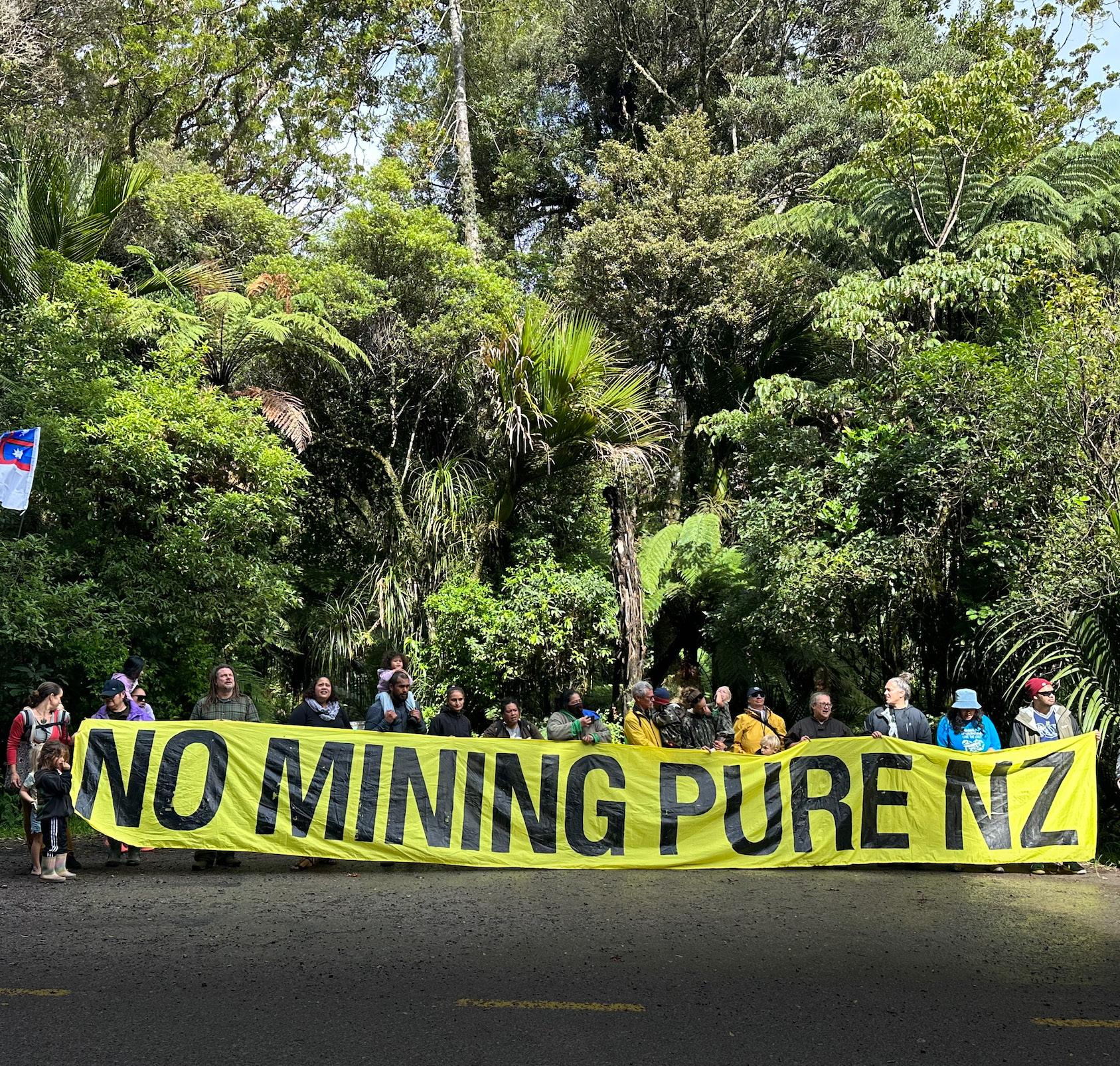
Manginangina Scenic Reserve, Puketī Forest, is among the last 1% of unlogged ancient kauri forest in Aotearoa New Zealand.
The area is included in a prospecting permit for lithium and rare earth elements the government granted last year to Mineralogy International Limited, owned by controversial Australian mining billionaire Clive Palmer.
Whakarara Conservation Area, behind beautiful Te Ngaere Bay and above the water source of local Ngāi Tupango hapū, is included in a different prospecting licence held by the same company.
The prospecting permits cover private land, Māori land, and public conservation land that is under Treaty claim.
“In this area, we have underground streams all through our maunga and whenua,” said Robyn Tauroa, of Whangaroa Papa Hapū.
“We would not want toxic mining waste here, in an area famous for flooding, that could lead to the pollution of waterways out to Whangaroa Harbour and the sea.”

More than 150,000ha of exploration and prospecting permits have been granted on public conservation land since 2017, when the government promised to end new mines.
Forest & Bird has been calling on the government to fulfil its 2017 promise, helping the public write to MPs in support of a Bill to end new mines on conservation land, and holding protest banner events around Aotearoa.
“We need the government to hurry up and fulfil their promise. Local communities shouldn’t have to fight to stop mining destroying the ancient forests, wetlands, and rivers we thought were already protected,” said Forest & Bird’s Dean Baigent-Mercer, who attended the Northland protests.
Protest at Manginangina Scenic Reserve, Puketī Forest, Northland. Forest & Bird/George Hobson
11 Winter 2023 |
Forest & Bird’s Hauraki Gulf coordinator Bianca Ransom.
TE KUHA WIN!
This is one of those cases where Forest & Bird can make a difference,” said the Society’s legal counsel Peter Anderson. “Without us, a coal mine would likely be consented by now.”
In April, the Environment Court ruled that resource consents should not be granted for an opencast coal mine on the Te Kuha escarpment, overlooking Westport.
It’s a big win for the climate and threatened species, especially New Zealand’s rarest butterfly –the proposed mine site is home to the largest known forest ringlet population nationwide.
Since 2017, Forest & Bird has been battling on three legal fronts to stop the mine, with our lawyers winning cases in the Environment Court, High Court, Court of Appeal, and Supreme Court.
Stevenson Mining Limited is running out of legal options, but it has rolled the dice one more time – by appealing the latest Environment Court decision.
The vast majority of the 144ha mine footprint is covered in indigenous forest and shrubland with 500-year-old pink pine, mountain beech, pahautea, and
yellow-silver pine. It is particularly rich in moss and liverwort species.
It is located on a local purpose reserve, administered under the Reserves Act by the Buller District Council for water conservation purposes. About 12ha is conservation land administered by the Department of Conservation.
The proposed site occupies the crest of a ridge at a point where the Buller coal measures overlap with the Paparoa coal measures, the only place in the country where the two occur together.
It has a distinctive low-growing “coal measures vegetation” because of its altitude and the acidic nature of its soils. This area has no roads and has been subject to very little human activity, thus
it possesses very high naturalness and visual amenity.
It is home to a number of threatened plants and animals, including roroa great-spotted kiwi, mātātā South Island fernbird, New Zealand pipit, native geckos, and an undescribed leaf-veined slug, which is potentially locally endemic.


“The ruling shows environmental bottom lines are so important –you can’t offset or compensate your way out of destroying unique landscapes, plants, or animals,” said Forest & Bird’s chief executive Nicola Toki.
Te Kuha Partnership (made up of the Stevenson Group and Wi Pere Holdings) is the owner of Rangitira Developments, which holds the mining permit over the Te Kuha prospect. It has appointed Stevenson Mining as the project coordinator and mine operator.
The company needed three sets of permissions: resource consents, permission to mine public conservation land administered by DOC, and permission to mine the public reserve administered by Buller District Council.
Over the past six years, it has lost in all three areas, with April’s
NATURE NEWS
“
Thanks to thousands of you, our legal team has clocked up (another) win for Te Kuha, the latest in a six-year campaign to save it from being mined.
Te Kuha escarpment with untouched forest below. Neil Silverwood
| Forest & Bird Te Reo o te Taiao 12
Distinctive low-growing vegetation is a feature of Te Kuha. Neil Silverwood
win coming just after Forest & Bird marked its 100th birthday.
One donor reacted joyfully to the news, saying: “I couldn’t be a lawyer, but I’m so proud to be a paid-up member of Forest & Bird so I can support this sort of legal action, which is so necessary.
“So few groups have the strength of resources to carry this sort of action through to a Supreme Court conclusion, but Forest & Bird has this collective power. Thanks for your determination, uncompromised kaupapa, and follow through.”

Crucial policies that helped the courts form decisions on the case included the West Coast Regional Policy Statement and the National Policy Statement for Freshwater.
Forest & Bird staff have put in many hours of time and effort advocating for stronger rules to be put into both policy statements. This

work paid off with the Te Kuha case and will help defend nature against climate change in the future.
“This coal mining company has seen legal failure after legal failure. It lost in the Supreme Court, and it doesn’t have any land access. It’s time to withdraw this climate-and biodiversity-damaging proposal once and for all,” added Nicola Toki.
“Charities like ours shouldn’t have to spend years in court battling coal mining companies. For a safe climate, we urgently need to stop all new and expanded coal mines.”
GLENBROOK GAIN
The government has finally taken a meaningful step towards reducing Aotearoa New Zealand’s unsustainably high carbon emissions. In May, the Prime Minister announced a deal with New Zealand Steel and Contact Energy to subsidise a new “electric arc” boiler for NZ Steel’s Glenbrook Plant. This will reduce 800,000 tonnes of climate pollution each year – one percent of the country’s total annual emissions. We’d now like to see Labour follow through on
D i s c o v e r t h e u n i q u e b i r d s a n d p l a n t s t h a t c a l l t h e C h a t h a m
D i s c o v e r t h e u n i q u e b i r d s a n d p l a n t s t h a t c a l l t h e C h a t h a m
I s l a n d s h o m e o n t h e m o s t c o m p r e h e n s i v e g u i d e d e x p l o r a t i o n o f
I s l a n d s h o m e o n t h e m o s t c o m p r e h e n s i v e g u i d e d e x p l o r a t i o n o f t h e s e r e m o t e i s l a n d s w i t h o r n i t h o l o g i s t t h e s e r e m o t e i s l a n d s w i t h o r n i t h o l o g i s t M i k e B e l l . M i k e B e l l .
9 to 16
8 - d a y g u i d e d t o u r w i t h o r n i t h o l o g i s t a n d
c o n s e r v a t i o n i s t M i k e B e l l c o n s e r v a t i o n i s t M i k e B e l l
i t h o l o g i s t a n d
Jan 2024 check out our website for additional tour dates!


D i s c o v e r u n i q u e p e o p l e , h i s t o r y , c u l t u r e ,
D i s c o e r u n i q u e p e o p l e , h i s t o r y , c u l t u r e ,
g e o l o g y , f l o r a a n d f a u n a g e o l o g y , f l o r a n d f a u n
V i s i t P i t t I s l a n d n a t u r e r e s e r v e s
V i s i t P i t t I s l a n d n a t u r e r e s e r v e s
E x p l o r e o u t e r i s l a n d s , i n c l u d i n g S E I s l a n d a n d
E x p l o r e o u t e r i s l a n d s , i n c l u d i n g S E I s l a n d a n d
M a n g e r e f r o m t h e w a t e r
M a n g e r e f r o m t h e w a t e r
L e a r n a b o u t t h e C h a t h a m I s l a n d T a i k o T r u s t
L e a r n a b o u t t h e C h a t h a m I s l a n d T a i k o T r u s t

P r i c e f r o m $ 7 , 1 7 5 p p * . P r i c e f r o m $ 7 , 1 7 5 p p *
*The current price per person twin share in NZD. Includes return air travel on Air Chathams, seven nights' accommodation, all meals including continental breakfast/picnic lunches/buffet dinners, all sightseeing and entry fees as per itinerary. Refer to website for full price inclusions & single traveller pricing. Wild Earth Travel has regular Chatham Islands tours throughout the summer season - dates, prices and itineraries will vary.
H i g h l i g h t s : H i g h l i g h t s : 8 - d a y g u i d e d t o u r w i t h o r n
Backyard
BIRD FEEDING
We look at some environmental friendly ways to attract native birds to your garden while avoiding bad practices that could harm their health.
Dr Daria Erastova
Backyard bird feeding is an enjoyable hobby that many Kiwis enjoy. Previous studies have found around half of New Zealand households provide food for garden birds in their neighbourhood.
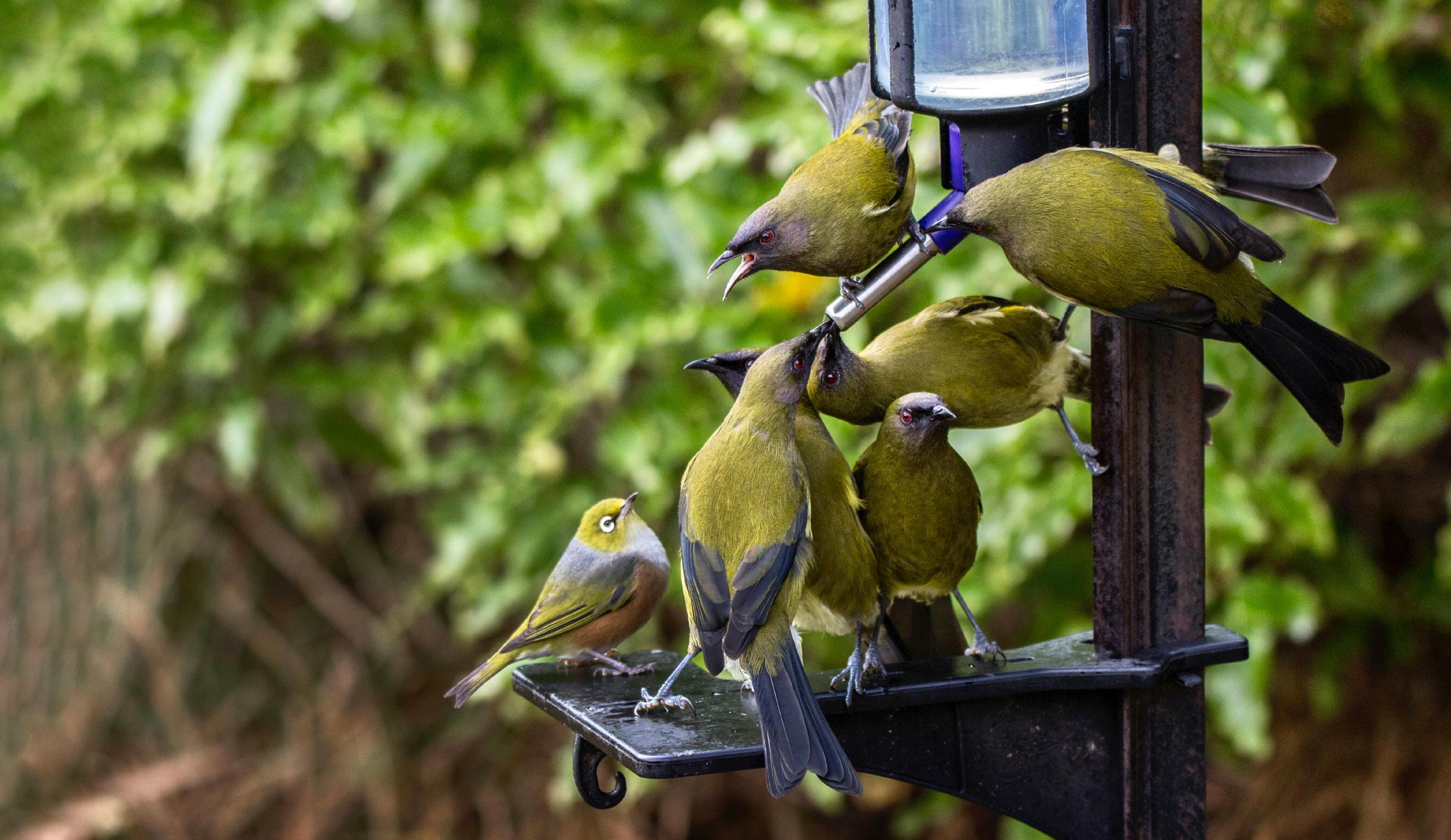
This pastime attracts birds that people can observe up close, increasing our quality of life, especially in urban areas. If done correctly, it can also provide a valuable supplementary food source for our native species, especially during winter when natural foods are scarce.
But it’s important to choose the right food and feeder type for the particular species we want to attract rather than copy practices in other countries, such as the UK, that could be detrimental for Aotearoa New Zealand’s already threatened native species.
New Zealand studies show bread and seed are the most commonly offered food in our cities.
Unfortunately, such practice is harmful because it attracts introduced grain-eating species, such as starlings, doves, and mynas, that outnumber native species.
On top of that, some grain-eating species – for example, house sparrows – can carry dangerous diseases such as salmonellosis that they can pass onto other birds, or even humans, through soiling the feeding equipment or the area around them.
Native garden birds have specific dietary
requirements to stay healthy and thrive – but none of them are grain eating. Some eat invertebrates (riroriro grey warbler, pīwakawaka fantail), flower nectar (korimako bellbird, tūī), fruit (tauhou silvereye, kākā), or tree leaves (kererū).
So offering these types of food can support taonga species and bring them into our lives. But how safe is it to offer such foods to native birds?
SUGAR WATER: In a recent research study, my colleagues and I looked at how backyard sugar-water feeding, which is an achievable alternative to flower nectar, affected tūī, korimako, and tauhou.
We found birds that visited feeders with high sugar concentrations (1 cup per litre or more) in winter had better body conditions. In addition, we sampled the feeders and the visiting birds for nasty pathogens such as salmonella, and they all returned negative.
Compared to bread and seed feeding, sugar water seems to be relatively safe for native birds and humans as long as the following rules are followed.
n Always use one of the commercially available Tui Nectar Feeder™, Topflite Nectar Nutra feeder™, or PekaPeka™ bird feeders. That will stop unwanted birds from soiling sugar water.
n Regularly clean your feeding stations to reduce pathogen growth.
COVER
GARDEN SPECIAL REPORT BIRDS | Forest & Bird Te Reo o te Taiao 14
Korimako bellbirds hogging a PekaPeka feeder from tauhou silvereye. Oscar Thomas
FRUIT: It is a good idea to offer fruit halves for fruiteating birds such as tauhou and kākā. However, people should wash fruit before offering it to remove wax and other added chemicals that make fruit look appealing. Do not offer rotten fruit, as the mould and bacteria growing on them can be harmful to birds.
INSECTS: For birds that eat insects and spiders, a freshly hard-boiled egg can serve as a great alternative protein source. Even better, build a bug hotel and plant native trees to encourage all sorts of creatures into your garden. This can provide a great food source for visiting birds.
WATER: Another important aspect of attracting birds to urban gardens is providing water for them to drink and bathe in, especially during hot and dry months. A bird bath can be as simple as a shallow dish, but it is crucial to keep the water level very shallow (4–5cm) because there is a serious risk of drowning for small native birds. It is important to change the water in your bird bath regularly to prevent the growth of algae and bacteria.
WHAT NOT TO FEED: There are definitely foods we do not recommend for backyard bird feeding. As mentioned earlier, bread and seed feeding is associated with a risk of pathogen transmission between birds and humans, and discourages native birds. Food scraps and leftovers can attract mice, rats, hedgehogs, and possums. Cheese contains too much salt and
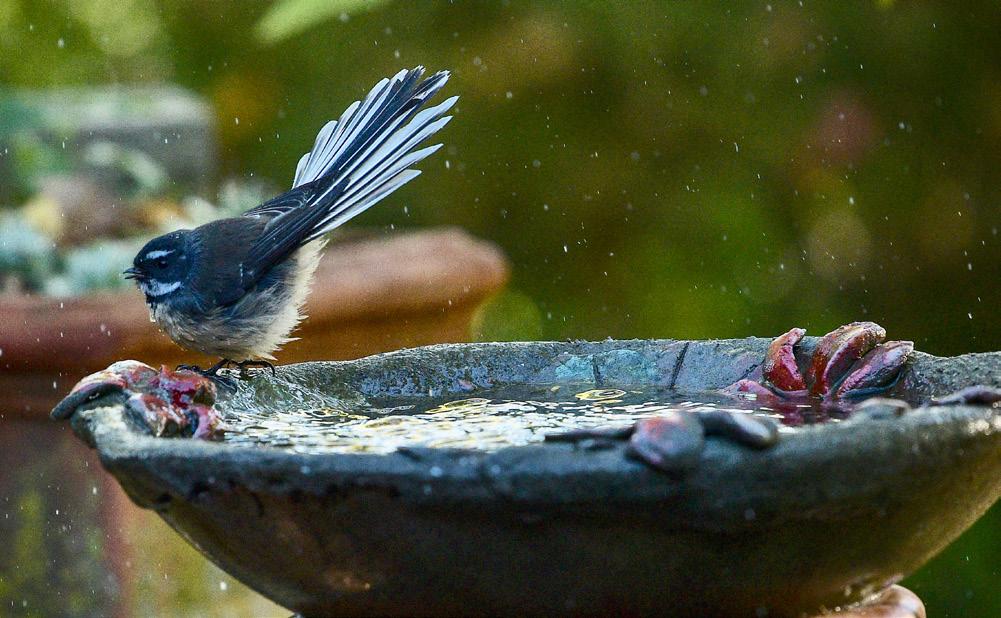
microorganisms, and it can be harmful to birds’ health. Make sure the offered food is fresh and free from dirt and mould.
TIPS FOR SUCCESS: The most important thing is to offer sugar water in a concealed container and pin it to the top of a tall pole. This will keep the rats and other pests away and protects food from soil bacteria contamination.
Install bird feeders for fruit and eggs on tall poles too. A separately standing pole away from trees and fences will discourage bird predators from climbing it and gives birds an unobstructed view of potential hazards.
Keep your bird feeder clean and well maintained. A dirty feeder can become a breeding ground for bacteria and disease, which can harm birds and humans. We recommend cleaning feeding stations twice a week with hot water and scrubbing. Avoid using bleach or other chemicals that may harm birds.
In addition to providing food and water, you can also create a bird-friendly habitat in your backyard. This can include planting indigenous trees and shrubs that provide natural foods, shelter, and nesting sites for birds, as well as leaving areas of your lawn unmowed to provide habitat for invertebrates. Finally, carrying out backyard pest control is an easy way to make a difference for native birds that struggle because of introduced predators.
In conclusion, providing birds with supplementary food, especially in winter, is an affordable and appealing way to interact with local wildlife. But this alone will not boost your local bird population. The long-term answer is to transform our backyards and city parks into bird-friendly habitats (see page 18 for more tips on how to do this).
☛ Our special report on garden birds continues overleaf
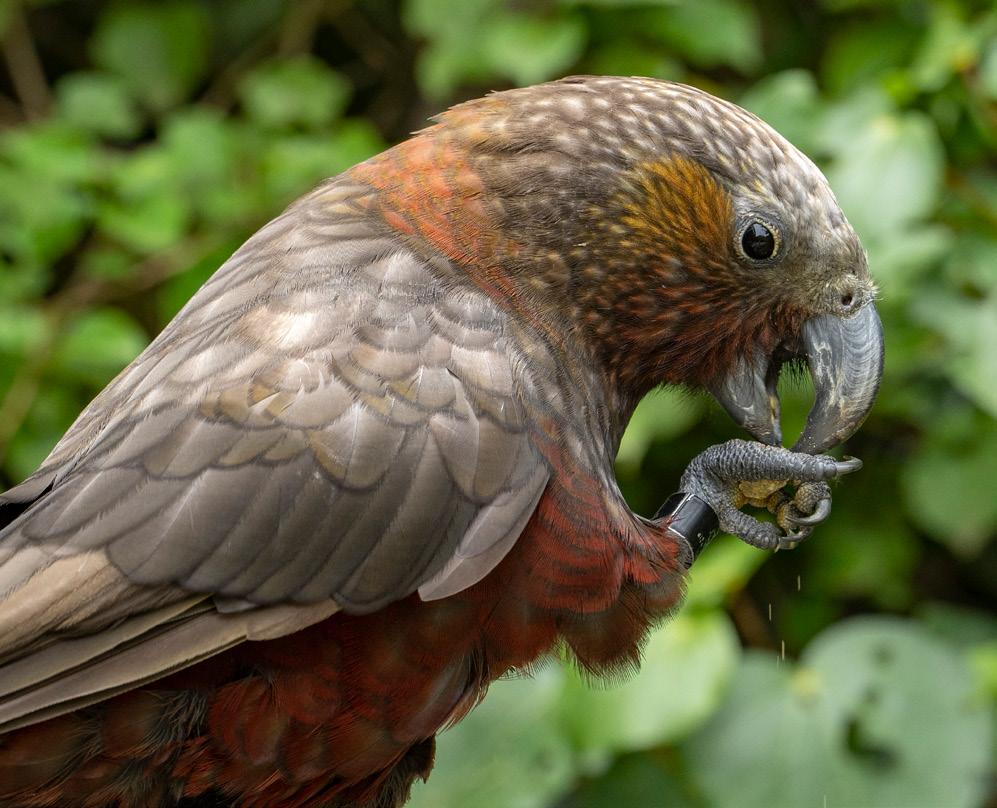
Dr Daria Erastova works for Forest & Bird as Te Hoiere Bat Recovery Project Manager. She was the main author of a recent study, the first of its kind in New Zealand, to determine how sugar-water feeding affects backyard bird communities.
 A leaf-eating kererū. Heidi Benson
Bathtime for one happy pīwakawaka fantail. John Nelson
A leaf-eating kererū. Heidi Benson
Bathtime for one happy pīwakawaka fantail. John Nelson
15 Winter 2023 |
Our kākā are partial to fruit. Glenn Turner
KEEPING WILD BIRDS “WILD”
Recently, there have been a number of comments on birding Facebook groups about keeping wild birds as “pets”. People have suggested young tūī can be kept and trained to talk, people have said they keep tauhou silvereye in cages, and there has been talk of native owls being kept as pets.
There have also been pictures of people feeding wild birds from the hand and handling them. Many people may not realise that doing these things is either illegal and/or not recommended for the health of the bird.
You cannot keep native and endemic birds captive on your property unless you are a licensed bird rehabilitator or kākāriki breeder. There are good reasons for this. We don’t want a market in caged birds, and they also have special dietary requirements if they are to recover and thrive.
If you find an injured native or endemic bird, take it to a licensed bird rehabilitator or vet. Aside from rescuing it, do not try to take care of it yourself or keep it as a pet – it is illegal to do so.

As explained on page 14, many birds have special dietary requirements that people do not know about or get completely wrong. I’ve recently seen people giving advice that is going to harm a bird, such as feeding honey to tūī and tauhou.
Feeding captive birds the wrong foods can result in permanent bone and feather deformities that lead to a quick death.
Last year, people were posting pictures of dead or sick birds in their garden on social media. One showed two tauhou silvereyes dead under an olive tree. They appeared uninjured, although they had fluffed up feathers. The photographer asked why this may have happened.
Fluffed up feathers are a common feature of birds with salmonella and diseases such as chlamydia. Feeding these birds the wrong foods, combined with poor hygiene, likely killed these birds.
Bread is absolute junk food for birds. It’s full of carbohydrates, yeast, and sugars and should never be fed to them.
Encouraging birds to feed from your hand is also a very poor practice. It leads to birds associating people with food, losing their fear of people and quickly becoming cat food!
It may be satisfying for us humans to feed birds by hand, but ultimately it’s not good for them. Please refrain from keeping or treating wild birds as pets. Let’s keep them wild, healthy, and alive.
Ian McLean is the Auckland Regional Representative for Birds New Zealand.
Feed tūī, bellbird, hihi, kākā, silvereye & more
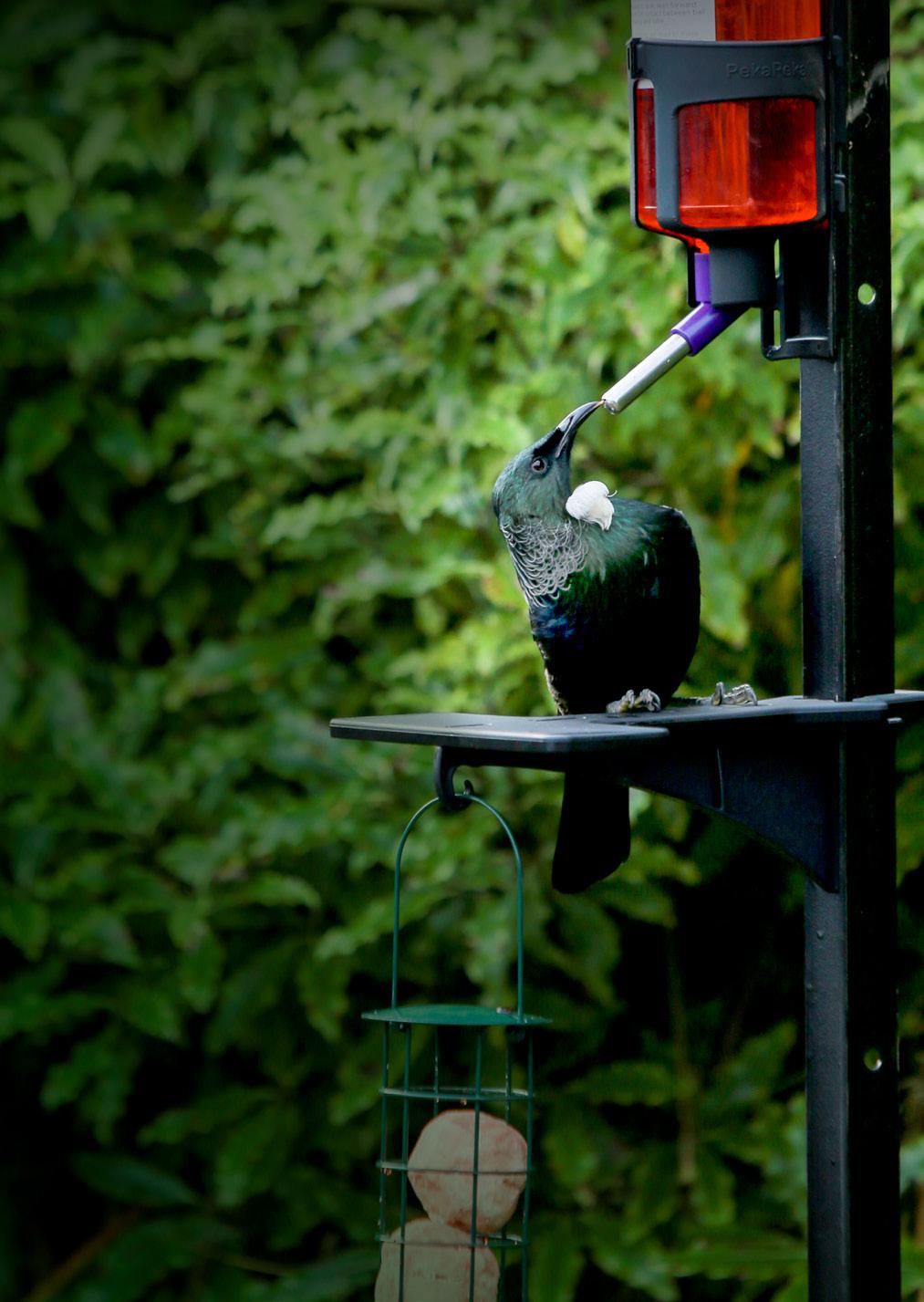
● Cat proof! 360 degrees of visibilty while birds feed
● Provides sugar water, fruit & energy truffles
● Feeder can go anywhere, it’s on a waratah
● Stainless steel nozzle ensures safe, hygienic feeding & easy cleaning to prevent the spread of avian pox.
Buy a feeder at PFNZ shop.predatorfreenz.org
For more info go to our website pekapekabirdfeeders.nz
Licensed bird rehabilitator Sabrina Luecht, of Kaikōura Wildlife Centre Trust, with injured ruru.
It is illegal to keep a wild bird as a pet, even if you have nursed an injured avian back to health, as Ian McLean explains.
COVER GARDEN SPECIAL REPORT
BIRDS
| Forest & Bird Te Reo o te Taiao 16
READY SET COUNT!
It’s time to get out the binoculars and bird books. This is your opportunity to brush up on your avian identification skills before the 17th annual New Zealand Garden Bird Survey begins.
TV producer Ian McGee, who hails from Dunedin, is one of thousands of New Zealanders planning to gather on decks, near windows, and under trees in gardens, parks, and school grounds across the country to count all the birds they can see and hear for one hour, on one day in the last week of June.

Ian started doing the survey in 2007 and says it’s become quite addictive.
“We get the regular flocks of silvereyes, but occasionally a rosella has turned up, which is always exciting,” he said.
“Once you’ve done the survey, you start noticing birds for weeks afterwards. It’s an entry step that really opens your eyes to a whole new world.”
If you are thinking of doing the survey but haven’t quite reached out for the tally sheet that is included with your June Forest & Bird magazine, Ian says don’t hold back, go for it.
“Grab a pair of binoculars and just sit and watch. You can look in the eyes of these birds and it’s not hard to imagine scales on them and travelling back in time 60 million years. You’re watching their dinosaur ancestors.”
More than 5400 new surveys were added from last year’s analysis to bring the total completed over the past 10 years to 44,357.
The information is analysed using supercomputers
to crunch all the data. Scientists can see whether birds were fed in the garden they were recorded in – and whether they are located in a rural or urban setting. The data also shows how many gardens have been surveyed in each region of the country.
The most recent analysis of the 2022 data showed positive signals emerging for four native species:
n A moderate increase over 10 years of kererū and pīwakawaka fantail counts.
n A continued shallow increase in tūī counts in the long and short-term, especially in Canterbury, Taranaki, and the West Coast.
n Little or no change in tauhou silvereye counts over the past five years, although overall they are still in a long-term shallow decline.

However, things are not looking so good for some introduced species. Numbers for tāringi starlings and pahirini chaffinch show a population decline for both species.
The trend of little or no change in myna counts continues nationally, except in Wellington, ManawatūWhanganui, and Taranaki where counts show an increase in bird numbers over both 10- and five-year periods.
Manaaki Whenua researcher Dr Angela Brandt says the data let us understand how bird populations are changing across Aotearoa New Zealand.
“What’s exciting about having so many years of surveys now is we can see how trends are changing over time,” she said. “The results give us an early warning if a species starts to decline.”
This year’s New Zealand Garden Bird Survey runs between 24 June and 2 July, and scientists need your help to find out how our feathered friends are doing. Kim Triegaardt
Ian McGee, of Dunedin, has completed 15 Garden Bird Surveys and is looking forward to this year’s event Sam McGee
→ 17 Winter 2023 |
Tauhou silvereye. Manaaki Whenua/Rob Osborne
Since 2021, Manaaki Whenua has also asked survey participants what more needs to be done to care for birds in New Zealand. Last year, there was overwhelming response for more to be done to manage predators and weeds.

Manaaki Whenua social researcher Dr Gradon Diprose says participants suggested a wide range of everyday actions people can take to reduce the impacts of weeds and predators on birds.

Not all participants agree on what should be done, but the responses highlight how many New Zealanders care both about birds and the wider environment.
And as Dunedin birder Ian McGee points out, you don’t have to go far to take notice.
“One of the things I worry about is that because kids are watching wildlife television programmes, they start to think that nature only happens in places like the Serengeti and other exotic places.
“But really all you need to do is stick your nose out of your window at home and sit and watch the birds come to you.”
The New Zealand Garden Bird survey runs from 24 June to 2 July 2023. You can find an easyto-use bird identification section at www.gardenbirdsurvey.nz, plus lots of other useful information. You can also submit your bird counts online instead of using a paper tally.
Kim Triegaardt is Senior Communications Advisor at Manaaki Whenua Landcare Research.

MAKE YOUR GARDEN BIRD FRIENDLY
If you want to keep wild birds flourishing in your garden, controlling introduced mammals is a must.
Stoats, rats, possums, and hedgehogs are common predators that kill and maim birds, eggs, and chicks in our backyards, in the city as well as rural areas.
Trapping is a simple measure you can do at home to make a difference. Predator Free New Zealand has a handy guide to choosing the right trap on its website – go to Bit.ly/3mLlRQ5
If you have a cat that goes outside, you can make it more bird friendly by fitting a bell on its collar, feeding it at regular times, and keeping it inside at night.
Bird feeding stations should
be over 1.7m high or hung from a sturdy branch to keep them out of the way of predators and pets. Why not try some of these measures and see what difference it makes to the birds visiting your garden? Maybe you can help bring back the dawn chorus to your neighbourhood.
For more tips on how to make your garden bird friendly, go to gardenbirdsurvey.nz/gardenfor-birds/
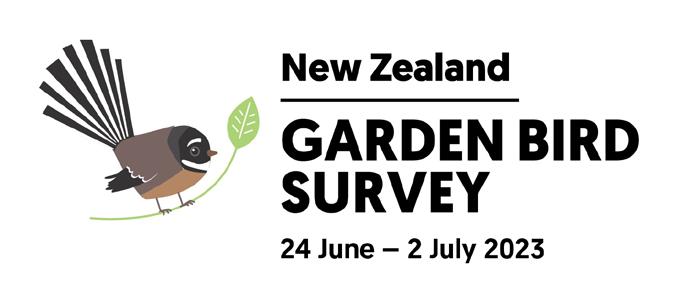
In your garden, school or local park Notice and connect with birds and nature Plant native species for fruit, foliage, and nectar Manage weeds and predators Provide supplementary feeding with care Get involved with community initiatives Add water Create
bird-friendly haven gardenbirdsurvey.nz Provide water Supported by:
a
Tūī. Manaaki Whenua/Mike Wilson
Dr Angela Brandt
Dr Gradon Diprose
COVER → | Forest & Bird Te Reo o te Taiao 18
FOR THE OF BIRDSLove
Forest & Bird has been battling for a better deal for native birds for the past 100 years. Here are some ways you can help us bring back a dawn chorus to every corner of Aotearoa New Zealand, including in your garden.
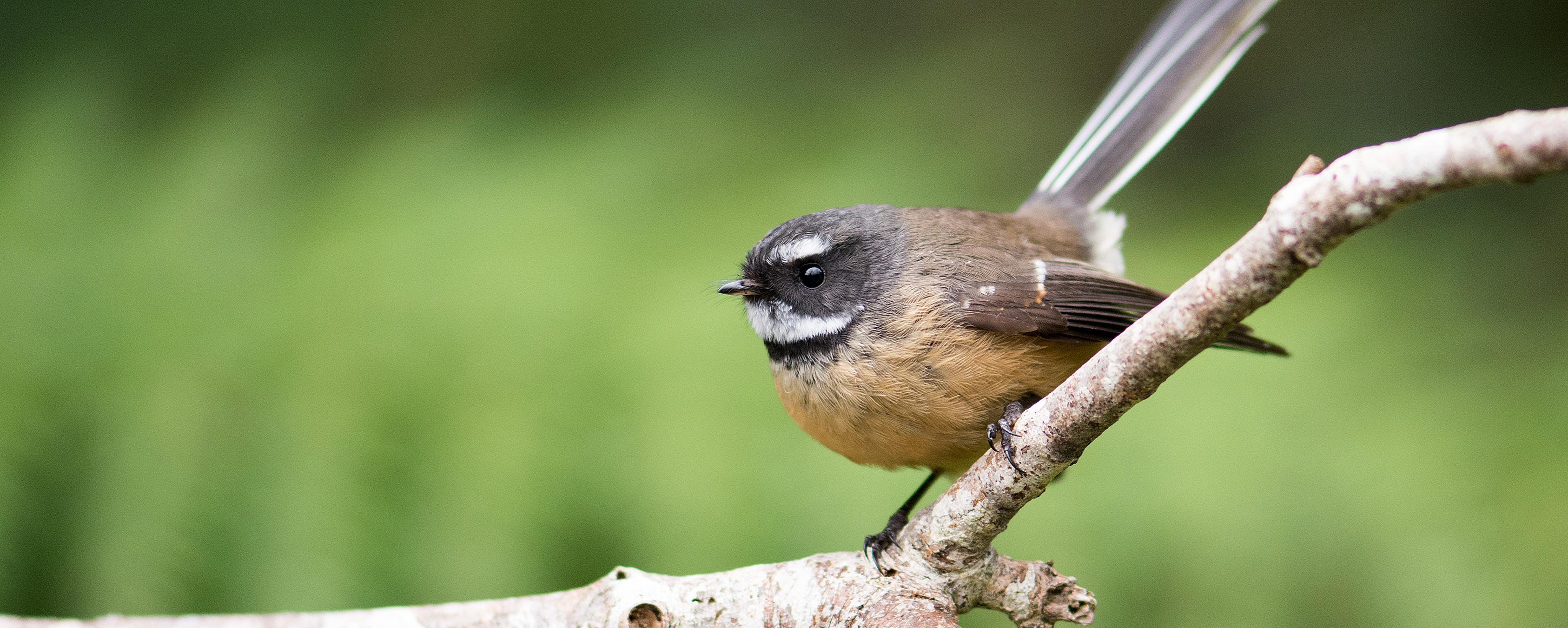
➊ Volunteer: Forest & Bird has more than 120 projects all over the country where conservation volunteers are working hard to reducing pest numbers in their neighbourhood. This mahi is helping return native birds, bats, lizards, and insects to areas where they once thrived. Volunteers are always welcome! You can find your local branch at www.forestandbird. org.nz.
➋ Donate a predator trap: Visit Give a Trap, a new Forest & Bird initiative that matches donors with community-run projects around the country. You can buy a predator trap on the Give a Trap website and have it delivered directly to your chosen project. Once the group receives your gift, they’ll put it to work and send you regular updates through our platform. Check it out at giveatrap.org.nz
➌ Join Forest & Bird or gift a membership to friends or whānau: Members can join their local branch and volunteer in a range of different ways and help return nature to their local community. Members also receive a complimentary Forest & Bird magazine subscription and access to Forest & Bird lodges and reserves. Go to www.forestandbird.org.nz/joinus
➍ Become a regular giver: We rely on donations, bequests, and grants to carry out our work. Setting up a regular donation is one of the most important things you can do to help restore nature in Aotearoa. If you are interested in becoming a Nature’s Future regular giver, please go to www.forestandbird. org.nz/support-us/become-regular-giver. If you already support us in this way, thank you!
NEW ZEALANDERS! PROTECT YOUR NATIVE BIRDS

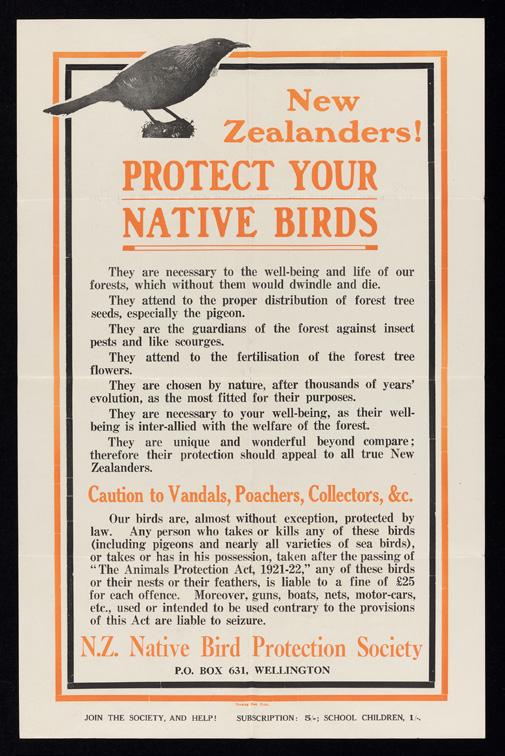
This was the title of the society’s first poster published in 1923. It was printed in different colours and and produced on paper, calico, and linen. The posters were very popular and were put up in 300 railway stations during 1923, while 2300 went into post offices. They were also seen at harbour wharves and yacht clubs, including around the Hauraki Gulf. They appeared in many schoolrooms around the country, including Native Schools, and Tararua Tramping Club displayed them in huts. The calico versions were displayed outside – for example, where forestry workers were felling trees to try to stop them shooting birds on their breaks. The Society’s early leadership claimed the posters resulted in an increase in bird populations in New Zealand’s forests.
A high-resolution version is available for branch use –email editor@forestandbird.org.nz
COVER
Pīwakawaka fantail. Jake Osborne/Flickr.com
The poster on display at Cape Kidnappers gannet colony, Hawke’s Bay, circa 1920s. Forest & Bird archives
19 Winter 2023 |
LISTEN TO THE LAND
Nature-based solutions can help heal the steep hillsides of East Cape and other weather-ravaged communities in Auckland and Hawke’s Bay. Ann

Cyclones Hale and Gabrielle unleashed devastation in Auckland, Hawke’s Bay, and the East Cape in January and February this year. It was a disaster waiting to happen, as Forest & Bird field officer Basil Graeme warned back in 1990.

He visited the Tairāwhiti Gisborne region following Cyclone Bola, in 1988, and saw for himself the erosion and destruction it had caused. He later wrote, in the November 1990 issue of the Society’s magazine, some prescient words:

“The seeds of destruction were laid in our pioneer culture which assigned too freely individual rights with property ownership. Today these rights are infringing the wider rights of the East Cape community … Today the East Cape waits exposed and unprepared for the next cyclone.”
And so it came to pass four decades later with not one but two cyclones only two months apart. What lessons can we learn from the response to Cyclone Bola in 1988 – and from decisions made around land use that go back even further, to the 1960s?
After Cyclone Bola, the government gave nearly $200m in a relief fund. It should
Graeme
have been used to buy out and retire the most severely damaged properties. Instead, it helped farmers reestablish grazing and enabled forestry companies to plant pines on the 240,000ha of category 2 and 3 (higher risk) erosion-prone land. It was a huge mistake.
Previously, in the 1960s, under the “East Coast Project”, the worst category 3 land had been retired and planted in pine trees, and these stood up relatively well during Cyclone Bola. But after Bola, these taxpayer-funded “conservation” forests were sold to private companies, felled, and replanted in pines.
Many of these forests are being clear-felled now, while the thin grass of the steep lands is still being grazed. This gave the land very little protection when the worst cyclones in living memory hit the East Cape earlier this year. Now the steep lands are an endless landscape of slips, and the downstream communities are full of mud and misery.
There are many victims in this story. There is the environment, the scarred hills, the lifeless streams choked with silt and slash, and the degraded coast beyond.
CLIMATE
Devastated farmland after Cyclone Bola. Forest & Bird archives
Basil Graeme in 1990. Forest & Bird Archives
| Forest & Bird Te Reo o te Taiao 20
Cyclone Bola aftermath: Motumate Stream, Kaitangata Station area, looking southwest towards Te Karaka on the Waipoua River. Lloyd Homer, Geological Survey. Published in Forest & Bird, November 1990
There are the people, Ngāti Porou hapū, the forestry workers whose incomes help sustain the East Coast communities, and the downstream farmers whose homes, paddocks, and orchards are deep in mud. And the forestry companies and hill country farmers, whose practices led to this debacle, are victims too.

We need to find a fair and sustainable way forward for them all. We must support all these communities, but, this time, we must do it in a way that offers the local people and the environment a more sustainable future.
To keep the lowlands safe, we need to protect their watershed, the steep lands behind them. The fragile hillsides of farmland and felled pines need a green cloak to shelter them from the hammering rain.
That cloak needs to be a permanent native forest, a carbon sink, protecting the soil from erosion, and the waterways and the sea from the smothering sediment. This will give the downstream hapū and communities the security they deserve.

If this is to be achieved, we need to recognise the most erodible land cannot support any further exploitation, be it for timber trees or for grazing. It must be fostered to regenerate into permanent native vegetation. But how can this be achieved on such a vast and damaged landscape?
Nature could provide a solution, but only if goats and deer are killed and stock removed. Among the thin grass, the naked slips, and pine stumps and slash, weeds will grow but so too will those native pioneers, mānuka and kānuka.
Beneath their canopy other native plants will find shelter and in time – a very long time – a native forest will grow. But for this to happen, nature must be given a helping hand. Vast areas of land need to be fenced, seeded, and weeded, and browsing pests controlled.
As for the established pine forests, many are already protecting soils and streams in the identified zones of instability. These trees must not be harvested! While they stand, they provide erosion control, sequester carbon, and shelter native species establishing beneath them.
But these solutions involve costs – enormous costs –and they deprive the landowners and the communities who depend on forestry and farming of their incomes. An alternative source of income for the landowners needs to be provided, and the Emissions Trading Scheme in its present form does not yet provide it.
These restoration actions required on the vast retired land could provide work and income. Some will need fencing. All will need ongoing pest control if goats, deer, pigs, and possums are not to undo the work of restoration.
On naked slips, planting and possibly aerial drone seeding of mānuka and kānuka will speed restoration. Forest workers might find work in fencing, pest control, planting, track cutting, and weed management. And, yes, pine trees might help (see box).
Big problems require big solutions, and the challenge of revegetating the East Cape is enormous. We must accept that, although the task lies on private land, its resolution will be a public good. We, the taxpayers, must take responsibility for this fragile landscape and its dependent communities.

It is time to value existing native forests, and the growing of native forests, as assets that pay their way in the carbon they store, the catchments they protect, and the downstream costs and damages they avert. The East Cape has been exploited for too long, and the time for restitution is now.
“Enough is enough!” says Basil Graeme, 81, who is still an active conservationist today. “Fix the Emissions Trading Scheme and provide a way out for farmers and foresters on the East Cape.”
Damage caused by Cyclone Gabrielle, Dartmoor Road, near Puketapu, Hawke’s Bay. Chantal Pagel
→
Papamoa Forest, Gisborne, is being restored with native planting, while controlling goats, deer, and possums has allowed natural bush regrowth. Barry Foster
21 Winter 2023 |
Forestry slash on Gisborne foreshore, in 2023. Barry Foster
TRANSITION FORESTS
On the most erosion-prone land where felling the existing pine forests is untenable, standing pines can be a pathway to restoring native forest. This has been given a catchy name, “transition forests”. Projects are under way, such as that being undertaken by Tāne’s Tree Trust, to find out what native plant regeneration can be achieved under pine tree stands and how their conversion can be encouraged with different environmental and planting conditions. Do they need to be thinned to help understorey growth, and can this occur without causing erosion? Will the planting of islands of missing and diverse native species speed up natural regeneration? Maybe pines themselves could be planted at wide spacing, not for timber, but to specifically act as a nurse crop to native regeneration.
WHO FOOTS THE BILL?
For the re-assigned workers, the government – that’s us taxpayers – would pay the wages. For the farmers, the Emissions Trading Scheme (ETS) could provide an incentive for destocking their pasture because the land will qualify for carbon credits. But for foresters, there is no incentive to leave their forests standing, as the ETS will not provide them with carbon credits if the first historical tree planting was before 1990. This is because the ETS is based on international rules aimed at stopping countries from cheating on their targets. This arbitrary date is intended to encourage new plantings on land deemed unsuitable for grazing, which is fine for East Cape farmers but disqualifies foresters who own older plantation forests, despite the carbon store they hold and the catchment protection they provide. In New Zealand, we need to reward the owners of forests that are protecting our climate, native habitats, and downstream communities. Parliament has a responsibility to fix this anomaly.
STOPPING FOREST SLASH
From the ravaged slopes, where pine trees were newly harvested, came the mountains of waste timber called slash, piled against bridges, smashed against fences, and strewn over beaches. It was often more visible than the silt and the mud, and has come to epitomise the damage caused by the cyclones. Fingers were pointed at demon pine trees, but it is not the pine trees in themselves that were at fault. It was the method of forestry. Any trees clear-felled in one go on those steep, erodible hills, leaving waste wood behind, would have led to disaster in similar circumstances. Under normal rain, this slash was expected to stay in place and act as a filter against sediment run-off. But “normal” should no longer be the expected.
ISLAND OF GREEN
The cyclones didn’t spare native habitats either. Native forests suffered, especially those riddled with pests, their undergrowth and the spongy moss on the forest floor eaten and stomped out by deer and goats. But one place welcomed the deluge. Gray’s Bush is a swamp forest on the Gisborne plains, the only surviving remnant of an extinct forest type, an assemblage dominated by kahikatea and pūriri. Surrounded by drained and cultivated paddocks, it struggles against drying out. For years, Forest & Bird’s Gisborne Branch has cared for the forest, by controlling pests and tackling invasive weeds. A few days after Cyclone Hale, Grant Vincent, chairman of the branch, went to see how the forest had fared. “It did my heart good to see,” he said. “Streams were running down the forest paths, ponding and creating little lakes around the kahikatea and the buttresses of the pukatea. The pūriri, less fond of puddles, stood on the slightly raised ground, well watered but not water-logged.” Days after the storm had passed, the forest floor was still soaking up the flood water, an island of green in a drowned landscape.

☛ “We lost 20 years of restoration planting” – read Dean and Geoff’s climate story on page 31.
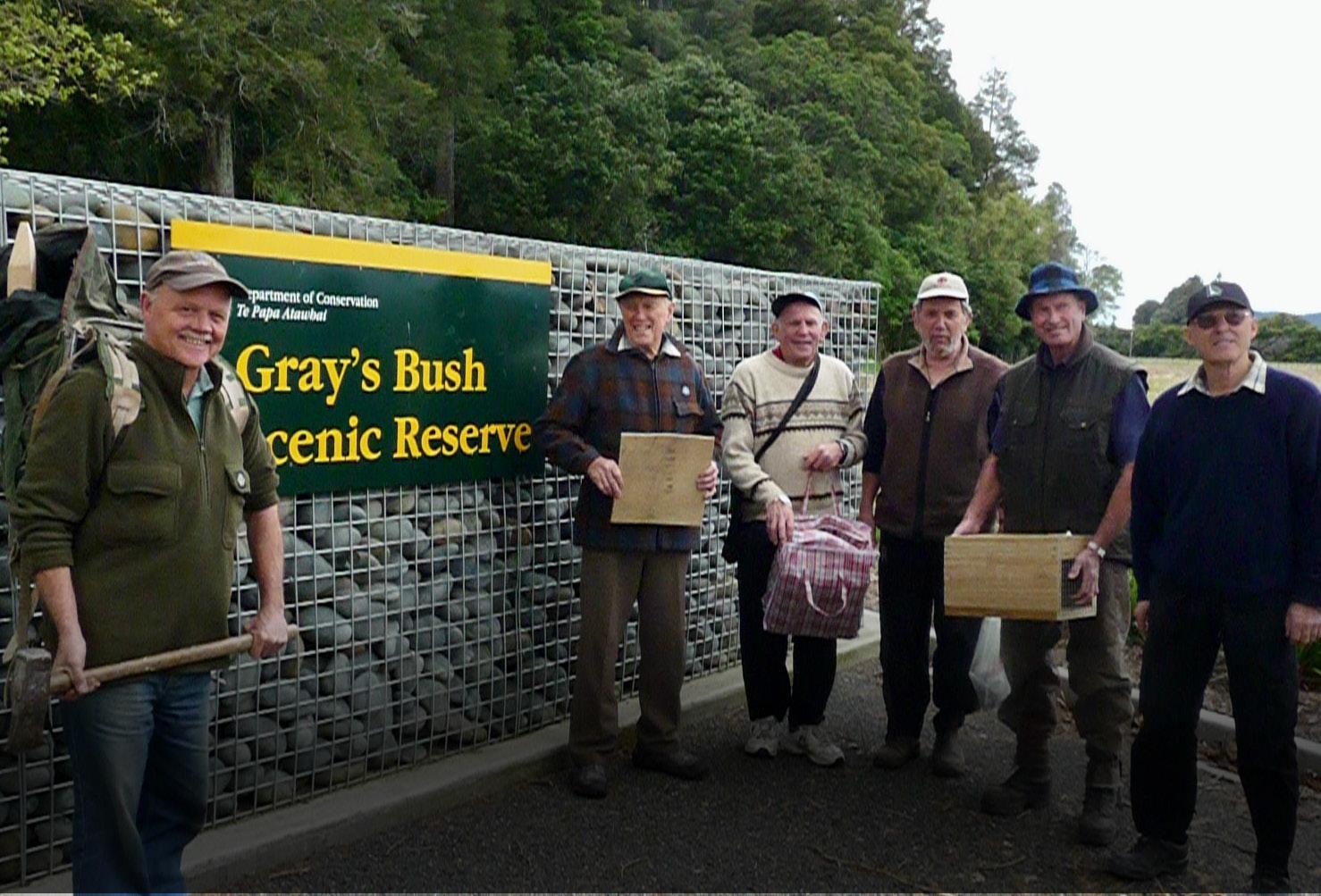
CLIMATE
Forest & Bird volunteers at Gray’s Bush, near Gisborne. Forest & Bird
→
| Forest & Bird Te Reo o te Taiao 22
Gray's Bush. David Lynn
The future won’t take care of itself
Earlier this year, we saw back-to-back flooding, slips, and devastation in Auckland, the Coromandel, Gisborne, and Hawke’s Bay.

We don’t wonder anymore if another extreme weather event might be coming. We know it’s coming. This is our country’s wakeup call, our turning point.
We must protect our wetlands, make room for our rivers throughout Aotearoa, and restore native forests with pest control to help stop slips on steep hillsides. This is how we fight climate change to safeguard tomorrow even as we build back today.
Forest & Bird’s freshwater advocate, Tom Kay, grew up in Te Matau a Māui Hawke’s Bay, and his family were impacted by Cyclone Gabrielle just as tens of thousands of others were.
“I wasn’t prepared for the physical and emotional destruction delivered by Cyclone Gabrielle even though I’ve worked in conservation for most of my working life and spent years learning about climate change and campaigning for action to prevent it,” said Tom.
“We can and must build our communities back better – and safer – by prioritising nature-based solutions, including restoring our
wetlands, river floodplains, and indigenous forests.”
At the end of March, Tom gave a presentation to Gisborne District Council imploring them to think about nature-based solutions as part of the region’s recovery plan. This was well received and covered in local media and on Radio NZ
In April, Tom and Dr Chantal Pagel, Forest & Bird’s regional manager for Hawke’s Bay, Gisborne, and Bay of Plenty, met with locals affected by the flooding during a visit to the region.
Tom also presented to Auckland Council, showing them how nature-based solutions could help Tāmaki Makaurau rebuild following January’s floods. This was well received by the council’s leadership.
At the time of writing, Tom and Forest & Bird’s regional conservation managers have advocated for nature-based solutions to more than 30 councils around the country –and given presentations at more than 14 community-based events. Meanwhile, Chantal is making submissions to local councils in her rohe setting out the case for including nature-based solutions in their Annual Plans. She is actively involved in the recovery plan consultation for the Hawke’s Bay. Our Northland conservation
manager Dean Baigent-Mercer is helping people nationally understand the benefits of healthy future forests. Controllling introduced browsers, for example, will stabilise steepsided forested slopes, helping them withstand storms.
Forest & Bird’s strategic advisor Geoff Keey is looking at how central government can help address some of the barriers councils are facing to implementing these kinds of nature-based solutions.
And advocate George Hobson is working on our general election campaign to encourage every political party to incorporate these policies into their manifestos.
Your donation today will help Forest & Bird advocate for naturebased solutions all over the country as we seek to engage with mayors, councillors, community leaders, government ministers, and local MPs in the run up to October’s general election.
Please give today. Aotearoa needs all of us to pitch in as we can. Every little bit helps – please donate at www.forestandbird.org. nz/climate-emergency
Together, we can protect and restore wetlands, make room for rivers throughout Aotearoa, and support healthy future forests. This is how we fight climate change.
 Tom Kay in front of Redclyffe Bridge, Hawke’s Bay. Chantal Pagel
Tom Kay in front of Redclyffe Bridge, Hawke’s Bay. Chantal Pagel
FUNDRAISING APPEAL
THIS IS HOW WE FIGHT CLIMATE CHANGE
Rob Suisted
CAN GENOMICS
SAVE HOIHO?
DNA data can give us tools to aid the recovery of yellow-eyed penguins on the Aotearoa mainland, but only a change in human behaviour can give them a fighting chance of avoiding extinction, as Jane Young explains.
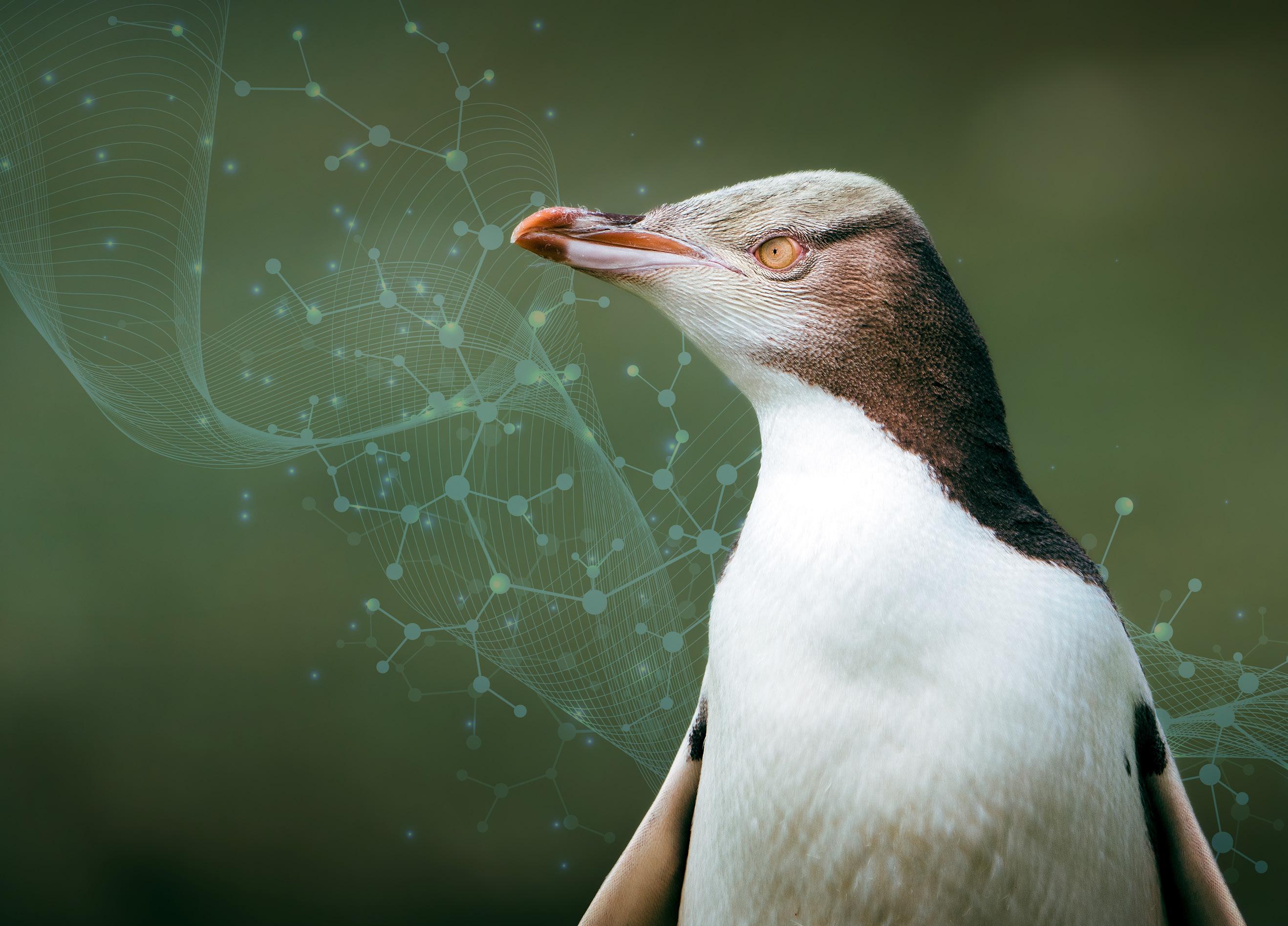
Hoiho are on the brink. During the last decade, despite increasingly desperate intervention measures, the number of mainland yellow-eyed penguins has plummeted by more than 70%, with no recovery in sight.
It’s possible, just possible, we can still avert a local extinction: Ban fishing in penguin foraging areas. Preserve and restore habitat. Protect penguins from disturbance by people, dogs and vehicles. And, most importantly, take action to reduce the long-term existential threat of climate disruption.
Genomic technologies also have a part to play in efforts to save hoiho. Genetic data provides vital information that conservation managers need in order to make wise decisions. And, more controversially, it might be possible to develop conservation techniques that involve direct manipulation of genetic material.
First, we can use genomics to better know a species – in this case, our iconic hoiho, proudly displayed on Aotearoa New Zealand’s $5 bill.
For a long time, we thought the yellow-eyed penguin Megadyptes antipodes was the only twig on its evolutionary branch. But, in 2009, researchers announced that ancient DNA analysis of fossil and archaeological bones in museum collections had led to a startling discovery.
There were actually two subspecies of M. antipodes – hoiho and the smaller Waitaha penguin. Then in 2015, researchers discovered a third “big diver” – Richdale’s penguin.
Humans arrived in Aotearoa sometime between 1250 and 1300CE, accompanied by kiore Pacific rats and kurī Polynesian dogs.
Within a few centuries, both Richdale’s penguin, which was restricted to the Chatham Islands, and the Waitaha penguin, found in the lower North Island and the South Island, had been driven to extinction.
Fossil and genetic evidence indicates that only hoiho survived, safe in its remote habitat in the Auckland and Campbell Islands.
Hoiho. Ross Mastrovich
FUTURE CONSERVATION
| Forest & Bird Te Reo o te Taiao 24
Conservation genomics aims to understand how the information encoded in complete sets of DNA (genomes) of living organisms can provide molecular tools for assessing their biodiversity, taxonomy, population demography, disease resistance, adaptation, and evolutionary history.
Despite their close evolutionary relationship, the three Megadyptes subspecies never got to be kissing cousins. Rare hoiho vagrants occasionally turned up far outside their normal range but didn’t establish breeding colonies.
Shortly after the Waitaha penguin disappeared, however, the advent of the Little Ice Age made the mainland a more attractive destination for the coldadapted hoiho. Within 50 years, it had taken possession of the vacant ecological niche.
Unfortunately, the limited number of founding individuals could be an Achilles heel for hoiho due to the resulting lack of genetic diversity, especially in genes that contribute to tolerance of high temperatures.
As the penguins now face an increasing number of stressors, the resultant population crashes further squeeze the genetic bottleneck and reduce the reservoir of potentially helpful variation.
There’s little hope that sub-Antarctic populations will come to the rescue. Not only is it a very long swim between the islands and the mainland, but hoiho are philopatric, meaning that when the juveniles come back from their big OE they usually return to the place where they fledged.
Consequently, the southern and northern populations are genetically distinct from each other, and there’s very little gene flow between them.
DEADLY PATHOGENS AND LIFE-SAVING VACCINES
Enormous efforts go into protecting the world’s most endangered penguin. Annual conferences bring together researchers and conservationists to share their war stories.
For a while, it appeared that the battle was being won, but since 2012 hoiho populations have been in free fall. Conference attendees have been heard to comment with dark humour that researchers will soon outnumber the penguins.
One of the main threats to hoiho, and one that will only increase as human-induced climate change really starts to bite, is the spread of a number of infectious diseases.
One of the worst of these is avian diphtheria. It’s a horrible disease in which the mouth becomes covered by bacterial plaques. Thick pus and painful ulcers prevent infected chicks from eating. Death from
starvation or sepsis frequently results.
Avian diphtheria may have first appeared in hoiho in 1999, but the pathogen responsible wasn’t identified until 2021, when researchers announced that they had isolated strains of Corynebacterium from the mouths of infected chicks.
With the aid of genome sequencing and the recently developed technique described as “matrix-assisted laser desorption ionization – time of flight mass spectrometry” (MALDI-TOF MS for short), these strains were shown to belong to a previously unknown species. A diagnostic genetic tool was then developed for rapid and reliable identification.
Although the new species had multiple virulence genes, it turned out to be less pathogenic than its relations. It’s an opportunist, deadly to young penguin chicks because their immune systems are underdeveloped.
However, there is a ray of hope. One of the bacteria’s virulence genes codes for a protein that is very effective in triggering a host response to infection so may be useful when developing a vaccine.
Respiratory distress syndrome, an even more lethal condition, emerged in 2019. During the following season, more than 90% of the young chicks affected died within a few days, either on the nest or in Dunedin Wildlife Hospital, where they were taken for intensive treatment. On necroscopy, their lungs appeared dark pink to purple, full of haemorrhages and clots.

High-throughput sequencing technology showed the presence of a novel gyrovirus in 80% of the samples taken from infected birds. Gyroviruses are known to cause serious diseases in some bird species, so this new one is a possible culprit.
There are vaccines against strains that attack chickens, but developing a similar one for penguins is likely to be a long way down the track.
Vet Lisa Argilla treats a sick penguin at Dunedin Wildlife Hospital in 2016. Yellow-Eyed Penguin Trust
→ 25 Winter 2023 |
INTELLIGENCE GATHERING FOR PEST CONTROL
Genomic technology has enormous potential for intelligence gathering in the campaign to eradicate the introduced predators threatening hoiho and other native species.
For instance, when a single stoat was trapped following a mustelid eradication programme on Rangitoto Island, DNA evidence showed it wasn’t a survivor of the original population but had made a marathon 3km swim from the mainland. When dogs attack penguins, genetic profiling, which was originally developed for human forensics, could enable identification of an individual suspect. It can also indicate the species of predator involved.
In January 2020, three hoiho chicks at Katiki Point, Otago, were killed by mustelids, possibly ferrets, and Moeraki-based Penguin Rescue staff made the difficult decision to take all the remaining hoiho chicks into protective custody.
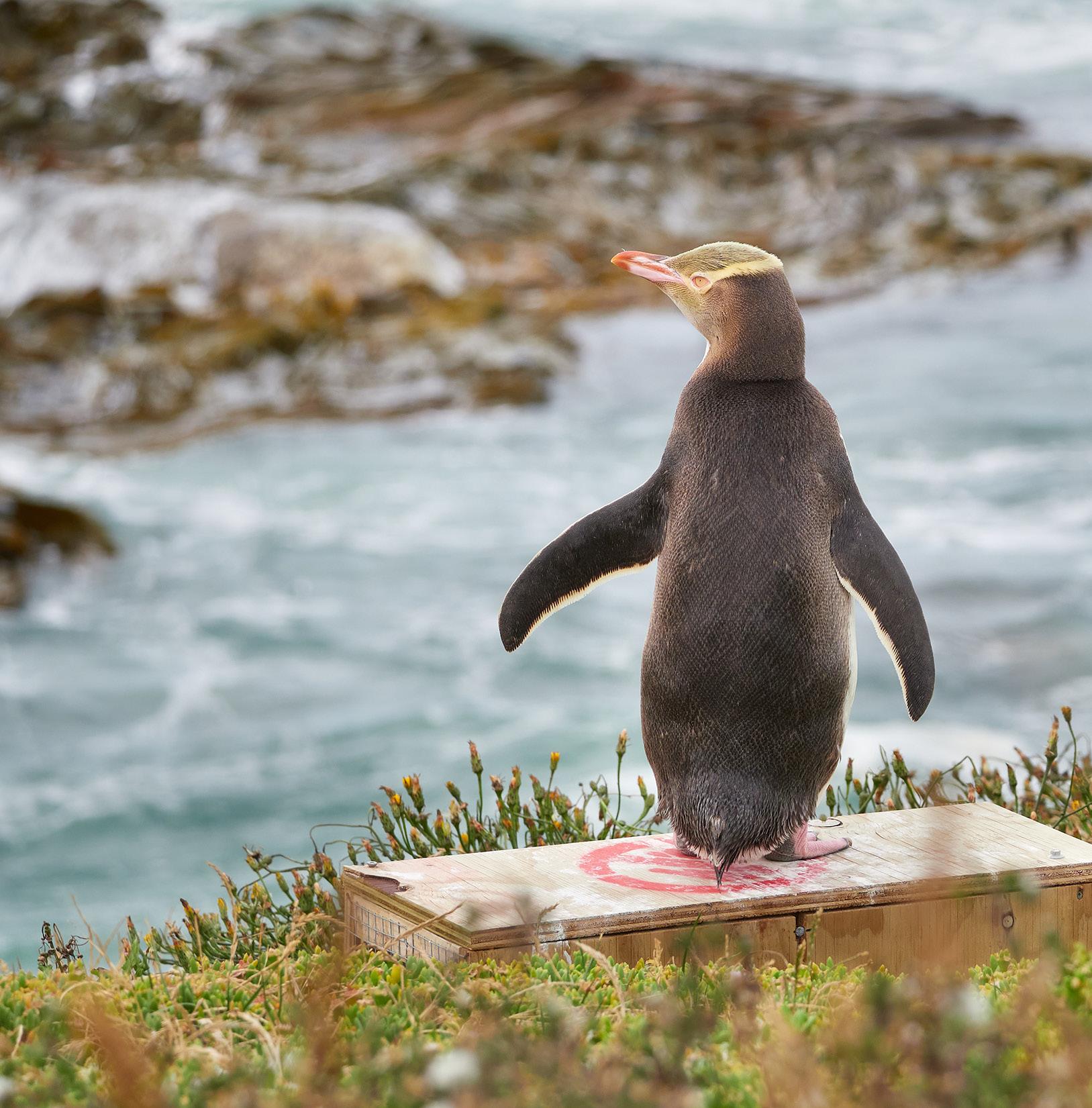
The culprits – ferrets – were eventually caught but not until after a change in the trapping strategy. Ready access to affordable DNA testing might have determined much sooner whether ferrets rather than stoats were to blame and also whether the trapped individuals had been the ones that killed the chicks.
In recent years, environmental DNA (eDNA) testing has come to the fore. It can be used to sample soil, water, air, or even faeces, and test simultaneously for
the presence of hundreds of different kinds of living organisms.
This big-picture technique doesn’t provide information about individual organisms and can’t yet tell us the sizes of the populations present, but scientists are working on it.
An Otago University lab is also developing a sampling technique along the lines of a RAT test – but testing for actual rats rather than for Covid.
Knowledge is key. Take mustelids. New Zealand scientists led a project that sequenced the 2.4 billion base pair stoat genome, which turned out to have about 20,000 protein-coding genes.
Stoats are closely related to ferrets, which are widely used in medical research, so knowledge gained from ferret studies can help make sense of the stoat genome.
Manaaki Whenua researchers are using genomemining techniques to help them design toxins that will be more selective and more humane.
PUSHING THE BOUNDARIES: GENETIC EDITING

So far, so uncontroversial. Now we get to the tricky stuff. Could or should genetic modification, gene editing, or gene drives get in on the act?
Research relevant to New Zealand looks at how genomic technologies could reduce predator fertility. The problem is that because of the way inheritance works, any new edited gene introduced into a population is likely to be swamped by the standard version within a few generations.
But there’s a cunning plan. If you can cheat by making sure that only the mutant gene gets passed on to the next generation, then the transmission of the normal gene may quickly come to a shuddering halt. This is what gene drives are all about.
Hoiho standing on predator trap box. Jeremy Sanson
FUTURE CONSERVATION → | Forest & Bird Te Reo o te Taiao 26
Genetic editing and gene drives are controversial but have the power to be game-changing if done right. Depositphotos
Natural gene drive systems have been around for a very long time. For instance, there’s one found in a species of mosquito that causes most of the offspring to be male.
Human use of gene drives, however, is still in its barest infancy and comes with lots of questions that will need to be answered when weighing up the potential risks and benefits.
How can we slow down the evolution of resistance to gene drives? Could the gene drive escape and wipe out a non-target population? How can you stop a gene drive once you’ve let it loose? If you squelch the population of one species, what will be the effect on others in the ecosystem? And so on.
The aim isn’t always to exterminate unwelcome species. Take mosquitoes. Yes, they’re a pesky biting nuisance, but the main problem is that they carry diseases that impact both humans and wildlife. In the 2018/19 season, at least 29 hoiho died from avian malaria spread by mosquitos.


Overseas researchers are looking at the use of gene drives, not necessarily to eliminate mosquitoes, which are important parts of natural ecosystems, but to modify certain species so that they can no longer host the parasite that causes human malaria.
Perhaps one day New Zealand scientists will be able to piggyback on this research and reduce the ability of our native and introduced mosquito species to transmit avian malaria. But it won’t be simple. It won’t be quick. And it certainly won’t be cheap.



As hoiho stare down the barrel of extinction, genomics can give us tools to use in their conservation management. What technology can’t do is provide miracle solutions.

It can’t weigh up the moral and ethical factors that must be involved in decision-making. And, sadly, it can’t change the indifference of so many people.

Quite possibly, it’s too late to save hoiho. But it’s some comfort to know that thousands of New Zealanders believe it’s not too late to try.
BOOK GIVEAWAY
We are giving away two copies of Genomes at Work: Tackling Environmental Problems in Aotearoa New Zealand by Jane Young (Triple Helix, RRP $44). This important book explores the ways in which the information coded in the genomes of all living things can provide tools to help us deal with biodiversity loss, environmental degradation, and climate disruption. To enter, email your entry to draw@forestandbird.org.nz, put GENOMES in the subject line, and include your name and address in the email. Or write your name and address on the back of an envelope and post to GENOMES draw, Forest & Bird, PO Box 631, Wellington 6140. Entries close 1 August 2023.

Jane Young is a science educator, editor, and freelance writer with a number books under her belt, including Pet Genetics: How bulldogs got flat faces and Manx cats lost their tails. She co-chairs Forest & Bird’s South Otago Branch and escapes from the computer by working in the native plant nursery that she and her husband established in the Catlins. Jane would like to thank Nic Rawlence, Bruce McKinlay, and Rosalie Goldsworthy for reviewing this article.
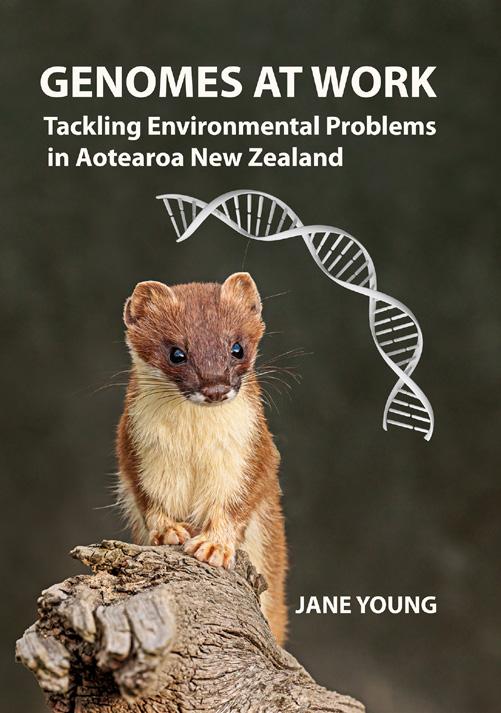
27 Winter 2023 | tours@NTBirdSpecialists.com.au | +61 (0)421 651 122 Full calendar & tailored itineraries at www.NTBirdSpecialists.com.au SPACES LIMITED Please book early & join wait lists World-Class Birding Experiences, Local Expertise • 5 Star Reviews • Luxury vehicles • 37 years professional experience • Unique original itineraries • Target species missions • Private cruises & access • Fully accredited & permitted operators Join renowned expert guide Luke Paterson on award-winning birding & photographic tours in northern Australia, Sri Lanka & Borneo.
Birding & Photographic Safaris
NT Bird Specialists
Darwin
Gouldian Finch photographed by Luke Paterson
LET’S TALK ABOUT CRITTERS AND WIKINERDS
Behind the easy-going rapport of Jesse and Nicola, Critter of the Week is a hive of activity. A researcher is trying to find interesting information about this week’s species, scientists are being grilled about their pet projects, photos are donated from amateur naturalists, and volunteer Wikipedians are working furiously to make sure each critter has a decent online article in time for Friday’s show.
Back in April 2015, I was the natural history curator at Whanganui Regional Museum and was interviewed by Jesse Mulligan about the lack of funding for the unattractive, obscure endangered species of Aotearoa compared with kākāpō and takahē.
This might have planted a seed. Later that year, Jesse was interviewing Nicola Toki about corporate sponsorship of bird conservation and was plainly frustrated: “But what about the earwig?” he demanded.
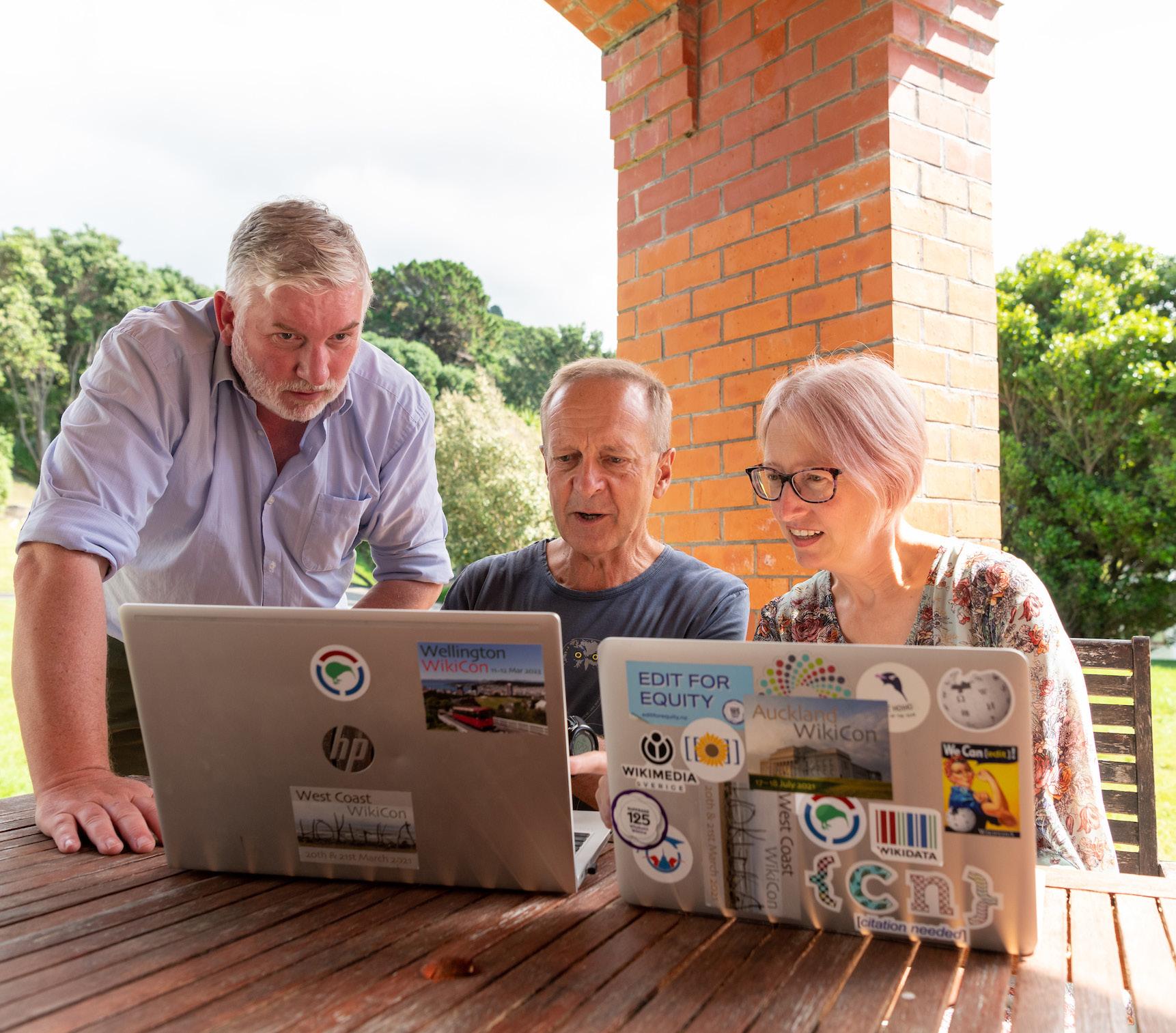
Nicola, perked up, went off-script: instead of kiwi and takahē, she said, they should be talking about the robust grasshopper! Or the long-jawed galaxias! Smeagol the gravel maggot! And so Critter of the Week was born on 2 October 2015.
Today, researcher Lily Duval has the tough job of finding and researching a new critter each week, and there are gentle arguments behind the scenes: Is this bird too charismatic for the show? Have we already covered this? Luckily, this is easily checked as volunteers maintain a huge Wikipedia list of every species mentioned on Critter and when it aired.
It’s Friday afternoon, and radio host Jesse Mulligan is contemplating a fungus beetle. “I’m going to ask you, Nicola, to rate the attractiveness of this beetle on a scale of one to 10.”
Nicola Toki pauses. “On the basis that it looks like salted caramel chocolate, I’m going to bump it up to a four.” And another episode of Critter of the Week on RNZ Afternoons draws to a close.
Every week since 2015, Jesse and Nicola have discussed a different New Zealand species on the radio, paying special attention to our obscure and overlooked flora and fauna. Every critter – animal, plant, or fungus – is scored by attractiveness (some get very low scores indeed), and more than 300 have had their 15 minutes of fame.
Nicola, who started as DOC’s Threatened Species Ambassador and is now head of Forest & Bird, champions species that are little known, often critically endangered, and aren’t the target of nature documentaries or corporate sponsorships. No bank or dairy company is going to fund saving the Open Bay Islands land leech.
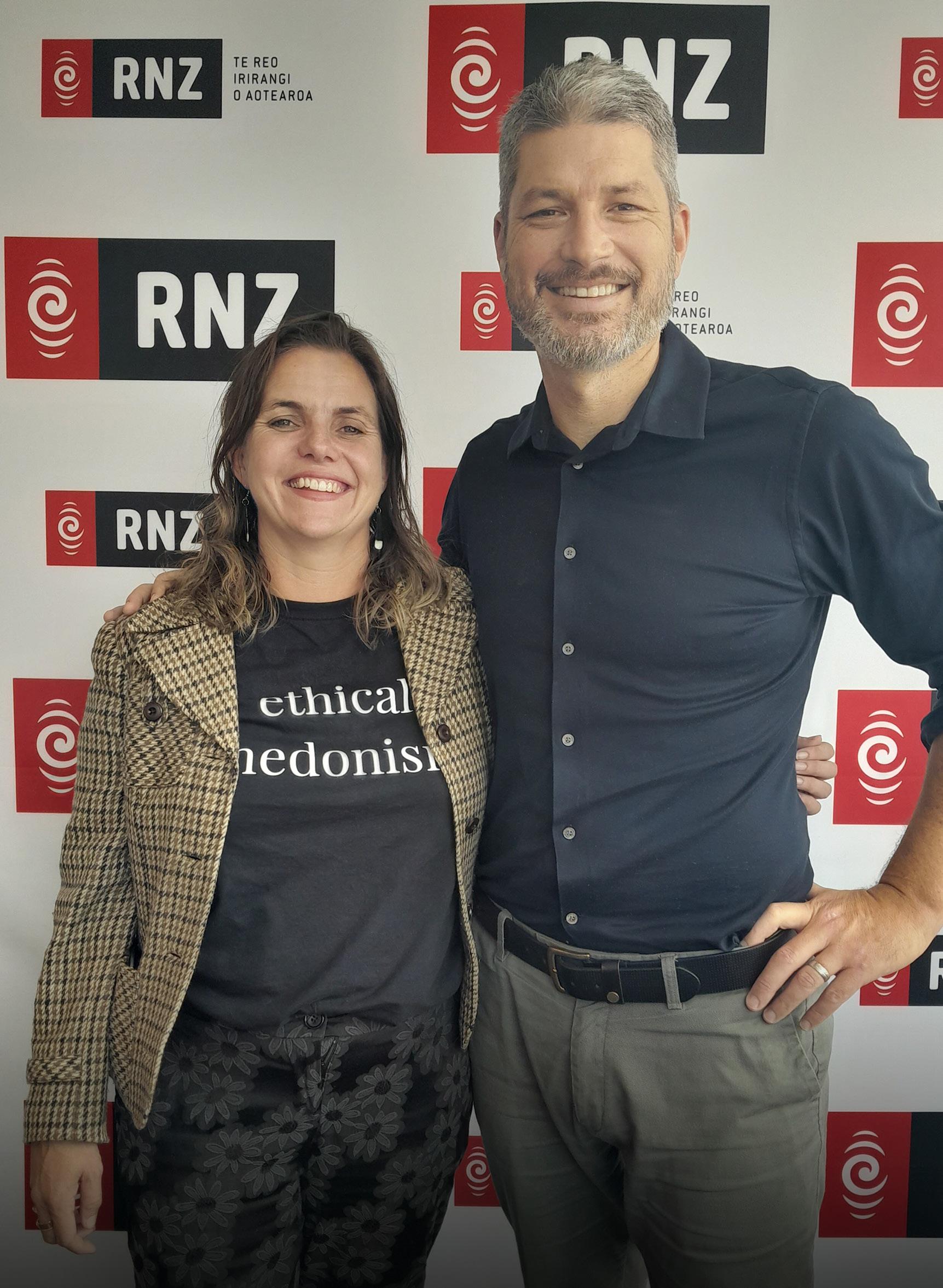 Nicola Toki and Jesse Mulligan in the studio for Friday’s Critter of the Week.
Critter of the Week editors Mike Dickison, Marshall Clark, and Tamsin Braisher collaborate on the strap-toothed whale article at Wellington Wikicon, in March 2023 Stephen A’Court
Nicola Toki and Jesse Mulligan in the studio for Friday’s Critter of the Week.
Critter of the Week editors Mike Dickison, Marshall Clark, and Tamsin Braisher collaborate on the strap-toothed whale article at Wellington Wikicon, in March 2023 Stephen A’Court
Meet the team behind the hugely popular Critter of the Week show and some of the gnarly creatures it has highlighted. Mike Dickison
BIODVERSITY | Forest & Bird Te Reo o te Taiao 28
Back in 2015, I was a big fan of the show but noticed some of these critters were very obscure, so obscure there was almost nothing about them online. If someone was intrigued by the twin-sailed salp or giant wētā fungus and searched for more information, they might find a very sketchy Wikipedia article or none at all.
As a volunteer Wikipedia editor at the time, I started trying to improve the article about each week’s critter –adding references, expanding the conservation status, and linking to the radio show.
All the content in Wikipedia is freely licensed so anyone can use it for any purpose, including the photos. But in New Zealand everyone’s photos are copyrighted All Rights Reserved by default.

I spent a lot of time persuading people to donate a photo to the public domain, under an open licence, so there would be at least one photo of each species that Wikipedia could use for the Critter articles.
For example, Chrissie Painting is an ecologist who has worked on the bizarre giraffe weevil – a species whose males have enormously elongated snouts.
She donated some lovely photographs of males jousting over mates from her field work, fact-checked the Wikipedia article, and left detailed notes and references on the article’s Talk page, something most experts have no idea they can do.
Creating or improving articles each week became addictive, and I learned a huge amount in the process. For example, every living Mercury Island tusked wētā is descended from a male and two females that were rescued and bred in captivity just before they went extinct in the wild.
The Mercury Islands were repopulated with tusked wētā, and the species was saved – a conservation success story but one most people had never heard of until Nicola and Jesse talked about it on Critter of the Week.

I began recruiting a team of Wikipedia volunteers to help share the load, and now every week the dozen people on Team Critter – affectionately dubbed “the wikinerds” by Jesse – get an email the day before the show airs, with a list of article improvements to make.

If there’s no article at all, we scramble to make one. Sometimes, to our dismay, Nicola decides she’ll talk about an entire group, such as cicadas (39 species in New Zealand!). All of which, after much work, now have at least a basic article.
Meanwhile, Critter of the Week has gone from strength to strength. The show regularly draws 100,000 listeners.
Cartoonist Giselle Clarkson was adopted as unofficial artist, and each year she creates Critter
Female Lasiorhynchus barbicornis NZ giraffe weevil Christina Painting
T-shirts and tea towels. There’s also been a Knit-aCritter competition and the Great Critter Bake-Off.
→ 29 Winter 2023 |
The 2022 Critter of the Week t-shirt designed by Giselle Clarkson.
Nicola also maintains the show has also been good for Forest & Bird: “It gets me out of trouble when I have difficult meetings with stakeholders,” she explains. “Someone will say ‘We’re really annoyed about your stance on this issue (grumble, grumble) but we do love to listen to Critter of the Week.’”
So far, the show has covered almost all New Zealand’s freshwater fishes and most of the lesserknown birds. But advances in molecular biology mean we know lizard species are being discovered faster than they can be featured on the show.

With insects, Jesse and Nicola have barely scratched the surface. They’ve tackled a few of our many species of endangered forget-me-nots, four lichens, two slime moulds, and a single liverwort, leech, centipede, and millipede.

A volunteer might suggest the show cover an obscure liverwort, but do botanists know anything this species – enough for Nicola to talk about it for 15 minutes? For thousands of New Zealand species, all we know is just a Latin name and where they’ve been collected, and thousands more don’t even have that.
So there’s plenty of space for the forgotten species of New Zealand to have their time in the spotlight, at least for another 300 episodes.
Mike Dickison was Curator of Natural History at Whanganui Regional Museum before becoming New Zealand Wikipedian-at-Large in 2018. Since then, he has worked as a Wikipedia consultant for Otago University, Te Papa, NZ Opera, and the Dodd Walls Centre.
HOW CAN YOU HELP?
n Become a volunteer Wikipedia editor and help improve articles about New Zealand’s natural history each week. You could link each article to its RNZ Critter episode, add better photos, or expand the text using published sources. If you like writing and library research, there are plenty of jobs to do!

n Donate high-quality photos to Wikipedia – it needs plant, insect, or bird photographers willing to donate some of their images to the public domain. Your photo could end up being used all over the world, and it’s a great way to showcase Aotearoa New Zealand’s unique flora and fauna.
If you’re keen to sign up to Team Critter or want to know more, go to Bit.ly/crittersignup.
→ BIODVERSITY
Mercury Islands tusked wētā Motuweta isolate. Chris Winks
The basking shark Cetorhinus maximus was featured on the show in 2020 Greg Skomal
Nicola and Jesse with some of the Knit-a-Critter competition entries.
| Forest & Bird Te Reo o te Taiao 30
ON THE FRONTLINE
A huge landslide wiped out 20 years of restoration planting, but Dean and Geoff are determined to rebuild their urban “native forest”. Zoë Brown
Discovering their beloved coastal forest had collapsed into the sea amid a record-breaking deluge is not how Dean Sutcliffe and partner Geoff Williams had intended to spend their Auckland Anniversary holiday weekend.
The long-term Forest & Bird supporters arrived home from work on Friday, 27 January to find a large portion of their backyard had collapsed. What had been a flourishing native ecosystem, brimming with pōhutukawa, karaka, and kohekohe, had turned into an exposed cliff face.

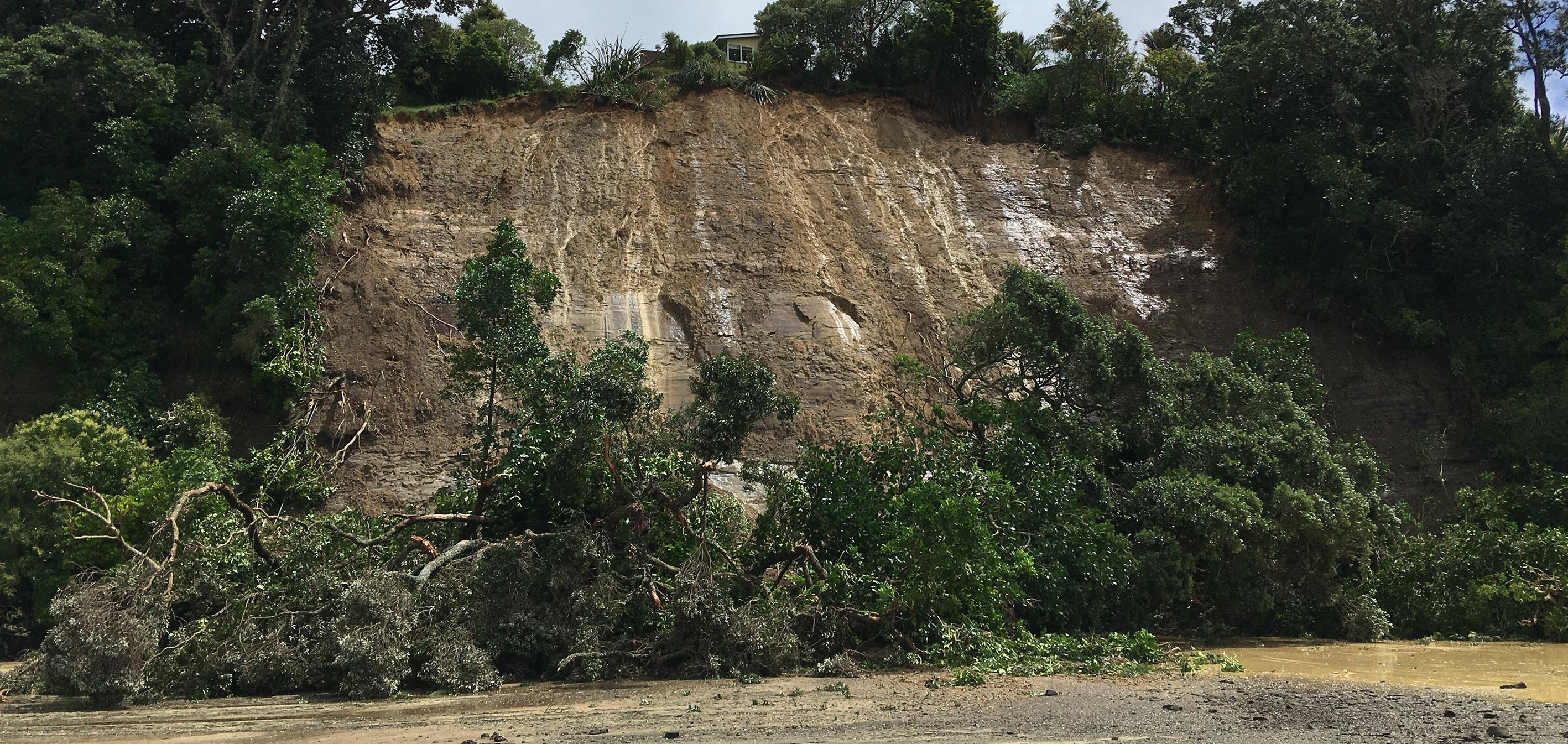
said Dean, who is a Professor of Music at Auckland University.
“We’ve speculated at length about what [the slip] might have looked like,” added Geoff. “I suspect the whole thing just went in one big hit. It carried the whole slope, with all the plants, in one huge cascade.”
Dean and Geoff, who is a research chemist, volunteer with the Motutapu Restoration Trust and are passionate about planting natives.
Twenty years of mahi, including careful pest control and persistent weeding, meant their property became a haven for native wildlife. Luckily, their house and the remaining land, which used to belong to Dean’s parents, remained intact following the landslide.
An epic 24.5cm of rain bucketed down on Auckland in the course of 24 hours during the January storm – the equivalent of about four months’ of rain in a typical year.
“Climate change is an absolute reality, and this is another demonstration,” said Geoff. “Seeing the damage to neighbouring properties and across the city brings it into sharp relief.”
Despite the loss, Geoff and Dean have their sights firmly fixed on restoring and stabilising what is left. They are planning to use native colonisers that in time will give way to natural coastal vegetation.
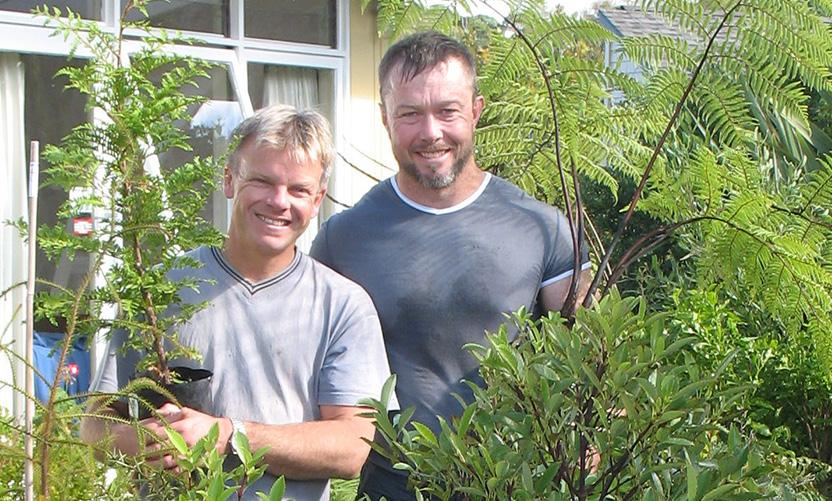
“For us, it’s about trying to make the most out of the situation that we have and continuing to try to be positive and upbeat,” says Geoff. “We accept the way we’re going about the restoration will be long term and probably beyond our own lifetimes.
“We will lay the foundations and let nature continue the process. We feel very strongly people can make a difference. This work will be for future generations to enjoy.”
Their painstakingly restored coastal forest, along with precious layers of topsoil, had plummeted from their Hillsborough home into Manukau Harbour. Pīwakawaka fantails, tūī, and riroriro grey warblers were among the bird species that nested in those trees.
“It is still a bit hard to get my head around. It just vanished like that. It’s pretty clear it all went in a big rush,”

CLIMATE
BEFORE: Dean and Geoff’s garden, with the four metal artworks left.
AFTER: Half the garden disappeared down the cliff and into the ocean.
31 Winter 2023 |
After the landslide, with Dean and Geoff's house above. Geoff Williams
REWILDING
RIFLEMEN
In late April, Forest & Bird’s Bushy Park Tarapuruhi, near Whanganui, welcomed its newest residents, an ancient species of wren only found only in Aotearoa New Zealand.
Mana whenua refer to titipounamu rifleman as “messengers to the gods” – specifically Tāne, God of the Forest. The tiny birds have a high-pitched buzzing call at a frequency many people cannot hear.
A total of 60 titipounamu were returned to Bushy Park, in a hapū-to-hāpu translocation to a sanctuary made safe by Bushy Park Tarapuruhi conservation volunteers.

The green-mantled birds – about the size of a golf ball – immediately set about exploring their new home and could be seen flitting about the restored forest canopy.
“Providing a home for these wee birds has required a careful and concerted effort by many partners and experts,” said Forest & Bird’s chief executive Nicola Toki, who attended the translocation.
“We’re extremely grateful for the support we’ve received to make this hapū-to-hapū project a reality, as we welcome these special ambassadors from Taranaki to their new home.”
The fenced predator-free sanctuary is a partnership between Forest & Bird, the Bushy Park Trust, and members of local iwi Ngaa Rauru Kiitahi, including
Tamahereroto, Ngāti Pukeko, and Ngāti Maika hapū.
The translocation took place thanks to the generosity of Taranaki Maunga hapū (Puketapu, Pukerangiora, and Ngāti Tawhirikura, all of Te Atiawa iwi), who gifted the birds to Bushy Park and gave each one a name.

It’s the second time titipounamu have been moved from Taranaki Maunga in recent years to help establish a population elsewhere, said kuia Kura Niwa, of Pukerangiora hapū.
“A decade ago, we would never have thought we’d be leading a process of taurima adoption for manu, so we are thrilled our titipounamu population is doing so well that we are able to undertake this tikanga,” she said.
“We look forward to connecting more with our whānau Ngaa Rauru Kiitahi and seeing how the manu go in their new kāinga home.”
A 12-person capture team moved the birds in small groups over several days from a source site at Project Mounga, on Mount Taranaki, and released into their new home at Bushy Park Tarapuruhi.
“Kaupapa such as manu translocations gives us a common purpose to work together and achieve,” said Danny Broughton, of Ngaa Rauru Kiitahi.
“A kaupapa that requires respect of culture, processes, and above all the best for the manu and ultimately our ngāhere.”
The project was led by translocation specialist Kevin Parker, of Parker Conservation.
“Catching is always weather dependent as we cannot work in rain or high wind, and this week has been no
FOREST & BIRD PROJECT
Translocation specialist Kevin Parker releases a titipounamu with (from left) Kura Niwa, Cordelle Rei, Sarah Mako, Yvette McGregor, and Danny Broughton. Jacqui McGowan
Nicola Toki and Mandy Brooke
Returning titipounamu to Bushy Park Tarapuruhi was a labour of love, with many working together to provide a safe new home for this tiny taonga.
| Forest & Bird Te Reo o te Taiao 32
exception,” he said. “Our top priority, as always, is to minimise stress on these birds.”
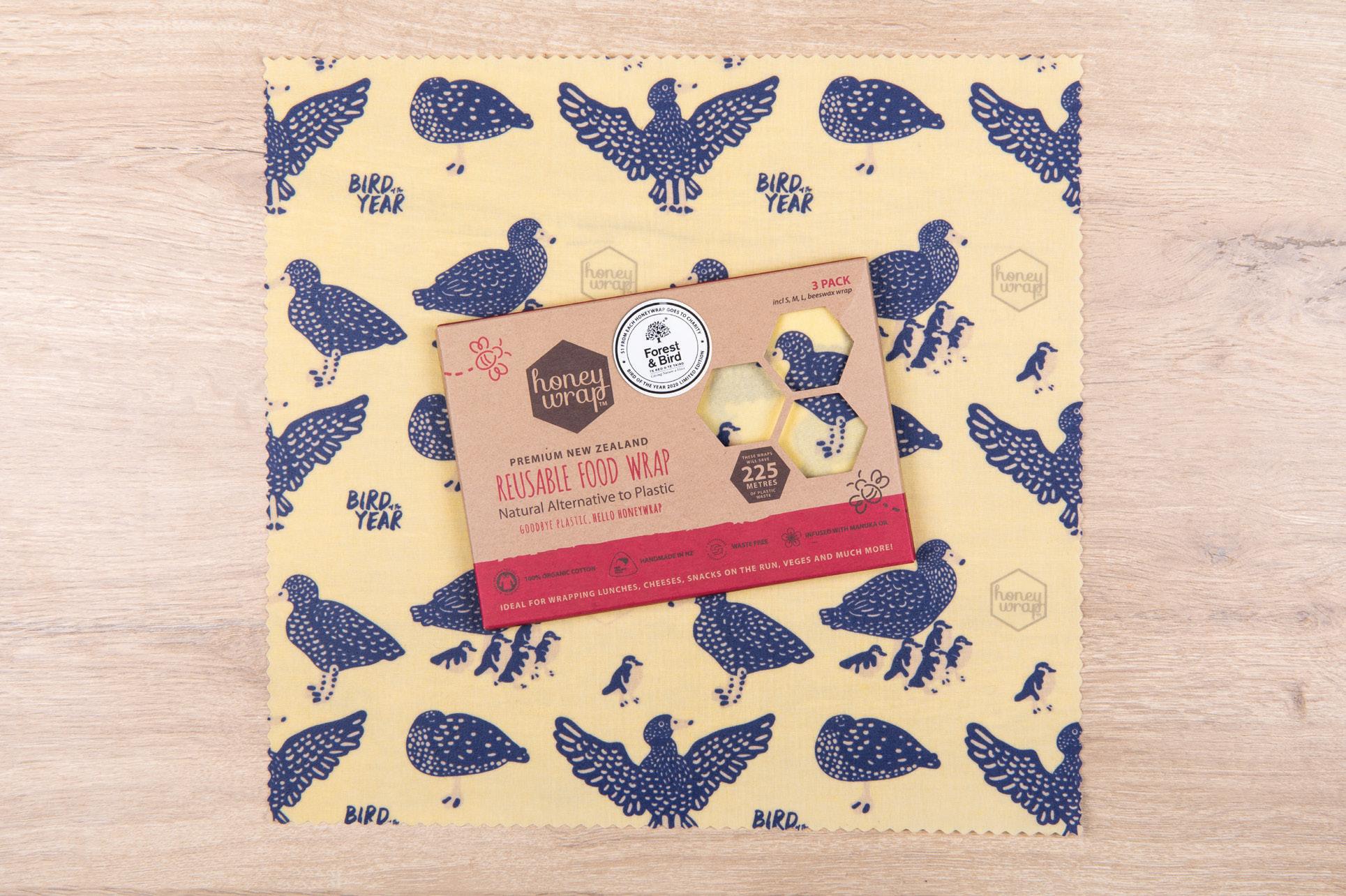

Bushy Park Tarapuruhi has previously seen translocations of toutouwai North Island robin, tīeke saddleback, and hihi stitchbird, and last year pōpokotea whitehead arrived in the sanctuary.
“Bringing these birds back to their ancestral home at Bushy Park Tarapuruhi helps us to restore the missing pieces of the ecosystem in an important site,” adds Nicola.
“It’s a credit to the project’s many volunteers, who contribute between 500 and 600 hours a month – as well as input and advice from all involved in this translocation.

“Everyone here is determined to provide a safe predator-free environment for titipounamu and other threatened species to thrive and repopulate the ngāhere.”
Titipounamu are our smallest endemic birds. Once common throughout Aotearoa, their populations have tanked over the past century due to predation and forest loss.
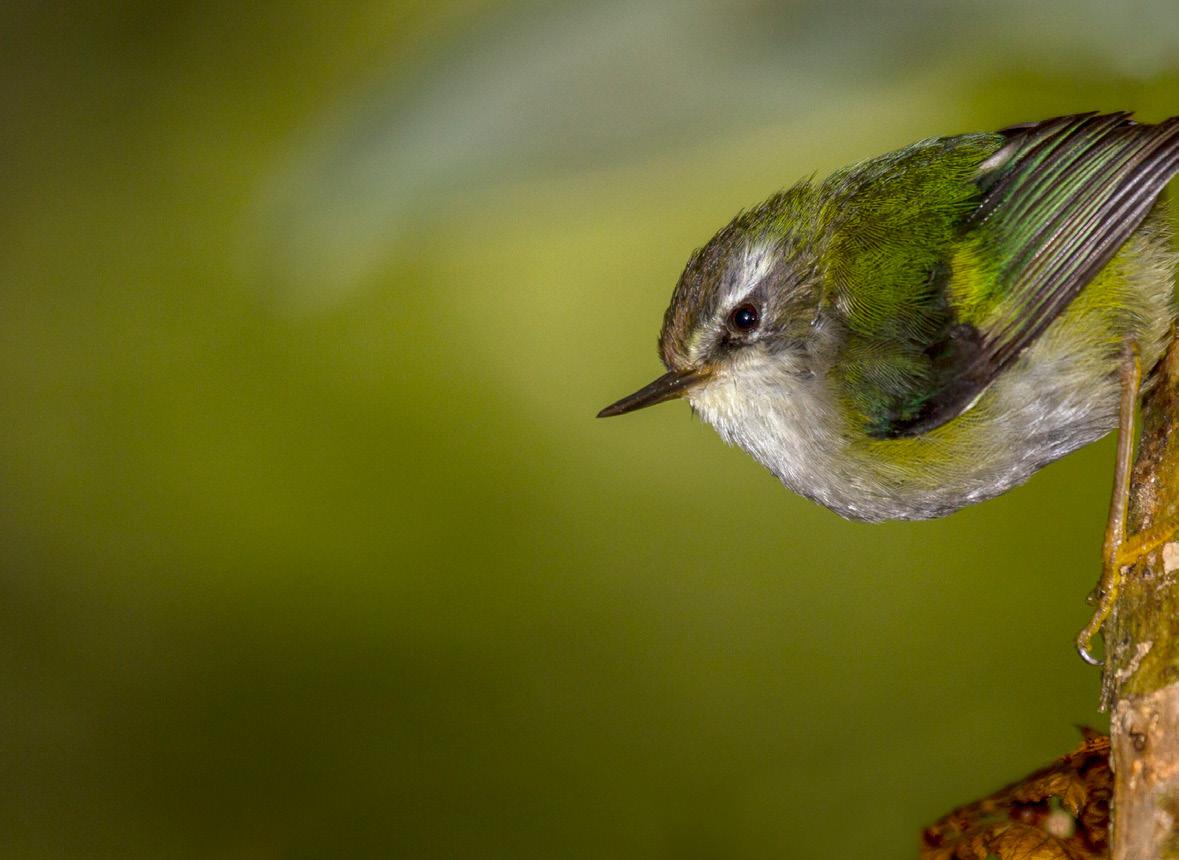
They are relatively poor flyers, which means that once extinct in a certain area, such as Bushy Park Tarapuruhi, new birds can’t fly in to re-establish a population.
Forest & Bird’s Bushy Park Sanctuary Manager Mandy Brooke hopes the new residents will feel comfortable in their new forest home and start breeding.
“The toutouwai and tīeke translocations have been
so successful, we have been able to gift some of our birds to start populations in other places. It would be wonderful if this new titipounamu population is equally successful.”
The Bushy Park Tarapuruhi titipounamu translocation is part of Forest & Bird’s year of centennial celebrations. We would like to acknowledge Horizons Regional Council, the Tindall Foundation, and WWFNew Zealand helping fund this translocation.
WHAT’S IN A NAME?
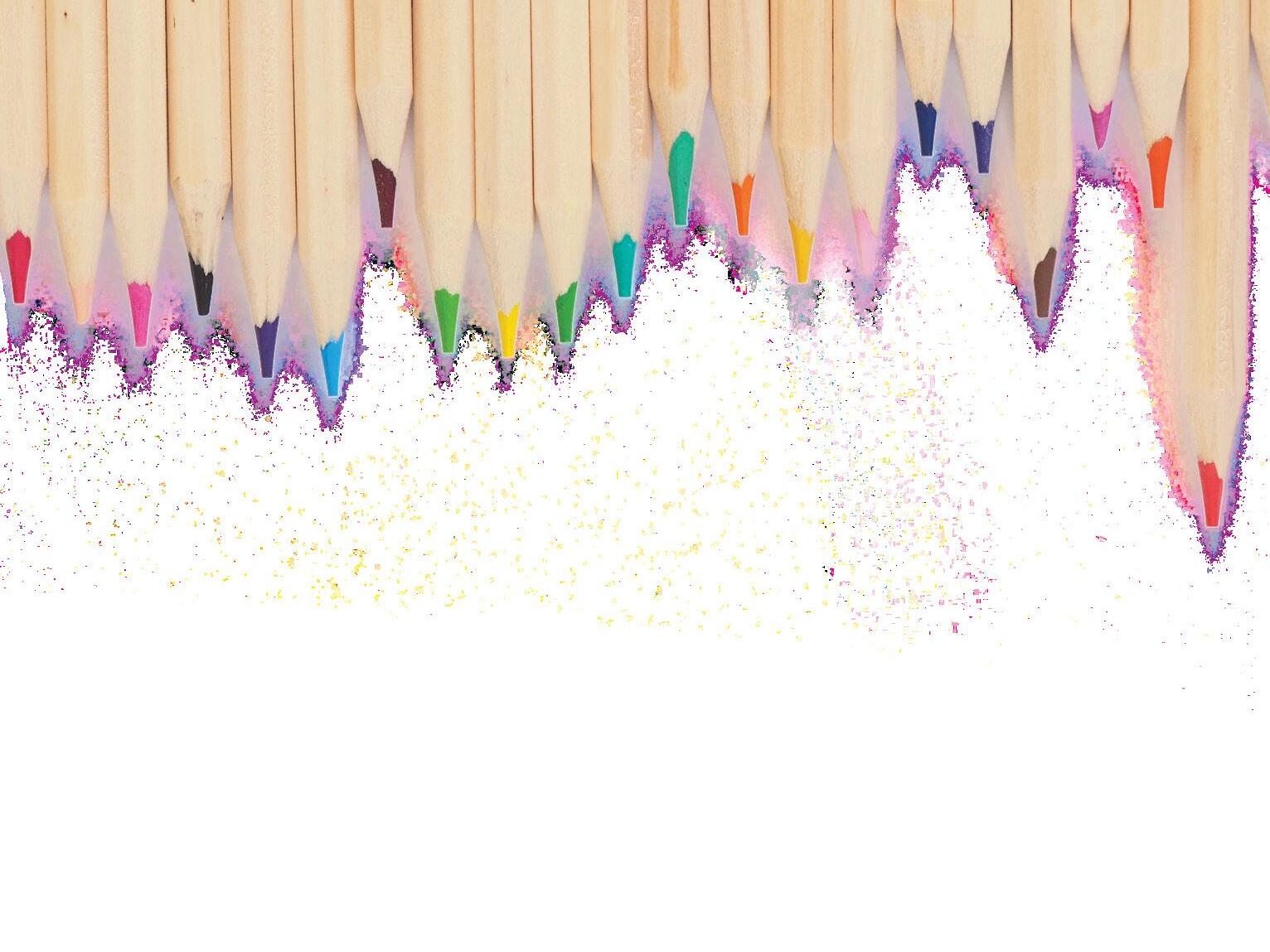
Titipounamu is a combination of tītiti, which means “a mirage of” and pounamu greenstone. The te reo name refers to the bird’s green colouring and the way it flits about in the treetops. The English name rifleman references the green

Women were among the first members of Forest & Bird and fulfilled a number of roles within the society. Their influence reached across the fields of science, politics, education, and art and helped create significant conservation outcomes for New Zealand.
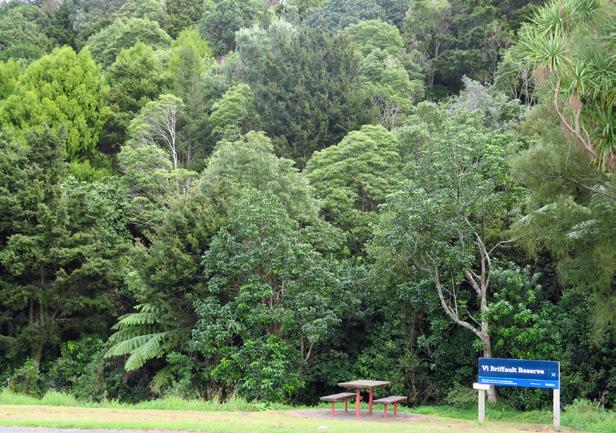



HEROINES IN HISTORY
Forest & Bird was the first of New Zealand’s modern-day conservation groups, and women were involved from its creation, becoming vicepresidents, honorary secretaries, and executive board members. Despite women being active in all aspects of the first 50 years of the Society’s work, there has been limited scholarship looking into their lives and contributions to conservation. In 2020, Forest & Bird awarded a Force of Nature scholarship and archive support to Masters student Tess Tuxford, of Te Herenga Waka Victoria University of Wellington to research, as case studies, the conservation work and impact of six early women members. They were Amy Hodgson, Pérrine Moncrieff, Elizabeth Gilmer, Violet Rucroft (Briffault), Lily Daff, and Audrey Eagle. Through the examination of how they engaged with conservation in relation to science, politics, education, and the arts, she hoped to shine a spotlight on the relevance of women in New Zealand’s conservation heritage. During her research, Tess discovered the many and varied ways in which women contributed to conservation within wider societal themes of gender,
class, and identity. The impact of these women was evident nationally and locally during their lifetimes. “Visitors undertaking the great walk in Abel Tasman National Park, picnicking in the Briffault Reserve, or admiring Wellington’s pōhutakawa at Christmas time experience the benefits of their hard work,” says Tuxford. “Likewise, those wishing to delve into the heritage of New Zealand’s native species or to admire pioneering post-colonial artwork can do so with ease at the country’s national museums and libraries.”
The short profiles right are based on Tess Tuxford’s research and findings. She published these in an essay called Taking Flight: The Role and Impact of Women in Forest & Bird’s Early History, which can be accessed at Bit.ly/3N2261g. Forest & Bird is grateful to environmental historian Dr James Beattie for supporting the Force of Nature history project and supervising Tuxford’s research.
CENTENNIAL STORIES
Tess Tuxford
Kareao Ripogunum scandens. Audrey Eagle
Self-taught botanist Amy Hodgson was awarded an honorary degree from Massey University aged 87. She donated 14,000 liverwort specimens to the nation. Massey University Archives
Tess Tuxford
| Forest & Bird Te Reo o te Taiao 34
Vi Briffault reserve. Meg Collins
Amy Hodgson (1888–1983)

Botanist | Plant collection held at Te Papa | Used Forest & Bird trips to collect plants | Donated 14,000 liverwort specimens to Massey University
Despite having the “instincts of a born research scientist”, it wasn’t until after the birth of her fourth child that Eliza “Amy” Hodgson set out on a path to becoming one of the greatest female botanists of her time. Her interest in plants was sparked by her headmistress Anna Spencer at Napier Girls High School, but Hodgson’s father wouldn’t allow her to go to university to study, instead insisting she remain at home to improve her domestic skills. She married in 1912 and a decade later started sending plant specimens to her former headmistress for identification, but married life continued to curtail her botanical work. She was living on a farm in an isolated part of Hawke’s Bay and couldn’t drive. So, when Forest and Bird started running family camps in 1953 to plant-rich locations, including Waikaremoana, Ruapehu, and Mount Egmont, Hodgson jumped at the chance to join the trips and collect specimens from further afield. She remained involved in the Society, and the first meeting of Wairoa section of Forest and Bird was held at her home in 1961. Wairoa solicitor Osborne Sainsbury was Hodgson’s mentor and had an interest in native mosses. She wanted to research liverworts, but Sainsbury tried to discourage her before eventually relenting. Once allowed to follow her passion, Hodgson overcame her lack of formal training to transform the study of liverworts in New Zealand. She was 42 when she published her first research paper and went on to publish 32 more. Hodgson’s research forms the foundation of knowledge on the species in New Zealand, according to Sandra Coney in Standing in the Sunshine. In recognition of this scientific legacy, Hodgson was awarded an honorary doctorate from Massey University in 1976, seven years before she died.
Pérrine Moncrieff (1893–1979)
Ornithologist | First comprehensive field guide to New Zealand Birds | Founding member Forest & Bird and Vice-President | New Zealand’s foremost female conservationist of her generation
Pérrine Moncrieff considered herself a naturalist rather than a scientist, who she considered were not as completely dedicated to the “conservation cause” as she was. Like her good friend Val Sanderson, Forest & Bird’s founder, she believed protecting nature could lead to the survival of native birds facing extinction. This contrasted with the views of her predecessor ornithologists who thought they were doomed, so they killed and collected rare species as specimens for posterity. Born in London to a wealthy family, the diminutive Moncrieff was a towering figure in Forest & Bird. She was a founder member in 1923, appointed a VicePresident alongside Elizabeth Gilmer (see overleaf) in 1927, and remained an effective voice for nature until her death in 1979. Moncrieff understood the value of educating and inspiring the public, particularly children, to want to look after native birds. One of her greatest contributions to public education was the seminal publication, in 1925, of New Zealand Birds and How to Identify Them. Her book, which was dedicated to the children of New Zealand, made it possible for amateur birdwatchers to identify native species. But it was criticised by professional male ornithologists who called the bird descriptions “imprecise, poetic, and sentimental”. This mirrored similar criticism of female botanical and bird artists at the time. But Moncrieff’s book ran for five editions and was hugely popular. She also wrote for Forest and Bird’s magazine and judged the Society’s first children’s nature essay competition. Moncrief played a pivotal role in the creation of Abel Tasman National Park, in 1942, an achievement for which she is best known.

THE AMATEUR SCIENTISTS: Finding scientific legitimacy within the confines of gender
There were many differences in the lives of Pérrine Moncrieff and Amy Hodgson, one born to a wealthy family in London, and the other to a farming family in Havelock North. But they shared a drive to pursue their scientific interests despite the constraints for women working outside traditional scientific infrastructure. They both developed networks of contacts and used their membership of Forest & Bird to assist them in their work. Their adaptability to working in fields which were not yet entirely open to women resulted in lasting legacies that still benefit New Zealanders to this day. Tess Tuxford, Taking Flight
 Pérrine Moncrieff. Nelson provincial Museum
Amy Hodgson (centre) collected plants during family picnics and during Forest & Bird trips. Lucy Hodgson collection
Pérrine Moncrieff. Nelson provincial Museum
Amy Hodgson (centre) collected plants during family picnics and during Forest & Bird trips. Lucy Hodgson collection
35 Winter 2023 |
Pérrine Moncrieff. (left) on a scientific field trip to Stephens Island, Marlborough. Alexander Turnbull Library
Elizabeth Gilmer (1880–1960)
Community worker, conservationist, horticulturalist | Resurrected Arbor Day | Native Plants Protection Act 1934 | Loder Cup 1938 | Forest & Bird Vice-President
Elizabeth Gilmer was 13 years old when women were given the right to vote in New Zealand in 1893, but it would be another 40 years before the first female MP was elected in 1933. Gilmer stood unsucessfully for Parliament in 1935 and 1938, but she used her political influence (inherited and earned) to push for the proper preservation of native plants. Gilmer was born in Kumara, Westland, the seventh daughter of New Zealand’s 15th Prime Minister, Richard Seddon. She learned to love flora at Wellington Girls College after being made to garden as a punishment for misdemeanors.

The devastation of native bush north of Wellington compelled her to join Forest & Bird, and she became one of two women Vice-Presidents in 1927, alongside Moncrieff. Gilmer went on to play a prominent role in the Society, according to its historian Neil Dalmer, who remembered her as: “A kindly figure with charming manner, who was a robust fighter for worthy causes.”
Gilmer garnered public support for the Native Plants Protection Act 1934 and in the same year secured the restablishment of Arbor Day using her society contacts to make it a success. As Patron of the Wellington Beautifying Society, Gilmer believed horticulture led to good health and responsible citizenship. She became known as “Pōhutukawa Kate” for her determined efforts to protect pōhutukawa in the capital.
Violet Rucroft (1902–1986)
Educator, conservationist | Rucroft petition| Founded Forest & Bird’s Whakatāne section, 1956 | Loder Cup 1971 | Queen’s Service Medal
Like many women of her generation, Violet Rucroft (later Briffault) came to conservation in her later years, when she had fewer family commitments. The Whakatāne music teacher focused on preserving nature locally, advocating for the native forests of the Bay of Plenty. She was also devoted to educating children about native flora and an enthusiastic supporter of Forest & Bird’s family camps. Rucroft joined the society in 1949 and established its Whakatāne section in 1956, possibly the first woman to found a branch. In 1959, she organised a petition to stop milling in “all steep protective forests” in Te Urewera National Park and asked the government to plant at least 5000 acres of marginal lands in native trees every year. Known as the Rucroft petition, it garnered nearly 20,000 signatures, and she presented it, as chair of Whakatāne section, to a government select committee. She was promised a “favourable response” to the petition, but this didn’t happen because of a change in government. She continued to advocate for the preservation of Te Urewera National Park, was made an honorary park ranger in 1962, and won the Loder Cup in 1971. Rucroft was a “forward thinking, politically engaged, and ambitious conservationist”, said Forest & Bird’s President Roy Nelson in 1979. She also led tree planting and weeding projects in and around Whakatāne, and when she died, in 1986, the Vi Briffault Reserve was named in her honour.
THE COMMUNITY ORGANISERS: Using influence and education for environmental outcomes
As winners of the Loder Cup, Gilmer and Rucroft were recognised nationally for their service to conservation, but they also experienced lack of support for their political objectives. Environmental organisations, such as Forest & Bird, helped facilitate their goals, but also benefitted from both women’s ambition and their desire to invest time and resources to achieve the wider goals of the organisation itself.


 Tess
Tess
CENTENNIAL
STORIES
Tuxford, Taking Flight
Elizabeth Gilmer, 1926. Evening Post Collection, Alexander Turnbull Library
Violet Rucroft (far right) with some of Forest & Bird’s Executive, 1968. Forest & Bird Archives
Violet Rucroft and Bill Parham, 1973. Anne Burkinshaw collection
| Forest & Bird Te Reo o te Taiao 36
Gilmer was made a Dame in 1951 Evening Post Collection, Alexander Turnbull Library
Lily Daff (1885–1945)
Artist | Book illustrator | Forest & Bird artist | Exhibitions Officer, Otago Museum


Following her mother’s death, the London-born artist moved to New Zealand in 1926 and found work in the government’s publicity department drawing native flora and fauna. In 1929, Daff was offered a commission by Sanderson and the Native Bird Protection Society to create a collection of artworks to raise awareness of her adopted country’s unique birdlife and promote the need for their preservation. Advised by famous ornithologists of the day, including Robert Falla, she created 52 beautiful and scientifically accurate watercolour bird paintings. These were published in two Forest & Bird books: New Zealand Forest Inhabiting Birds, 1933, and New Zealand Sea and Shorebirds, 1940. These were reprinted several times and distributed to schools well into the 1950s. The artworks also appeared on the covers of more than 30 Forest and Bird magazines from 1933 to 1945. The artistic appeal of Daff’s paintings made them hugely popular, and the Society reprinted them on collectable cards, Christmas cards, and notepads. In 1931, Daff joined Otago Museum as a full-time artist and remained there until her death in 1945. A colleague remarked that Daff had made New Zealand birdlife more familiar to the general public than ever before. However, her work was frequently published without proper credit and was considered popular art rather than scientific illustration. Like women botanical artists before her, Daff’s work was not fully recognised at the time for the value it brought to conservation, but she did pave the way for others, such as Audrey Eagle, to follow.
Audrey Eagle (1925–2022)
Botanical artist | Life Member Forest & Bird | Three times winner New Zealand Book Awards | Loder Cup 1985
Timaru-born Audrey Eagle helped establish the Waikato Branch of Forest and Bird in 1954 and began painting plants she found during nature trips organised by the society. In the 1970s, she was approached by William Collins Publishers to illustrate a book of New Zealand native plants. The dedication she employed in this task, which resulted in a complete record of New Zealand’s native trees and shrubs, helped garner many accolades and cemented her place in conservation history. Eagle was a member of Forest & Bird for nearly 60 years, with her most active period coinciding with the emergence of volunteerled branches springing up all over the country. In a series of Forest and Bird articles from 1960 to 1980, Eagle showed how Kiwis were embracing the country’s growing environmental movement by integrating conservation work into their everyday lives, says Tuxford. For example, Eagle wrote about a Waikato Branch-organised plant sale in 1975 that raised funds to restore the Society’s Walter Scott Reserve, a significant native bird habitat in the Waikato. The intrinsic value of Eagle’s botanical artworks is illustrated by her first Forest and Bird trip, in 1954, when she and a fellow botanist spotted a rare mistletoe Trilepidea adamsii. She picked a piece to draw and then sent it to Lincoln University’s herbarium. It was the last time the plant was seen alive, but thanks to Eagle we have a picture of it for posterity.
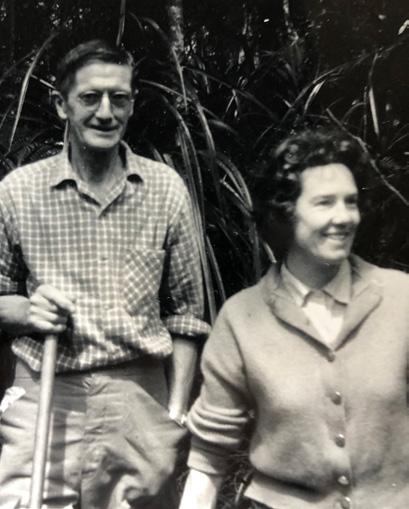


THE CREATIVES: Connecting to the land through visual endeavours
While Daff was under-acknowledged during her lifetime, Eagle, born 40 years later, received many accolades demonstrating how attitudes towards women in science and art had changed over a generation. Both helped establish a visual history of New Zealand’s native species and increased popular interest in the country’s flora and fauna. Ultimately, they contributed to a shift in New Zealand’s national consciousness by helping the public develop associations between their national identity and the environment.
Tess Tuxford, Taking Flight
Lily Daff. Forest & Bird Archives
Audrey Eagle, 1964, with botanist Athol Caldwell. Alison Eagle
Audrey Eagle, in 2009. Michael Hall/Te Papa
Harekeke Phormium tenax. Audrey Eagle
37 Winter 2023 |
South Island kōkako. Lily Daff
A PRICKLY PROBLEM
Why do we find it hard to kill hedgehogs when they are busy murdering critically endangered birds, lizards, and insects all over Aotearoa?
 Chelsea McGaw
Chelsea McGaw
When someone mentions hedgehogs, Mrs TiggyWinkle may come to mind – a cute wee critter that does no harm to anyone.
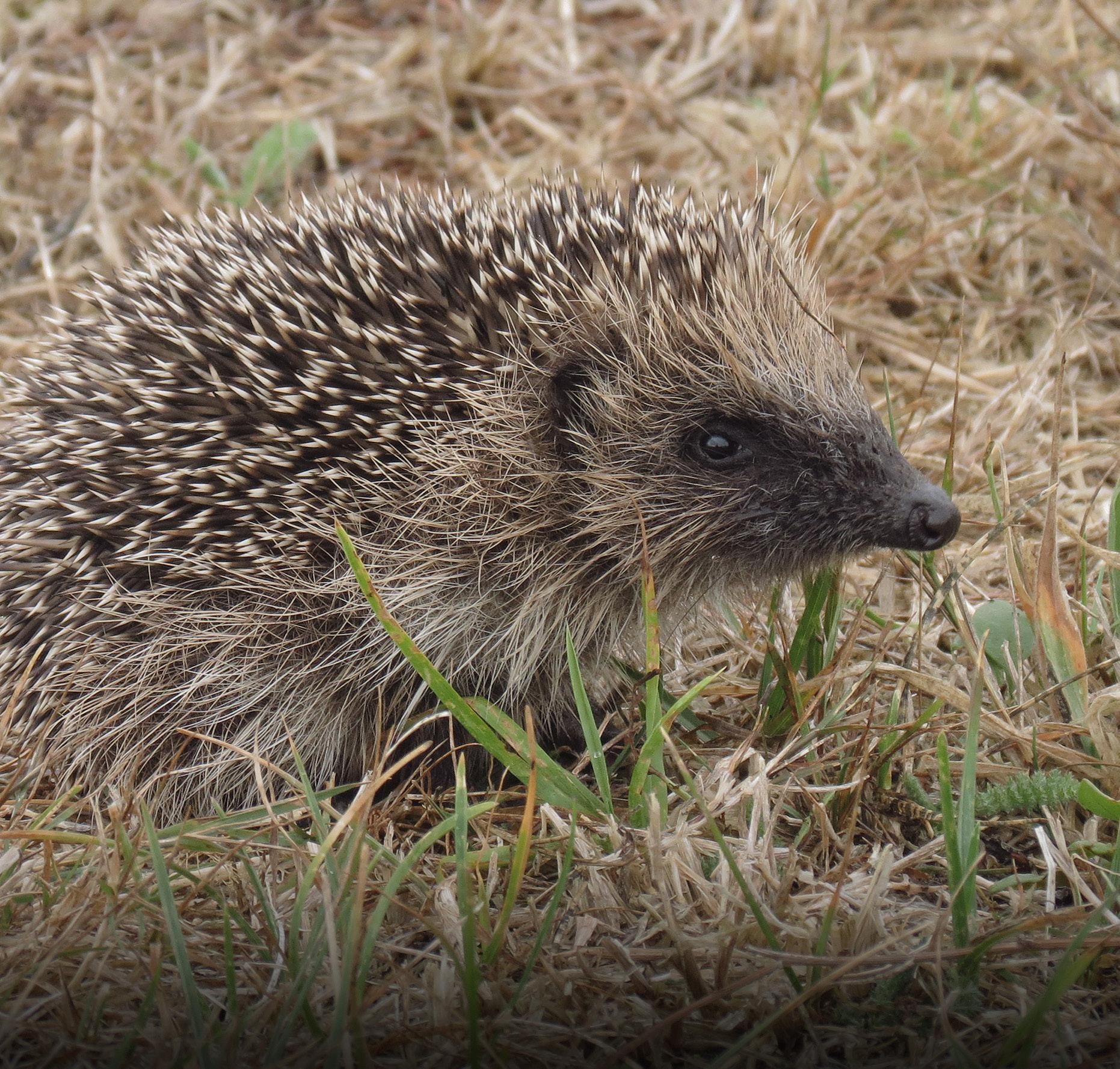
“Her little black nose goes sniffle, sniffle, snuffle, and her eyes go twinkle, twinkle, and beneath her little white cap are prickles!” wrote Beatrix Potter in her muchloved 1905 children’s book The Tale of Mrs Tiggy-Winkle.

Some New Zealanders leave out food for hedgehogs and nurse them when they are injured, not realising that hedgehogs are far from benign here in Aotearoa.
In fact, they are armed with sharp teeth and a strong jaw, capable
of crunching bones and making them efficient killers of a variety of insects, lizards, and ground-nesting chicks.
English colonialists initially brought hedgehogs to New Zealand to remind them of their homeland, then released them in greater numbers to control garden pests such as slugs, snails, and grass grubs.
Much like other introduced mammalian predators, hedgehogs have no natural predators here and are considered a pest. They invade native habitats, and their populations are limited only by food source.
Being non-territorial creatures, they can occupy small areas in huge numbers, with densities highest in farmland, but they also occupy grassland, braided riverbeds, and drier forest habitat.
In the Mackenzie Basin, for
example, hedgehogs were found to be responsible for one in five predator attacks on nests, according to the Department of Conservation.
One hedgehog caused an entire colony of nationally endangered black-fronted terns to abandon their nests. They have been observed eating the eggs of the banded dotterel, which is At Risk –Declining.
Hedgehogs also target species considerably larger than they are, including our critically endangered hoiho yellow-eyed penguins.
In 2022, Penguin Place, on the Otago Peninsula, caught 103 hedgehogs in their trapping network, and they weren’t even the target species!
“The damage hedgehogs are able to do, particularly during the hoiho breeding season, is pretty remarkable,” said Jason van Zanten, conservation manager at Penguin Place.
“There have been occurrences at some sites where eggs are cracked open and eaten by these little critters.”
With breeding pairs in rapid decline, the loss of one egg or chick is devastating to what has become the world’s rarest penguin.
Tom Goodman, biodiversity ranger for Project River Recovery, says hedgehogs have been recorded eating kakī eggs. There are only about 170 adult kakī left in the world.
Juvenile hedgehog Kāpiti Coast. Roger Smith
The Tale of Mrs Tiggy-Winkle first edition cover.
Wikimedia
PEST-FREE NZ
What big teeth you have. Beth Wishart
& Bird Te Reo o te Taiao 38
| Forest
He believes hedgehogs are probably one of the greatest hindrances to kakī re-establishing a wild population.
Birds and eggs aren’t a hedgehog’s favourite or most consumed food. In fact, they have a voracious appetite for insects, which are their primary prey.
and braided river systems are hedgehogs and cats.

“Hedgehogs populate areas according to food resources and climatic conditions. They can reach staggering densities, which is bad news if you’re an invertebrate, reptile, or ground-nesting bird.
“Predator Free 2050 is about outcomes for Aotearoa’s biodiversity. Outcomes for dryland biodiversity can only be delivered if hedgehogs are added to the list,” Nick added.
Amelia Geary, Forest & Bird’s Wellington regional conservation manager, knows all too well the problems “hedgedevils” pose to local wildlife.
HIBISCUS
COAST’S
HUNGRY HEDGEHOGS
Earlier this year, a prickly predator came across a New Zealand dotterel nest in Big Manly within Forest & Bird’s pest-free Hibiscus Coast project area. It ate the three eggs, leaving nothing but broken shells, but was later discovered in a nearby trap.
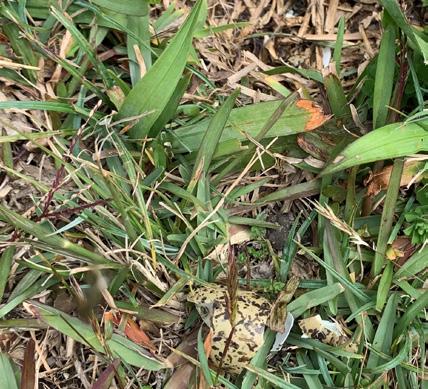

An astonishing 283 wētā legs were found in a single hedgehog gut by researchers in 2005, amounting to 47 individual wētā over only a 24hour period. These prickly invaders also prey on the hara, a native centipede, and other rare insects.
Lizards are another animal on the menu, with remains found in 6% of hedgehog guts in the same 2005 study. It is believed they prey on our native frogs too.
“Hedgehogs are the lawnmowers of invertebrate life,” says Tom Goodman. “Probably the worst thing about hedgehogs is they pick a patch of real estate and spend their entire lives walking around in circles mowing bugs.”
Eastern dryland systems, such as the Mackenzie Basin and Aoraki, are very different from the rest of Aotearoa, says Nick Foster, predator ecologist for Te Manahuna Aoraki Project.
“Stoats, rats, and possums are present in these environments and have their impacts, but the primary threats to native fauna in dryland
She has a quarter-acre block on the Kāpiti Coast, where she has planted more than 100 native plant species to create a safe haven for wildlife.
“I’m trying to protect lizards in particular, so I’m trapping for mice, hedgedevils, and rats. I caught 35 the first year I started keeping records,” she said.
“Attitudes toward hedgehogs need to change. It’s time for a rebrand. I call them hedgedevils for a reason. This is not benign snuffly Mrs Tiggy-Winkles we’re dealing with. They are hardened predators with an insatiable appetite for our native biodiversity.”

Hedgehogs are quite agile and have been shown to swim more than 800m in search of food. They are also adept climbers and carry diseases that affect people, birds, pets, and farm animals.
But don’t fret, there is a solution! Hedgehogs can be successfully trapped using DOC250, 200, and 150 traps, and Forest & Bird encourages you to control for hedgehogs in your backyard, wherever you live in the country.
Forest & Bird is calling on Predator Free 2050 to include three new species to its eradication list – hedgehogs, mice, and feral cats. Do you agree? Contact editor@forestandbird.org.nz with your stories and photos.
Project manager Jenny Hanwell, who is originally from the UK, spent the first part of her conservation career encouraging people to protect hedgehogs – in England where they belong.
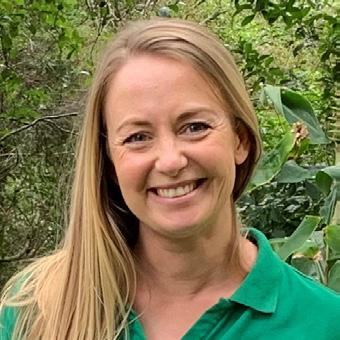
“We trap a lot of hedgehogs here, and yes I’m one of those people who initially found it hard to kill them,” Jenny said.
“But it’s a very different story here in Aotearoa. I have no problem with controlling them now, as long as it is done humanely.”
Sick hedgehogs regularly pop up on local Hibiscus Coast Facebook groups, with a community divided about what to do about them.
“People have asked me several times why, if hedgehogs are pests and Auckland Council prohibits their rescue and release under its Regional Pest Management Plan, do hedgehog rescue groups exist so publicly?” added Jenny.
Tracking shows how far individual hedgehogs travel in the Mackenzie Basin.
New Zealand dotterel eggs before and after being eaten by a hedgehog. Pest-free Hibiscus Coast
Jenny Hanwell
39 Winter 2023 |
Hedgehog licking mayonnaise-filled trap. Pest-free Hibiscus Coast.
SHINE A LIGHT
NIWA researchers are helping create safe streetlights for flying freshwater insects.
 Lawrence Gullery
Lawrence Gullery
Five years ago, when our towns and cities started removing older streetlights and installing new blue-white LEDs, little was known about the potential ecological effect this might have on our flying freshwater bugs.
Blue light is attractive to many insects, and the new LEDs emit more blue light than many, but not all, of the older lighting types.
NIWA freshwater ecologist Michelle Greenwood led a group of researchers investigating the impact on flying freshwater insects, an integral component of all waterways and a key indicator of a healthy ecosystem.
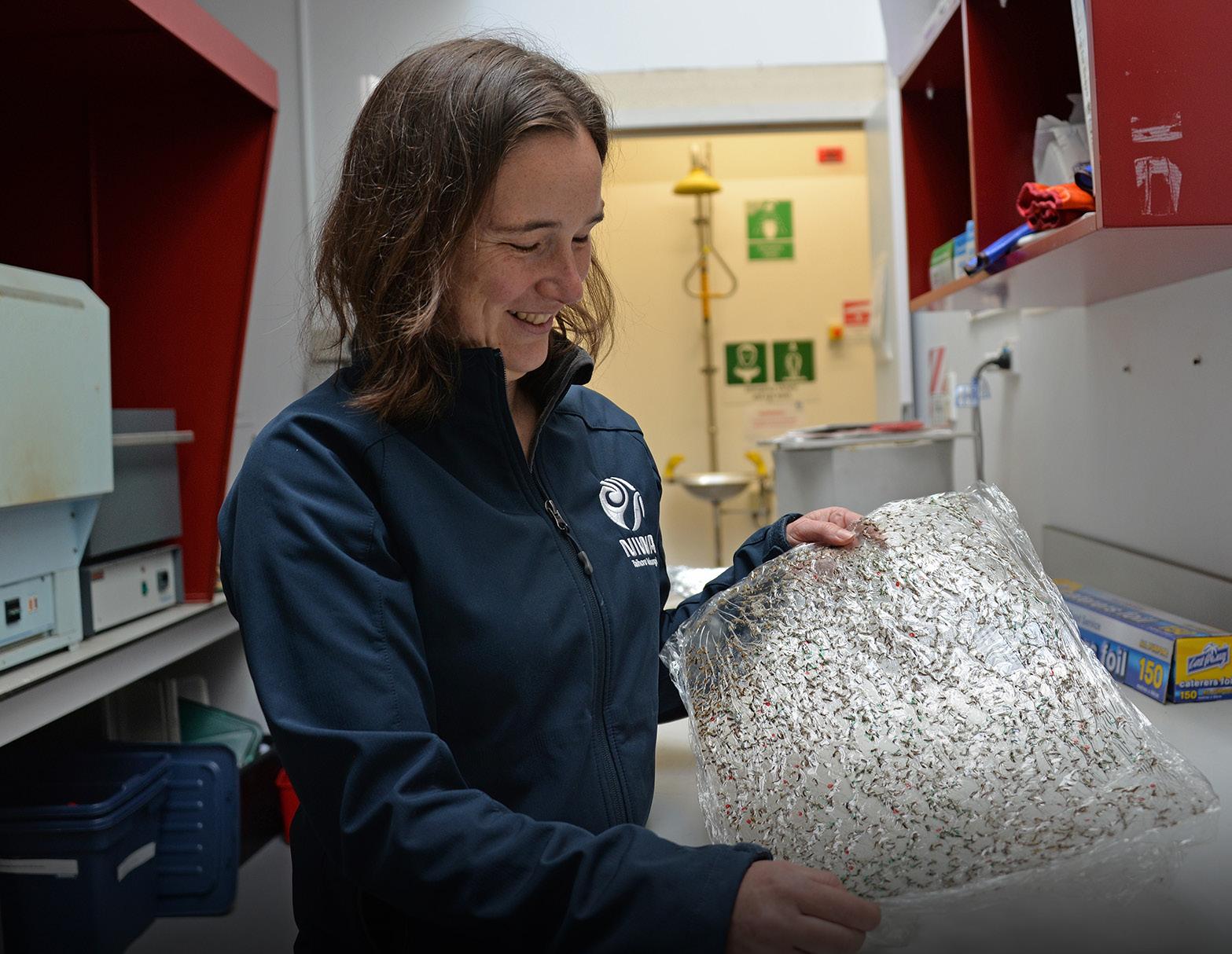
The four-year study in Ōtautahi Christchurch and in the Kaituna Valley, Banks Peninsula, was part of a Ministry of Business, Innovation and Employmentfunded Smart Idea project.
The team first looked at whether switching from yellow-coloured high-pressure sodium (HPS, 70 Watt) to blue-white 4000K LED (20 Watt) streetlights would increase the attraction of insects to the lights.
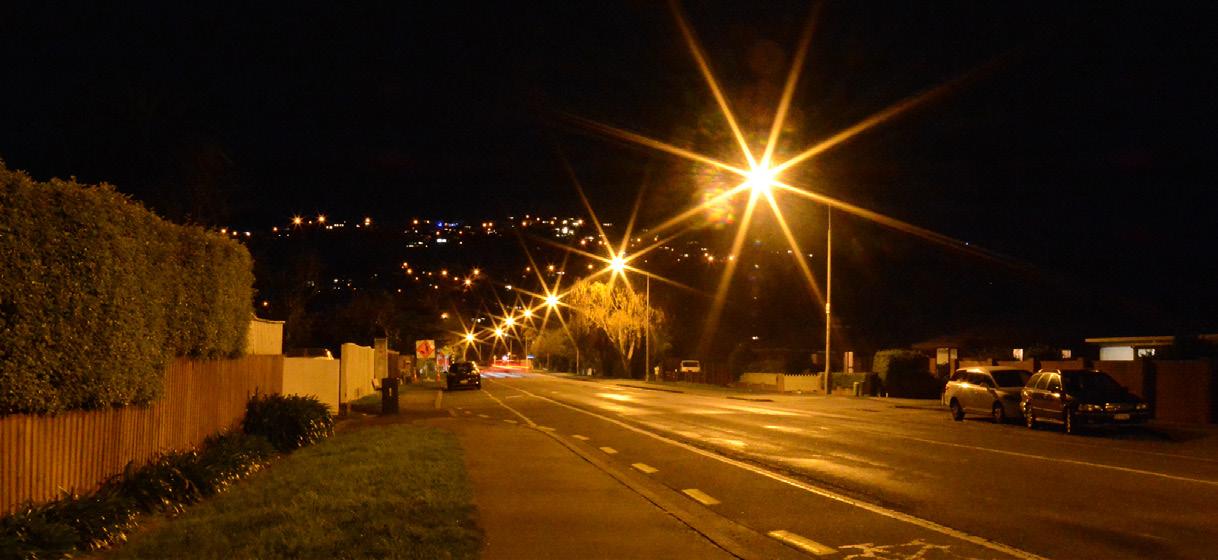
In a series of experiments, they captured insects flying around different types of lights near waterways.
They made a surprising discovery – in general, the new blue-white LEDs attracted fewer freshwater insects than traditional high-pressure sodium lamps, even though the blue light was predicted to attract more insects.
“The high-pressure sodium streetlights are more yellow but often gave off more light in total and ended up attracting more insects,” explains Michelle Greenwood. “Although the new LED lights emit blue light, in locations where they emitted much less light than the older lights, they attracted fewer insects, which is good news for freshwater ecosystems.”
The team also wanted to understand whether selecting specific types of LEDs could reduce insect attraction. Their experiments showed many, but not all, flying insects were more attracted to commonly installed blue-white LED streetlights than LEDs that emitted less blue or only yellow light.
Caddisflies and moths, for example, were attracted to LEDs that emitted more blue light in experiments using both operational-scale streetlights run by NIWA and smaller-scale lighting set-ups run by Jessica Schofield as part of her Master of Science at the University of Canterbury.
This effect was largely consistent across different caddisfly taxa, as well as next to rivers both in lightnaïve areas (Arthur’s Pass National Park) and better-lit urban areas.
“Using lights that emit less blue light is likely to benefit certain groups of insects (particularly moths and caddisflies), with the magnitude of effect dependent on the insect taxa, relative light intensity, and colour spectrum of the lamps being replaced,” added Michelle.
Jessica’s research also showed that, while caddisflies were attracted to lights up to 100m from a river, a high proportion of individuals were captured within 20m of the river.
“Placing lights further from waterways or behind screens such as riparian plants, where possible, will also likely reduce the attraction of freshwater insects to streetlights,” added Michelle.
Lawrence Gullery is Niwa’s communications lead for freshwater science. For more information on this project, contact Michelle Greenwood at michelle. greenwood@niwa.co.nz
FRESHWATER
Freshwater ecologist Michelle Greenwood with a sticky sample sheet that traps flying freshwater insects near streetlights. Simon Hayes/NIWA
Christchurch street before the change to new LED streetlights. NIWA
| Forest & Bird Te Reo o te Taiao 40
The same street after the changeover. NIWA
Singing for
BUSH & THE BIRDS
Singer-songwriter Jenny Mitchell is raising money for Forest & Bird in honour of her grandad and his love for nature.
Born and raised in a close-knit family in Gore, New Zealand’s country music capital, Jenny Mitchell has music in her genes.

Playing and singing since she could talk, and influenced by her musician father Ron Mitchell, she has been taught that sharing music can bring joy to others.
But it was grandad Bruce who instilled a deep love for the natural world in Jenny, and now she wants to pay it back by fundraising to support Forest & Bird’s work.
Her new Bush & the Birds tour kicks off in mid-June with 10 dates across the country, including three full band shows in Auckland, Wellington, and Dunedin.

“The Bush & Birds’ is a song from my album Tug of War about the love of the land and the creatures that live in it that my Grandad Bruce handed down to my family,” says Jenny.
“The song and the tour are tribute to his life and how he inspired us with his stories. In his honour, I wanted to make sure there was a gift back to nature.”
Jenny has chosen to donate 10% of tour profits and $1 from the share of every tour promotional video to Forest & Bird up to $200.
The video donation will be matched by five businesses – Acorn Studio, Allen + Clarke, Bar Burgess & Stewart, Scrambler, and mum Julie Mitchell at Bayleys.
Jenny has produced three albums and won multiple awards for her work. She has also played shows in the US and is a volunteer trustee for Gore’s Tussock Country Music festival.
Her full band includes musician sisters Maegan and Nicola on backing vocals to bring soft, country harmonies.
“I’m excited to bring the full band to the cities. We
Alexandra Moyes
love playing together and bringing our collective sound live to the audience,” says Jenny.
The remaining dates are solo shows, with venues tucked away in some beautiful natural places.
The first (sold out) show on 18 June will be held in Peel Forest, with the tour finishing at Orokonui Ecosanctuary, Dunedin, on 28 July.
“Some of those smaller venues and communities have supported me since I started performing, so it’s special to play those again,” adds Jenny.
Check out the tour dates and book tickets for the Bush & the Birds tour at www.jennymitchell.co.nz
KILLS FOES
NOT FRIENDS
PINDONE PELLETS are a cost-effective way to control possums and rats, approved for use in sensitive environments. Very low risk of primary or secondary poisoning to domestic pets and native wildlife. For more information, go to keyindustries.co.nz

FUNDRAISING
Jenny Mitchell. ELSTUDIOS/Ebony Lamb
41 Winter 2023 |
Gabi Rankine
STAMPING OUR IDENTITY
Celebrating 100 years of Forest & Bird with NZ Post. Caroline Wood
Included in your June issue is a little thank you for being a voice for nature – a limited edition postcard marking Forest & Bird’s 100th birthday.
Each of you should have received a postcard with one of four stunning designs that feature on a new set of Forest & Bird postage stamps and collectables released by NZ Post on 5 April.

Depicting four main areas of Te Reo o te Taiao Forest & Bird’s conservation work – land, freshwater, marine, and climate –the collection pays tribute to the people who have worked to protect and restore nature since 1923.
Forest & Bird’s chief executive Nicola Toki says the stamp release is a significant and an emotional moment for members of the organisation.
“It recognises the efforts of thousands of Forest & Bird supporters, branches, volunteers, and staff over the past 100 years to preserve our endangered wilderness areas,” she said.
“Aotearoa New Zealand would look very different today without their passion, commitment, and sheer determination to do this mahi.
“It’s been our pleasure to work
with NZ Post on this collection, and we hope stamp collectors and members of the public love the range as much as we do.”
Wellington wildlife artist Rachel Walker’s vibrant artworks are inspired by the organic patterns and shapes present in the natural world – in the shape of a bird’s feather, the scales of a lizard, the arrangement of petals on a flower.

She achieved the impossible by packing a huge amount of history into a tiny artwork that would resonate with New Zealanders and work as a postage stamp.
Together, the set of four designs represent our whakapapa by depicting some of the landscapes, flora, and fauna of significance over the past century. Forest & Bird is the oldest national conservation charity in Aotearoa and the first of the modern-day e-NGOs.
The first stamp features Kāpiti Island with its colourful forest birds – kōkako, tīeke saddleback, kakariki, and tūī. This artwork represents Forest & Bird’s origins, island restoration, and the dedicated mahi of conservation volunteers past and present.


The second artwork takes us to Tautuku Ecological Sanctuary, in the Catlins, with the blue-
eyed Tautuku gecko stealing the show alongside sparkly Gollum galaxias fish, southern rātā flowers, pekapeka long-tailed bat, and Ourisia modesta, an endemic creeping foxglove.
This stamp represents Aotearoa New Zealand’s unique flora and fauna, its wild rivers, discovery, and hope.

Lynette Townsend, programme manager for NZ Post Collectables, led the team that turned Rachel’s artworks into the stamps. The designer was Nick Jarvie.
“We’ve featured Rachel’s beautiful paintings on a range
CENTENNIAL STORIES
| Forest & Bird Te Reo o te Taiao 42
Artist Rachel Walker with Lynette Townsend of NZ Post with two of the prints. Lynn Freeman
of collectables, including prints, greetings cards, and tea towels, so people can share Forest & Bird’s 100 years by gifting them to friends and whānau,” said Lynette.
“NZ Post is delighted to have helped mark an important milestone in New Zealand’s history, with Forest & Bird being the country’s oldest national conservation charity in the country.”
The third stamp features Ark in the Park, in the Waitākere Ranges, with tāiko black petrel, kauri, tohorā southern right whale, werewere kōkako blue mushrooms, neinei spider wood, and tītī Cook’s petrel flying off the coast.

This artwork represents the seabirds of Aotearoa, Forest & Bird’s marine protection work, and the vital connection between land and the ocean.
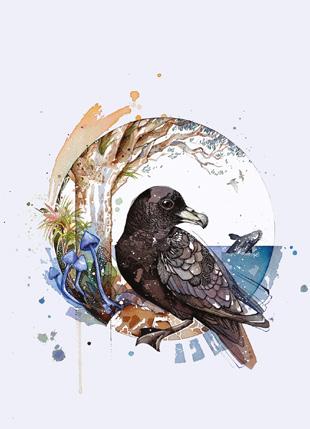


The last stamp of the series shows the iconic Denniston Plateau, on the West Coast, and features the pepe forest ringlet butterfly, Avatar moth, Powelliphanta land snail, pygmy pine, windswept mānuka, and tūtūmako eyebright flowers.

This artwork represents nature’s fragility, climate change, conservation activism, and the future.
Artist Rachel Walker hopes people will support Forest & Bird’s current conservation work by buying the stamps and collectables.

“My inspiration is the great outdoors. I love walking through the forest, listening to the birds, absorbing the colours and shapes of nature, and breathing the fresh air,” she said.
“It brings me hope, and I try to bring a little bit of that feeling back into people’s homes with my artworks.
“Forest & Bird has been protecting and restoring our flora and fauna for 100 years. It’s a privilege to be part of their story and help celebrate 100 years of conservation mahi.”
Please support Forest & Bird’s work by sharing these stamps and collectables with your friends and whānau. There are 30 different products available (see below for a selection). You can buy them at collectables.nzpost.co.nz/forestandbird


STAMPS
n Set of mint stamps $12.80
n First day cover $13.30
n Miniature sheet $12.80
n Miniature sheet first day cover $13.30
COLLECTABLES
n Set of four greeting cards $9.90
n Set of four pre-paid postcards $14.80
n Art prints $49.90
n Tea towel $10.00
 ← First day cover
Miniature sheet →
Tea towel ↓
Postcards ↓
Greeting cards ↓
← First day cover
Miniature sheet →
Tea towel ↓
Postcards ↓
Greeting cards ↓
STILL VANISHING
More than 75% of indigenous species are at risk of extinction or becoming threatened. What can we do to turn this around?
Caroline Wood
The loss of many of our indigenous species is a real possibility,” said Statistics NZ’s Michele Lloyd, in April, as she released the latest information on which of our flora and fauna is at most risk of vanishing forever.
It showed 94% of reptile species, 82% of bird species, 76% of freshwater fish species, and 46% of vascular plant species are facing extinction or are at risk of being threatened with extinction under New Zealand’s threat classification system.
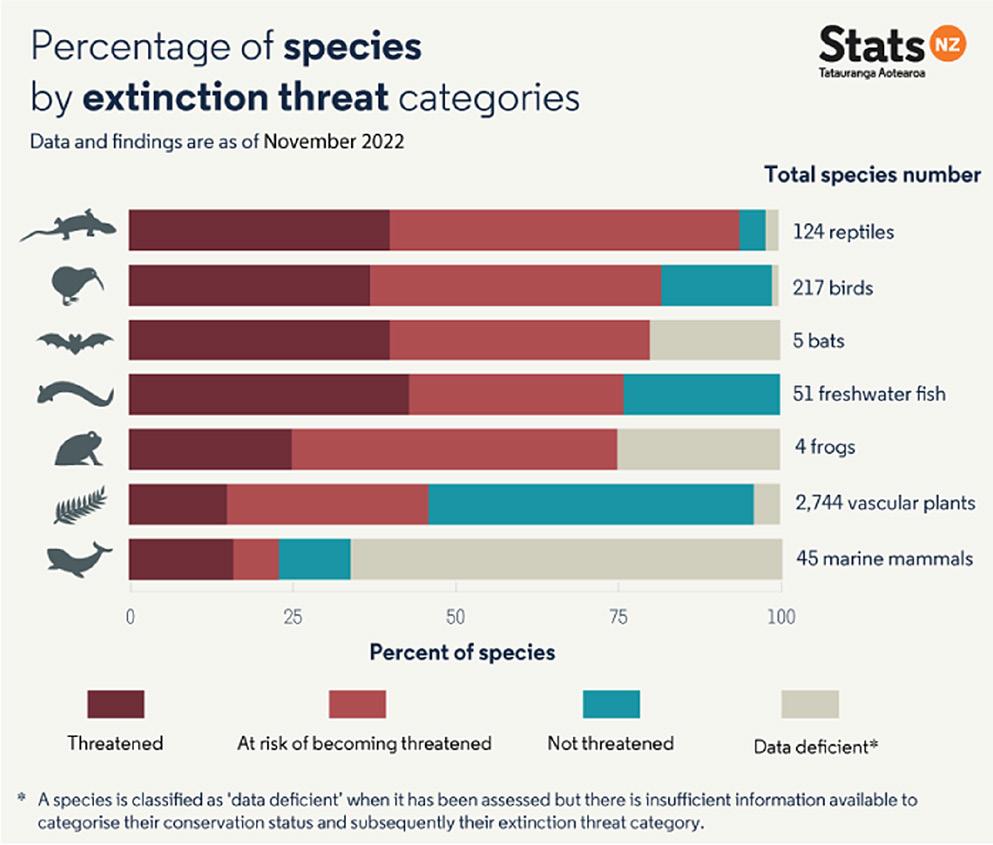
Those at risk of imminent loss include toroa Antipodean albatross, the Chatham Island black robin, kakī black stilt, kākāpō, orange-fronted kakariki, kōtuku white heron, and the whenua hou diving petrel.
“New Zealanders care about their wild places more than any other country, yet we now have the highest proportion of threatened species in the world,” says Nicola Toki, Forest & Bird’s chief executive.
“Unfortunately, this downward spiral for our unique birds, insects, fish, and marine mammals is not new. We continue to receive reports like this year after year.
“Yet our governments, councils, and powerful industry groups are still allowing native habitat loss and the destruction of waterways and the creatures that live in them. It’s time for all of us, especially our decision-

makers, to show courage and to say enough of this.”
The Statistics NZ data and findings on the extinction threat to indigenous species are from November 2022 and don’t capture the impacts of the recent storms and flooding.
Forest & Bird is asking all of you to help us be a strong voice for nature in the run up to October’s general election. We need to demand every political party commits to restoring nature to save humanity – and tells us how they are going to do it.
Continued threats include farming intensification, loss of wetlands, pests decimating forests, and sea-level rise. These are not just a threat to indigenous flora and fauna but to humankind’s existence.
Are we as a nation going to sit back and let more species go the way of the huia, whēkau, and other lost taonga? See right for five things the government can do to turn things around for nature.
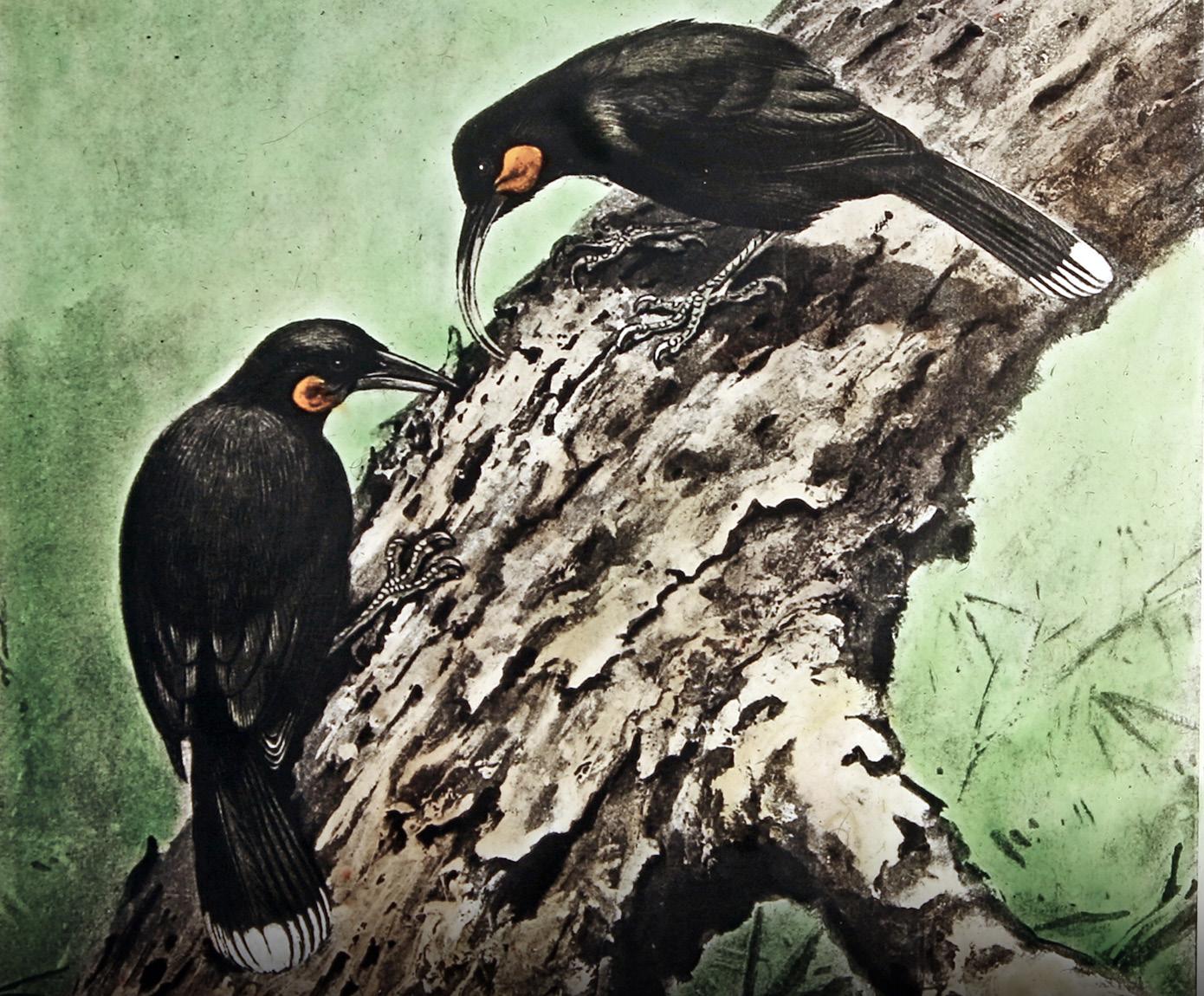
“
Table showing how many flora and fauna species are at risk of extinction. Statistics NZ
Whēkau laughing owl, South Canterbury, 1909, about five years before it became extinct. Cuthbert & Oliver Parr
BIODIVERSITY | Forest & Bird Te Reo o te Taiao 44
The last confirmed sighting of huia was around 1907 with a few likely persisting until the 1920s. Lantern slide, Forest & Bird archives
ACTIONS NEEDED NOW
➊ Properly implement and resource the national biodiversity strategy Te Mana o te Taiao. This contains a raft of policy and statutory instruments to restore nature over the next 30 years.
➋ Finish the National Policy Statement on Indigenous Biodiversity that’s been sitting in draft form for more than a decade. Forest & Bird and Federated Farmers worked hard to pull this important document together, and it could help turn things around for our wildlife.
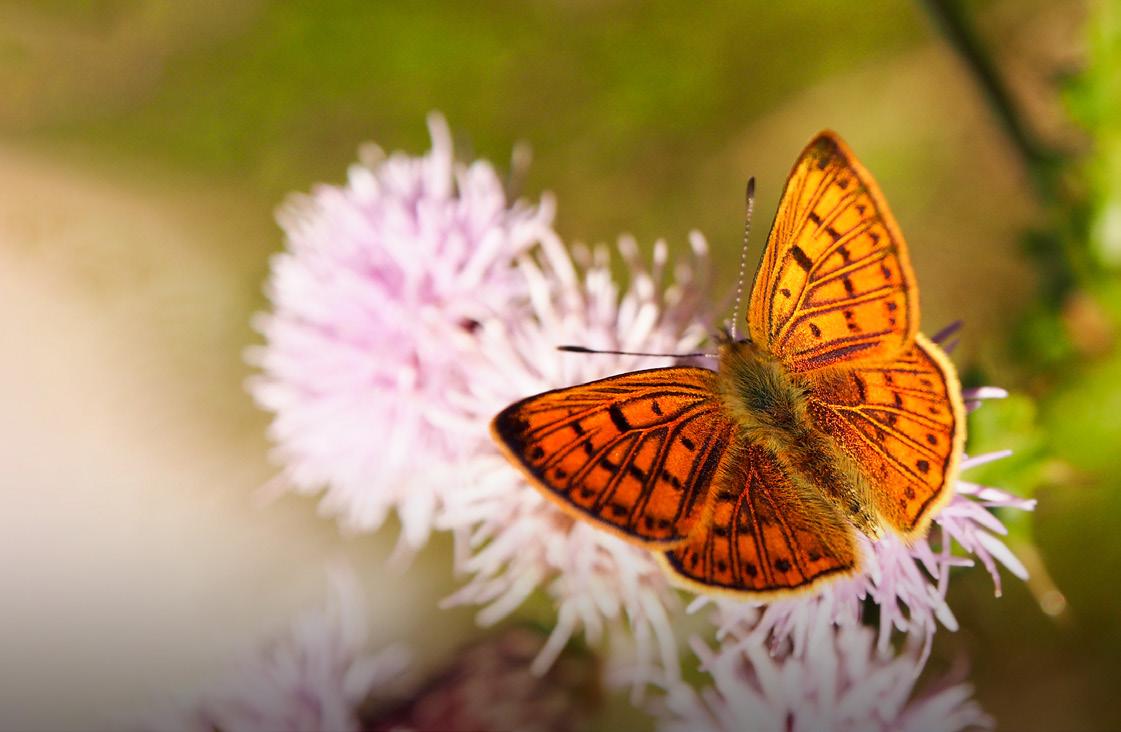
➌ Double natural wetland extent by 2050 to increase habitat for threatened species, store carbon, reduce flooding, and filter water. Develop a national Room for Rivers plan, with a contestable flood mitigation fund, that would give habitat back to birds, fish, and insects, while also making communities more resilient to flooding.
➍ End new mines on public conservation land, as the former Prime Minister Jacinda Ardern promised her government would, to prevent further habitat destruction and carbon emissions from mining. Invest in sustainable green technologies to futureproof our economy.
➎ Restore native forests through new plantings and properly resource pest control to protect our natural carbon sinks and bring back our birds, lizards, and insects. By investing in future native forests, the country can help stop erosion and flooding in vulnerable places.
RECHARGE IN THE WILD
Escape the hustle of modern life and sail into the serene on a remote, bespoke adventure into Fiordland. The Breaksea Girl your home in the wild, has all the creature comforts, a small family of expert guides and hosts a collection of multi-day adventures customised to get you closer than ever before.


DATA DEFICIENT
Lack of information about some species means it’s impossible to accurately categorise its extinction threat. Data deficient species include most marine mammals and less sexy charismatic native species such as lichens and insects.
“This is concerning because in many cases we don’t actually know how many species are doing because we don’t have data for them,” added Nicola Toki.
“We need to do better and fund scientists to get out into the bush and oceans to find out how our indigenous taonga is doing in the wild.”
For more information about the extinction threat to indigenous species, including estimated population trends, go to www.Statistics.govt.nz/indicators/
wildfiordland.co.nz
The Moths and Butterflies of New Zealand Trust is having to fundraise to pay for DNA research to better understand pepe para riki, the copper butterfly. Angela Moon
KAYAK . SAIL. SNORKEL. FREE DIVE HIKE. WINE. DINE. UNWIND.
FOR AROWHENUA
In a nearly 50-year labour of love, Forest & Bird branch members saved an important stand of indigenous bush in South Canterbury. Lynley Hargreaves
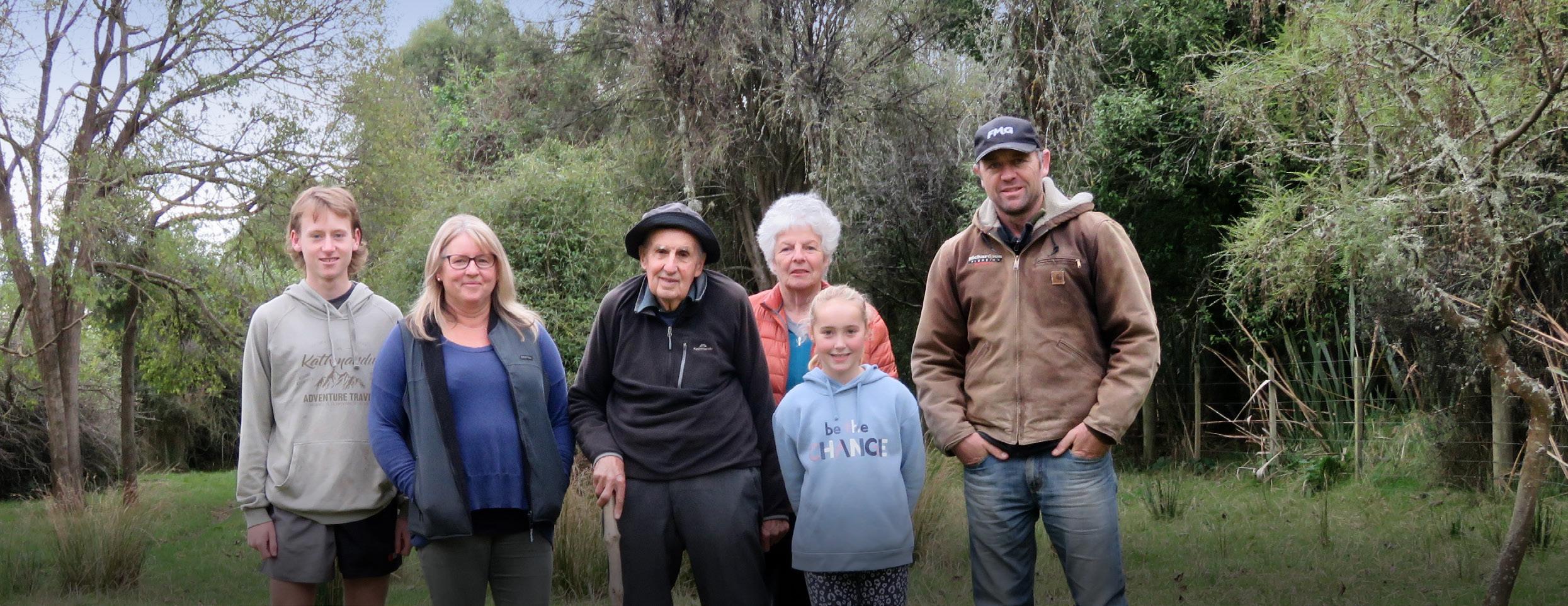
The last remnant of tall forest left on the lower plains of South Canterbury was recently secured for future generations, thanks to generous locals who helped Forest & Bird buy Arowhenua Bush.
South Canterbury Branch members Fraser Ross and Robert Birks made significant gifts towards the nearly $400,000 total cost of the land, near Temuka, with two other donors asking to remain anonymous.
Fraser, 89, has been looking after Arowhenua Bush for nearly 50 years. He says it looked more like a battlefield when he first set eyes on it following a huge 1975 storm that
knocked over many of its mature trees.
With permission of the then landowners, the Lyon family of Arowhenua Station, he started collecting seeds, propagating them, and planting them back out in the bush. A restoration project evolved from there.
Since 1975, all the seeds and cuttings have been eco-sourced from a 5km radius of the bush – so the genetic material remains true to the original plant lineage.
Trees in the remnant podocarphardwood forest include kahikatea, kōwhai, matai, and weeping matipo. There are also several pōkākā, a small native tree with beautiful flowers.

“I was told that I would never get trees to grow there because of rabbits and hares,” says Fraser.
“That proved to be the case –it was a major obstacle – but we overcame that by putting guards around each individual tree, and they started to grow.”
Now those trees are up to 10m high, with some fully grown, and the bush and its wetlands have been designated a Significant Natural Area by Timaru District Council. A rare species of New Zealand swamp nettle, Urtica perconfusa, occurs in the wetland.
“Fraser basically saved this block of land,” adds Robert Birks.
“In most cases, someone would have just piled up the remains and burned them.”
Fraser, who has visited the bush block more than 800 times at last count (five years ago!), paid tribute to the many locals who have helped him with restoration planting since the 1970s, mostly from Forest & Bird’s South Canterbury Branch.
The chance to secure the site forever came three years ago, when the station’s new owners Stu and Kate Bowman approached Forest & Bird and offered to sell the bush block.
The Bowmans, who have been carrying out long-term pest management of the area, are very supportive of Fraser and his team’s work, and plan to stay involved helping look after the bush.
“We’ve taken possum numbers down by at least 75% since we got here, down from several hundred when we first started,” says Stu. “This project wouldn’t have happened without Fraser. I really admire his commitment to it over such a long period of time.”
Landscape architect Ines Stäger, who is a long-serving South Canterbury Branch member, has spent many hours helping secure Arowhenua Bush for future generations.
“This has been a huge project for a small branch, with people giving
FOREST & BIRD BRANCH
Arowhenua Bush with (from left) Will and Kate Bowman, Fraser Ross, Ines Stäger, and Jess and Stu Bowman. Ines Stäger
|
Te
o te Taiao 46
Pōkākā (Elaeocarpus hookerianus) at Arowhenua. Ines Stäger
Forest & Bird
Reo
their time and money, and we are very grateful for their generosity and foresight,” says Ines.
“Just one percent of natural vegetation on the lower South Canterbury plains remains. As such, it was vital to secure the highest possible protection for its future.”
The restoration project would not have been possible without a local couple (who wish to remain anonymous), who were inspired to contribute because of its historic value.
“We have a long-held interest in the pre-European landscape of South Canterbury and knew Arowhenua Bush was one of the last remnants,” they said.
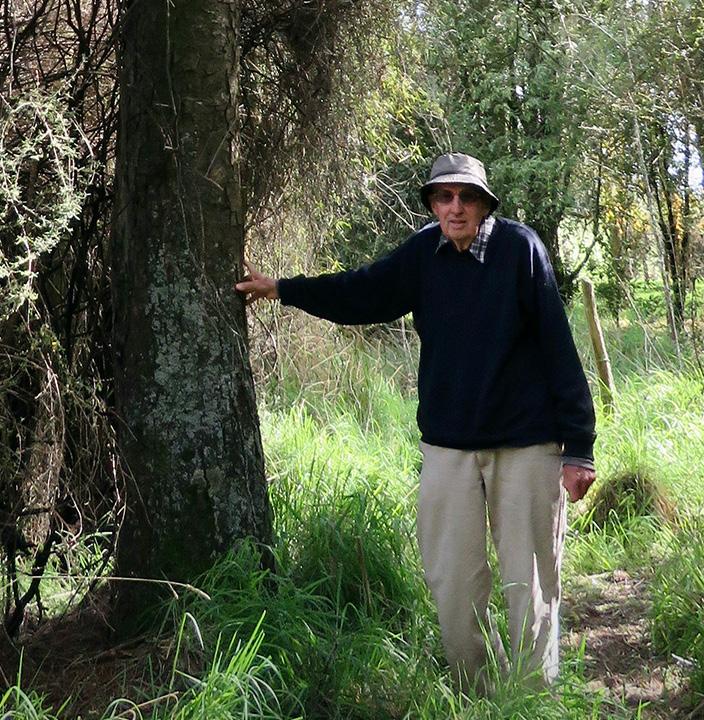
“We also knew that Forest & Bird would probably never get this opportunity again, so it was vitally important, and we wanted to help.”
The branch will now work with regional manager Nicky Snoyink on the site’s ongoing protection, including setting up a management committee to establish a restoration plan.
Arowhenua Bush is a small remnant of one of the very few areas of podocarp-hardwood forest present on the lower plains of South Canterbury at the time of European settlement.
In 1849, the surveyor Charles Torlesse described what he called “Horowenua” as a “wood of 500 acres [200ha] and as the only area of forest away from the foothills”.
Arowhenua Bush was a prominent landmark used to guide coastal steamers on their approach to Timaru. It appears the closest remnant of this type of forest was (and still is) Riccarton Bush in Christchurch. Devastating fires in January 1863 reduced the extent of Arowhenua Bush substantially. Then, in 1975, westerly gales caused severe damage, blowing down many of the remaining trees.
A visit to Arowhenua Bush by Fraser Ross and Colin Burrows in 1977 resulted in a description of the forest remnant and recommendations for management. Since that time, Fraser Ross has been closely involved in the protection and restoration of Arowhenua Bush, with the support of the Lyon family, spending many hundreds of hours weeding, planting, and caring for the forest remnant.
How ethical are your investments - really?
73% of New Zealanders want their money to be invested ethically, but most are concerned that they can’t access independent information or be confident that they aren’t being greenwashed.*
At Moneyworks, we cut through the greenwashing to provide independent analysis and education, to help our clients invest responsibly and sustainably. Our unique and proprietary process is thorough, transparent and personalised to you.


 Source: Timaru District Significant Natural Areas Survey, Arowhenua Station, prepared for Timaru District Council by Mike Harding, February 2008.
Source: Timaru District Significant Natural Areas Survey, Arowhenua Station, prepared for Timaru District Council by Mike Harding, February 2008.
LOCAL LANDMARK
Contact us at: 0800 225 621 or ethical@moneyworks.co.nz www.moneyworks.co.nz
Fraser Ross at Arowhenua Bush in 2015. Ines Stäger
Contact us to find out how our process would work for you to minimise the ‘nasties’ and add investments that are ‘doing good’. *Mindful Money & RIAA report April 2022
DELIGHTS
Where do our endemic dolphins live, and do different populations interconnect? Answering these questions may help us better understand their recovery potential.
Steph Bennington
Only found in Aotearoa, typically in coastal waters less than 100m deep, the New Zealand dolphin (Cephalorhynchus hectori) is split into two subspecies: the critically endangered North Island Māui dolphin and the endangered South Island Hector’s dolphin.
These two dolphins have more te reo names than any other cetacean – tutumairekurai, pahu, pehipehi, ahoaho, tūpoupou, upokohue, waiaua, and popoto – a strong indication of how widespread they once were.
During the 1800s and early 1900s, when New Zealand dolphins were first described in the scientific literature, they were referred to as “abundant” around the country.
The historic population size (before 1975) of New Zealand dolphins is estimated to have been 50,000 individuals, including 2000 Māui dolphins.
Major declines in our New Zealand dolphin populations are thought to have started in the early 1970s and today’s population is thought to be around 14,700 individuals.

By 1977, reports of Māui dolphin were mostly restricted to the west coast of the North Island. A decade later, the total population was estimated to be just 134 individuals following the first nationwide systematic survey of New Zealand dolphins carried out by Steve Dawson and Liz Slooten in 1988.
Today, with an estimated size of 54 individuals in 2020, their population is teetering on the edge of extinction. The population mostly resides along the coastline between Dargaville and New Plymouth.
Dawson and Slooten also concluded in the late 1980s that Hector’s dolphins were numerous in certain areas, including Banks Peninsula, the Canterbury Bight, Te Waewae Bay, and the West Coast, but noted these populations were separated by areas of low density.
Fast forward to 2023 and Hector’s dolphins still occur in all regions of the South Island, except Fiordland, but many populations are small and potentially isolated. The two “stronghold” areas are the West Coast and the Canterbury Bight/Banks Peninsula.
New Zealand dolphins are also occasionally sighted around the North Island, although little is known about these individuals, including where they come from, if they are transient, or how long they stay.
Over the past four decades, declines of both subspecies of New Zealand dolphins have been driven primarily by interactions with humans. The largest driver of direct mortality is bycatch in net-based fishing methods – for example, set nets and trawling.
At least 230 dolphins were captured in set nets between Pegasus Bay and the Canterbury Bight in just four years (from 1984 to 1988). This number represents a minimum take of more than 2% of the entire population of Hector’s dolphins currently estimated to be found along the east coast of the South Island.
Through an observer programme off Timaru during 1997/98, there were indications of a 2.8% catch rate per set net. These studies represent the only comprehensive analyses of incidental catch to date. Other threats include boat strike and disease, which can cause death or injury, reduce reproduction, and
MARINE
Hector’s dolphin playing in the surf, Blueskin Bay, Dunedin Steph Bennington
| Forest & Bird Te Reo o te Taiao 48
Dolphin
increase vulnerability of individuals.
Increases in anthropogenic noise (for example, vessels, renewable energy, and deep sea mining), tourism, and competition with fisheries can decrease the suitability of habitat. Dolphins can be displaced, and populations may decline as the ability of the environment to support them decreases.
A key feature of our endemic dolphins is that their home ranges are very small, only a few tens of kilometres along the coastline. For that reason, the species is split into several genetically distinct regional sub populations.
This has important consequences. To avoid declines, each population needs to be managed separately. If we get it wrong, and a subpopulation falls into decline, there are only slim chances of “rescue” from a neighbouring population.
New Zealand dolphins are long lived and have low breeding and survival rates that make them vulnerable to impacts. Once reaching adulthood, many will live for 20 years, with the oldest observed dolphin reaching at least 32.
They reach sexual maturity at 6–8 years and females have only one calf every two to three years. These features mean that population growth is slow, and impacts that seem small (for example, a 2.8% bycatch rate) can have important implications for population recovery.
Slow population growth means it can take decades for any noticeable recovery to occur, even with regular monitoring.
Detecting change in dolphin populations is a significant challenge, making it difficult to determine how well we are doing in achieving our recovery goals. Unfortunately, if protection is insufficient, we are likely to see slow population growth at best and further declines at worst.
Advances in technology and ecological modelling will help. By collecting the best possible data on distribution, abundance, survival, and reproduction, we can predict how populations are likely to change. Ongoing monitoring will then help determine whether protection is effective and whether populations are recovering.
LONG ROAD TO RECOVERY
Over time, the New Zealand government has established significant protection for both Māui and Hector’s dolphins. This began with our first Marine Mammal Sanctuary around Banks Peninsula in 1988 and has been expanded several times since.

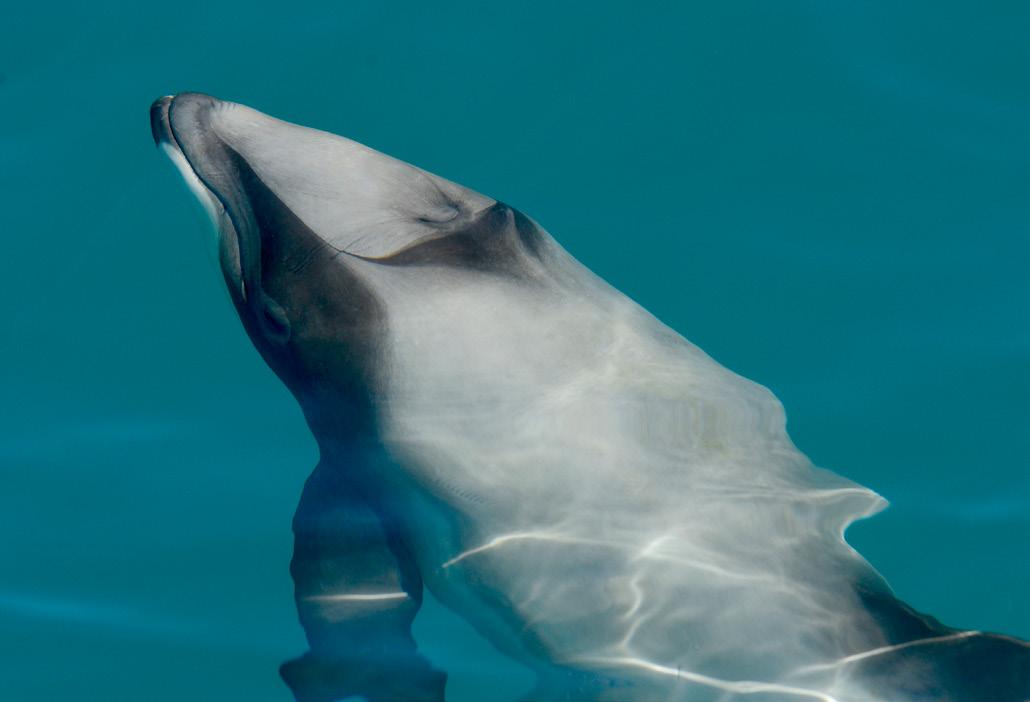
Set nets are now banned in inshore waters in many areas, with greater protection afforded to Banks Peninsula/the Canterbury Bight, Te Waewae Bay, and through most of the west coast of the North Island.
But there is very little protection from gillnets, and none from trawling, on the west coast of the South Island, and there is no dolphin protection yet on the east coast of the North Island. Trawling has been restricted in close inshore waters, but only in some areas and only for relatively large trawlers.
Even with the latest expansions, protection does not covers the entire habitat of New Zealand dolphins. Exceptions within the protection result in continued captures.
The government’s stated goal is for endemic dolphins to thrive throughout their natural range and for populations to return to 95% (Māui dolphin) or 90% (Hector’s dolphin) of the “carrying capacity” of the environment. An admirable goal but difficult to determine.
Steph Bennington is a PhD student at the University of Otago. Her research goal is to understand and predict the future of New Zealand dolphins. The aim is to provide an assessment on the efficacy of protection and understand what is needed for New Zealand dolphins to thrive throughout their natural range. Steph would like to thank the New Zealand Whale and Dolphin Trust, University of Otago, the Otago Research Committee, the Diane Campbell-Hunt Award, and the Marks Ecology Award for their support of her research.
 The Banks Peninsula is home to an important population of Hector’s dolphins. Jeremy Wood
Peaceful surface of a Hector’s dolphin off Banks Peninsula, Canterbury. Steph Bennington
The Banks Peninsula is home to an important population of Hector’s dolphins. Jeremy Wood
Peaceful surface of a Hector’s dolphin off Banks Peninsula, Canterbury. Steph Bennington
49 Winter 2023 |
TIAKINA TE KAURI
PROTECTING SOUTHERN GIANTS
In his second article about southern kauri, Dr Bruce Burns looks at their unique ecology and threats. What does the future hold for this much-loved taonga in the Waikato?
Kauri is sometimes referred to as a foundation species in forests because its presence has a strong influence on which other plants can grow with it. Dead leaves, cone scales, and bark and branches of kauri are very slow to decompose, and these accumulate to create a deep organic layer on the forest floor.
These deep organic soils are invariably very low in nutrients and dry out very fast between rain events. This means only certain plants associate with kauri – those able to grow in such infertile, drought-prone soils.
Despite or because of this, kauri stands are generally the most plant-species rich of any forest type in New Zealand and contribute disproportionately to overall forest biodiversity.

This high biodiversity also increases over time so mature stands have higher plant-species richness than younger regenerating stands – and often contain highly distinctive and unique plant compositions.
For example, kauri is the dominant species at the Waiomu Kauri Grove, on the Coromandel Peninsula, where it grows with Hall’s tōtara, miro, tōwai, tānekaha, tawa, rewarewa, white maire, toatoa, Kirk’s daisy, Pseudopanax discolor, tāwheowheo, kauri grass, and karapapa.
Other common forest types at the southern end of the kauri range include areas of dense kauri regeneration after logging – for example, Otahu Valley, near Whangamata, and rare large kauri scattered within podocarp-broadleaf forest at mid-altitudes.
Kauri’s southern domain is notable, however, as being the home of three more unusual plant associations with kauri.
Ian Preece
The first occurs along the crest of the Coromandel Range and on the heights of Moehau, with often stunted kauri occurring above 600m alongside a range of distinctive
SPECIAL REPORT | Forest & Bird Te Reo o te Taiao 50
sub-montaine species, including pāhautea or yellow-silver pine (but never together), rimu, tāwari, tāwheowheo, tōwai, toro, toatoa, broadleaf, and mountain neinei.
On Moehau, several kauri in this type of association have tipped up but remain alive, the trees taking on a bizarre, somewhat prostrate, growth form. The highest altitude site on which kauri grow anywhere is around 810m in elevation, on Moehau and Table Mountain, both in the Coromandel Range.
Kauri mixed with hard beech and tānekaha is another forest type concentrated in the southern kauri domain. Hard beech (Fuscospora truncata) has the most northerly distribution of the five New Zealand beech species.
Stands of kauri, tānekaha, and hard beech are most associated with the Kapowai catchment of the Coromandel, the Miranda Scientific Reserve, the Hapuakohe Range, including Te Hoe, and the southern fringe of the Hūnua Ranges. Here we see two iconic plants that define the forest ecology of New Zealand, kauri and beech, coming together in one place!
Lastly, in locations around the Coromandel Peninsula, kauri forest extends to the coast, showing that kauri can also tolerate salt winds. At Potiki Bay, for example, kauri occurs as coastal forest unusually with taraire, pōhutukawa, and hard beech. Other examples of coastal kauri forest occur at Kennedy Bay and Tapuaetahi Bay.
THREATS TO SOUTHERN KAURI

Despite being mostly protected from logging and loss of forest integrity by further forest fragmentation, risks to the continued existence of southern kauri still exist.
Chief among these is kauri dieback disease, caused by a funguslike plant pathogen Phytophthora agathidicida, which was first identified on Aotea Great Barrier Island in 1972 but not recognised on the mainland until 2006.
Kauri dieback disease attacks the roots and vascular system of kauri, eventually leading to tree starvation and death. Although kauri dieback disease is widespread in Northland and Auckland, the southern extent of kauri is almost free of this disease, with only a handful of known sites.
This near absence of kauri dieback disease in the Waikato and Bay of Plenty regions increases the importance of the kauri forest ecosystems there for the future survival of the species.
It also highlights the importance of preventing the movement of this disease to precious uninfected areas, a responsibility we all share.
A further major threat to the persistence of kauri is climate change. Modelling indicates that New Zealand will be subject to increased mean temperatures and increases in extreme weather events – for example, storms and droughts. Residents of the Coromandel Peninsula will not be surprised by these results after the storms of the 2022/2023 summer.
It is the latter that may have significant effects on kauri populations. Already, northern New Zealand has experienced recordbreaking droughts in the summers of 2012/13 and 2019/2020.
Kauri are reasonably resistant to drought, with deep roots, stem water stores, and conservative water use, but there are limits to
these strategies. The small trees are at most risk of death from drought events.
This was highlighted when many small planted kauri in urban and restoration areas died during both recent droughts. Species that occur with kauri are also at risk of mortality due to drought. For example, all hard beech associated with kauri at Pukemokemoke, northwest of Hamilton, had died by 2010.
Southern kauri may, however, offer a refuge from some impacts of climate change – and potentially offer an important reservoir of genetic diversity.

Droughts are likely to be more severe in Northland than the Waikato, and drought on the east coast will be harsher than the west coast, according to future predictions for Aotearoa. Therefore, the southern part of the kauri range provides some of the best opportunities to ensure kauri survive the increased drought episodes in the future.
The fact that kauri occur in a wide range of bioclimatic conditions within the Waikato region suggests these stands could be usefully explored for genotypes resilient to current and future threats, although the breadth of genetic variation found in these kauri populations is still unclear.
Pests, predators, and human impacts are also threats to kauri forests, just as they are for other
Kauri forests are plant-species rich. Ian Preece
Cleaning station set up to protect the forest from kauri dieback disease. Caroline Wood
→
51 Winter 2023 |
kinds of native forest. Thankfully, a large proportion of kauri in its southern domain lies within protected areas – for example, on public conservation land or in covenants.
However, significant areas of kauri forest are also found on private Waikato land that is unfenced and vulnerable to trampling and compaction by stock, as well as potential development pressures and vegetation clearance, particularly along forest margins.
Possums, goats, feral pigs, and deer also have impacts in kauri forests, either by the browsing of palatable species, predation of fauna, or disturbance of the litter and soils. Kauri seedlings themselves are often browsed by possums and goats.
THE FUTURE
The desire to restore the former magnificence of kauri forest in its southern range fuels a continued fascination with kauri among residents of the Waikato and Bay of Plenty.


The species is regularly incorporated into ecological restoration plantings – for example, at Waiwhakareke Natural Heritage Park, near Hamilton Zoo. As well, recognising the high forestry potential of kauri, plantations have been established sporadically over the last 80 or so years in various parts of its southern range.
These plantations have shown relatively fast growth rates, indicating that opportunity exists
to grow kauri in silviculture on selected good-quality sites over rotations of 60–80 years or less. Interestingly, kauri plantations monitored near the natural southern limit of the species have performed as well or better than plantations further north.
Meanwhile, carbon sequestration rates of planted kauri, while initially slow, increase in older planted stands and become a competitive option as effective carbon forests once kauri life expectancy is taken into account.
There are many fascinating facets to the story of kauri throughout its range and specifically in its southern domain. Waikato and Bay of Plenty remain strongholds, albeit reduced from their former extent. These places add much to the ecology, history, sense of place, and potential future of this iconic taonga in New Zealand.
But what of kauri’s future in the south, will kauri remain a remarkable but lesser-known point of interest there? Or will southern kauri thrive with greater recognition, protection, and opportunities to create new forests?
As an optimist, I’m hoping for and anticipating the latter.
This article was commissioned by Waikato Regional Council, with the support of Tiakina Kauri, the Kauri Protection Agency. Dr Bruce Burns is an Associate Professor, School of Biological Sciences, University of Auckland. He is one of New Zealand’s leading kauri experts, and his article is reproduced here by kind permission. To find out more about the history of southern kauri, see Bruce’s article in our March 2023 issue. For more information about kauri protection, see www. kauriprotection.co.nz
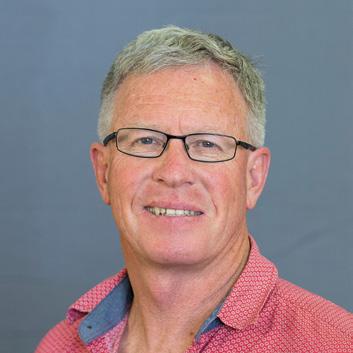
nga Iwi Katoa
Kia toitū te whenua
Kia toitū te kauri
Kauri is a shelter for all people
So the land endures
So the kauri endures
PROTECTING KAURI
Last year, the government launched a new National Pest Management Plan to provide nationwide consistency for managing the impact of kauri dieback disease. Keeping this devastating disease out of the Waikato rohe is a central component of the plan, which brings together government, Māori, councils, and communities to work collaboratively on kauri protection. The plan is aimed at reducing the spread and impact of the plant pathogen that causes kauri dieback disease, maintaining disease-free areas, and managing access to kauri forests. At the heart of the plan is Te Tiriti o Waitangi and a partnership between the Crown and Māori to actively work together on kauri protection and implementation, including co-design and cogovernance of the work carried out under the plan.
Ko te kauri he whakaruruhau mō
→
Regenerating kauri forest. Ian Preece
SPECIAL REPORT | Forest & Bird Te Reo o te Taiao 52
Whakataukī created for the national kauri protection programme Tiakina Kauri. Ian Preece
TOP SHOTS
To celebrate Forest & Bird’s 100th birthday, the team at Bushy Park Tarapuruhi organised a photo competition to highlight the native forest and its inhabitants.
Nature photographers play a vital role connecting people to Aotearoa New Zealand’s unique landscapes and the species that live in our forests, rivers, oceans, and wetlands.

They can take us to places we may not be able to travel ourselves, give us a different perspective on the world, and open our eyes to the beauty of less charismatic species.
“A good photo can sometimes be an arrow to the heart of things, alluding to or eliciting an immediate encounter,” said Craig Potton, landscape photographer and Forest & Bird Ambassador, in his book Moment and Memory
“It is the nature of art and the way of nature to push us beyond the narrow realities we often become trapped in, to new or forgotten realms of pleasure.”
Mark Brimblecombe won the adult competition with his charming toutouwai, often seen flitting around on the forest floor at Bushy Park Tarapuruhi.

The under-15s category was won by Mihaila Haami, 14, of Kai Iwi, who entered several photos and won with “rākau”.
She said her images were inspired by this whakataukī Māori proverb: “Mate atu he tētēkura, ka whakaeke mai he tētēkura – As one frond perishes, another grows in its place.” “Looking through these photos felt like a real celebration of this forest and its inhabitants, which was really our purpose in launching this competition,” said Mandy Brooke, Bushy Park Sanctuary Manager.
“We often see people with cameras out visiting Bushy Park Tarapuruhi, and it seemed an opportunity to share some of their work and a very appropriate way to help celebrate Forest & Bird’s 100th birthday.”
Thank you to H&A Print for sponsoring the competition.
Select Forest & Bird as your charity and Pathfinder will donate 20% of its KiwiSaver management fee annually. In 2022, Forest & Bird received $74,349, and in 2023, it received $115,680!
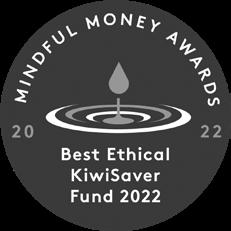

Switch to Pathfinder KiwiSaver Plan today.
www.pathfinder.kiwi
PHOTOGRAPHY
WINNING SHOT Toutouwai North Island robin. Mark Brimblecombe
RUNNER UP Fungi. Lynette Vallely
53 Winter 2023 |
Save for your
future without it costing the earth.
Pathfinder Asset Management Limited is the issuer of the Pathfinder KiwiSaver Plan. A Product Disclosure Statement for the offer is available at www.pathfinder.kiwi
FINDING OUR VOICE
A booming post-war economy brought many challenges for the men, women, and children attempting to stop the country’s fast-vanishing nature disappearing forever. In part 2 of our history of Forest & Bird (1946–1979), we look at the Society’s growth into the regions and its first flax-roots restoration projects. We chart the path to the National Parks Act 1952, the first rat-free island in the world, and the fight to save Manapouri – regarded as a watershed moment in Aotearoa New Zealand’s environmental history.
Caroline Wood
The Society’s rising profile after the Great Depression and World War II saw a rapid growth into the regions with 13 official “representatives” located from Upper Northland to Southland. However, branches were not encouraged under Sanderson’s leadership, with just four being established in the Society’s first two decades. Following his death in 1945, members started pushing for change – they wanted to form themselves into semi-autonomous groups that could work to preserve nature in their own backyards. But “branches” still weren’t permitted under the incorporated society’s constitution, so a workaround was proposed and “sections” allowed instead.
The first was founded by
Lance McCaskill in Christchurch in 1946, with Auckland and Gisborne following in 1947. Run by volunteers, the first sections advocated for nature locally and organised various conservation activities in their local communities, including guided trips to local scenic reserves and educational talks by conservation experts. From around this time, they would also establish the Society’s first groupbased conservation work, including local planting, weeding, and pest control projects.

In 1956, the Society’s constitution was changed so
sections could become official branches, and community-based conservation began to take flight in Aotearoa, with Forest & Bird’s volunteers leading the way. Thirteen sections and branches were established in the 1950s, followed by another nine in the 1960s, and 18 more during the 1970s. As the network grew to all four corners of the country, members played a vital role as the eyes and ears of the Society, feeding local intelligence to the Wellington national office on risks to nature from various threats, often the loss of native habitat through huge post-war economic developments – new roads, hydroelectric dams, farms, and housing.
A key focus for the Society since its inception in 1923 had been engaging children in a love of nature. In 1949, the first school groups were established, and many families experienced positive and sometimes lifechanging experiences at a series of annual nature “family camps” held in national or local parks and scenic areas. The first was in Waikaremoana, Te Urewera, in January 1953 and was described as “an unqualified success”, with 58

CENTENNIAL STORIES
Forest & Bird families at Dawson Falls, Egmont National Park, 1967. Forest & Bird Archives
| Forest & Bird Te Reo o te Taiao 54
Lance McCaskill
attending, including 14 children. The last was held at Lake Rotoiti in 1983. The driving force and organiser of the family camps initiative was Society stalwart and keen deerstalker, hunter, climber, and tramper Bernard Teague (1903–82), who attended the inaugural event and gave one of the nightly illustrated talks called “In praise of Tuhoe country”. Teague had explored the forests of Te Urewera in his 30s and was one of few pākehā to be familiar with the area.
Over the next six years, Teague’s family camps alternated between Waikaremoana and Taranaki, and around the country into the 1960s. In 1959, there were two, one at Dawson Falls, Taranaki National Park, and the other at Rewarewa Marae, Ruatoki, Te Urewera. At the time, Teague was pressing for preservation of the forest in the Ruakituri catchment of the Wairoa River. In 1961, he was founding chair of Forest & Bird’s Wairoa section and won the Loder Cup in 1964. He was a member of the Urewera National Park Board, served on Forest & Bird’s council for many years, and was elected Vice-President in 1969. He died in 1982, aged 78, having left a huge legacy for nature.

INTO THE WORLD
In 1949, Forest & Bird became a member of International Union for the Protection of Nature, with the Society’s minutes showing a £12 bank draft was sent as the first annual subscription. Today, 70 years later, this organisation is known as the International Union for the Conservation of Nature (IUCN) and Forest & Bird is still a member. Based in Switzerland, there are 1400 members from more than 170 countries. The Society serves as one of seven official New Zealand members representing the interests of Oceania’s natural taonga on the international stage.
first representative. McGregor was chairman of the Society’s Auckland Branch from 1950 to 1953 and 1965 to 1968. At the request of the Society, he prepared a large independent report on the effects of deer populations on New Zealand’s forests and steep mountain slopes that was presented to Parliament around 1964. McGregor, who died in 1977, will forever be remembered for having done much to preserve Waipoua, the only forest reserve set aside in perpetuity by a special Act of Parliament.

LEAVING A LEGACY
WAIPOUA GIANTS
After World War II, the Society backed the efforts of Professor “Barney” McGregor, of Auckland University, to prevent the continuation of kauri logging in Waipoua Forest, Northland, that had been instigated as a war measure. Forest & Bird joined three local preservation groups for a battle that continued fiercely until 22,500 acres were declared Aotearoa New Zealand’s first kauri forest sanctuary. It was officially opened in 1953, and Forest & Bird was invited to nominate a representative to sit on the Forest Sanctuary Advisory Committee. William Fraser, of Whangārei, became the Society’s

From the 1950s, we see an uptick in the number of New Zealanders gifting land with high natural values to Forest & Bird. In 1951, Hugh Alexander donated land that today forms the Society’s oldest reserve, Ngaheretuku, near Clevedon, south of Auckland. It contains significant stands of regenerating kauri and kahikatea forest and abundant birdlife, and Forest & Bird volunteers have been looking after it for the past 70 years. By the Society’s 50th birthday, in 1973, branch volunteers were looking after more than 2000 acres (809ha) of nature reserves all over the country.
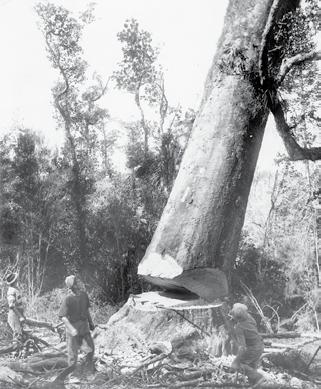 Kauri tree being felled by loggers, 1950.
Ruatoki camp leaders, 1959: Bernard Teague (bottom right), Violet Rucroft (top left), Bessie Jarram (blue cardigan), and Alfred Morris-Jones (holding taiaha). Forest & Bird Archives
The 43ha Walter Scott Reserve was gifted to Forest & Bird in 1963 by sisters Mary and Lilian Valder. It is located in the Waikato. This photo shows a fencing party there in 1964. Forest & Bird Archives
Kauri tree being felled by loggers, 1950.
Ruatoki camp leaders, 1959: Bernard Teague (bottom right), Violet Rucroft (top left), Bessie Jarram (blue cardigan), and Alfred Morris-Jones (holding taiaha). Forest & Bird Archives
The 43ha Walter Scott Reserve was gifted to Forest & Bird in 1963 by sisters Mary and Lilian Valder. It is located in the Waikato. This photo shows a fencing party there in 1964. Forest & Bird Archives
55 Winter 2023 |
Bernard Teague
NEW NATIONAL PARKS
One of the most significant pieces of environmental legislation ever placed on the statute books in Aotearoa New Zealand was the National Parks Act of 1952. It had the purpose of protecting in perpetuity, as national parks, for the benefit and enjoyment of people, scenery of such distinctive quality, or natural features so unique or beautiful, that their preservation is in the national interest. At the time, there were five national parks (Tongariro, Egmont, Arthur’s Pass, Abel Tasman, and Fiordland), and the Federated Mountains Clubs, Forest & Bird, and others had long lobbied for more to be established. A breakthrough came when the first National-led government came to power in 1949. FMC and Forest & Bird worked with the new Minister of Lands Ernest Corbett to create a series of the long-awaited new parks and reserves. Corbett, a dairy farmer from Taranaki, was the first Forest & Bird member to become Minister of Lands, as well as Minister for Forests and Māori Affairs. The conservative politician made excellent use of his position, adding 1.2 million acres (500,000ha) to the national park system and 147 scenic reserves. Between 1953 and 1956, he succeeded in bringing three new National Parks into the fold, all historically reserves – Mt Cook, Urewera, and Nelson Lakes. These were later followed by Westland and Mt Aspiring National Parks.
PREDATOR-FREE MILESTONE
In the 1950s and 60s, “noxious animals” – introduced mammalian predators and pests – were still a huge concern, with rats decimating birds on island nature sanctuaries, the march of introduced “opposums” northwards, and an ongoing deer menace all over the country. In 1960, a Forest & Bird junior section from Blackpool School, Waiheke Island, made history by systematically poisoning all the Norway rats that had recently swum to tiny Maria Island, in the Noises, and decimated a colony of ground-nesting whitefaced petrels. They and their indomitable teacher Alistair McDonald, with the blessing of the Wildlife Service (the forerunner to DOC), laid rat bait over the island and killed all the rats. The Wildlife Service took over the project in 1961 when McDonald left the island, and it was officially declared rat-free in 1964, in what we believe to be a world first. Over the next three decades, other Forest & Bird branches in Auckland and greater Wellington would help pioneer a series of landmark communityled island restorations at Tiritiri Matangi, Matiu Somes, and Mana islands.
ROYAL CHARTER
The Society received a Royal Charter from the Queen on its 40th birthday and became the Royal Forest and Bird Protection Society in 1963. It had grown from a handful of members in March 1923 to 10,000 by March 1963. Around the same time, the Executive commissioned a well-known director, John O’Shea of Pacific Films, to make a documentary about New Zealand’s natural heritage and the work of the Society in protecting it. The Need for Nature was released in 1969 and shown before the main feature in cinemas all over the country during 1970. Today, the restored 16-minute colour film provides a fascinating window into the conservation concerns of the Society as it headed towards its first half century, with footage of Arthur’s Pass, the Wairarapa, Kāpiti Coast, Ruapehu, Tarapuruhi Bushy Park, and Waipoua, and shots of Forest & Bird members carrying out conservation activities.
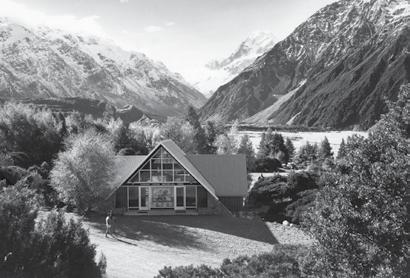
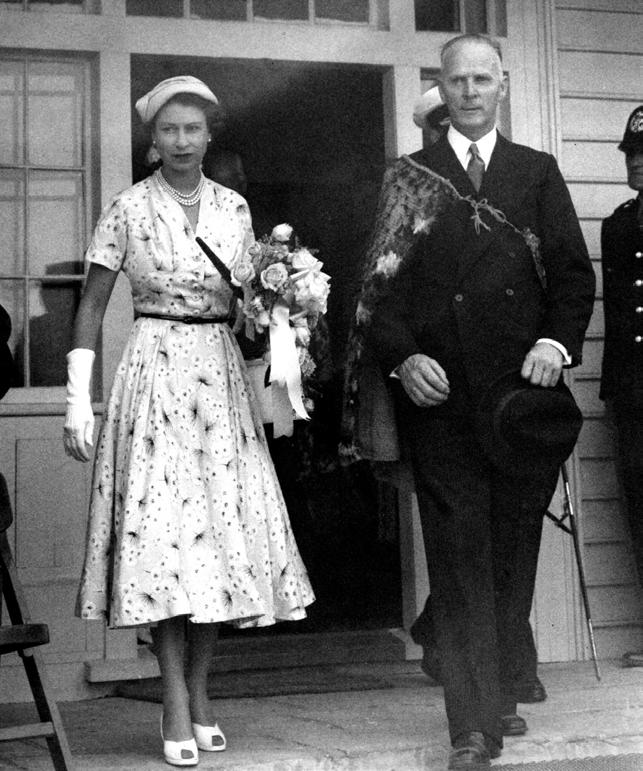
SAFETY IN ISLANDS
Securing suitable offshore islands to turn into bird and nature sanctuaries occupied the mind of incoming President Roy Nelson, who served from 1955 to 1974. He was desperately worried about fast-
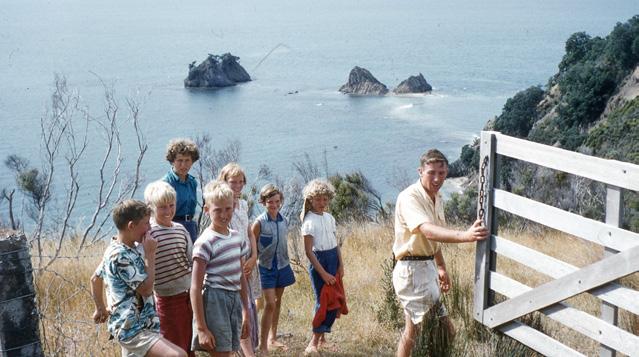

CENTENNIAL STORIES
Queen Elizabeth II with Ernest Corbett, Minister of Māori Affairs, 1953–54.
Mount Cook National Park headquarters, 1960s. Forest & Bird Archives
Junior members of Forest & Bird with their teacher Alistair McDonald, Waiheke Island, late 1950s.
| Forest & Bird Te Reo o te Taiao 56
Alistair McDonald in 2019. Kevin Hackwell
disappearing indigenous flora and fauna after huge swathes of habitat on the mainland were cleared to make way for post-war economic developments. In 1959, Nelson sought advice from ecologist Ian Atkinson, of the Department of Scientific and Industrial Research, on the availability of islands to buy for the purposes of conservation in the Hauraki Gulf and Bay of Plenty. Atkinson produced a list of possible candidates. In 1967, Nelson pledged a generous donation to help the government buy Mangere Island, Rēkohu, to save the Chatham Island black robin from imminent extinction. Then, in 1976, at the request of the Wildlife Service, the Society organised a fundraising appeal that smashed its targets and helped the government purchase Maud Island, in the Marlborough Sounds, to protect the endangered Maud Island frog. The rest of the money went towards the restoration of the karure kakaruia black robins’ forest habitat on Mangere Island, as described in our March 2023 issue.
PIVOTAL MOMENT
“Big hydro” electricity-generating schemes in the 1960s threatened some of New Zealand’s wild rivers and freshwater lakes and led to the Save Manapouri campaign, a turning point in New Zealand’s environmental history. Forest & Bird threw down the gauntlet in 1960 and spent the next 12 years fighting to save the lake in Fiordland National Park from being inundated as part of the Manapouri power project, including organising what was then (1970) the largest petition in the country’s history, signed by more than 260,000 people. The cost of the fight nearly bankrupted the Society, but the campaign was won when the incoming Labour government backed away from raising the lake in the face of mass protests. Plans to raise the lake’s water level were cancelled in February 1973. The huge outpouring of public anger radicalised a new generation of conservationists who joined the “cause” of nature protection, and environmental groups sprung up, including Greenpeace in 1974 and the Native Forests Action Council (NFAC) the following year. The dawn of the modern-day conservation movement had arrived, and Forest & Bird experienced a huge jump
in membership, which hit 20,000 for the first time in 1975. The influx of new supporters brought in more donations that allowed the Society to widen its reach and impact. The stage was set for some of the most tumultuous times in New Zealand’s environmental history.
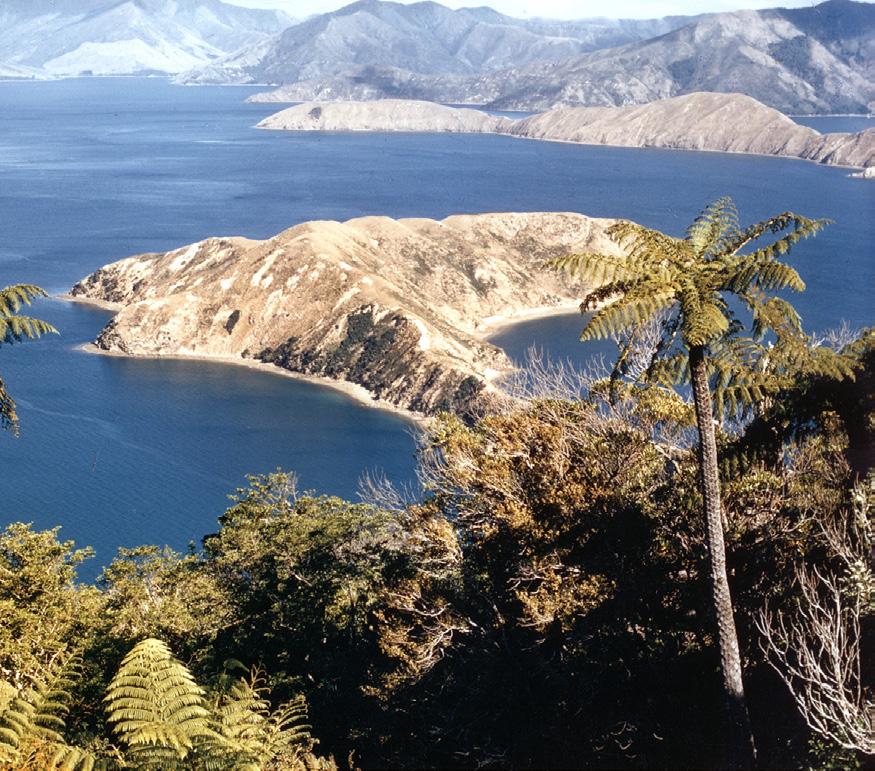

IN THE NEXT ISSUE:
Defining the wilderness, dawn of the Anthropocene (Forest & Bird’s history from 1980 to the present day).
FURTHER RESOURCES
n 100 Years and counting: A brief history of Forest & Bird’s work and impact is available for branches at Bit.ly/41XvqKo.
n The first 50 years of Forest & Bird magazine are freely available on the Papers Past website at paperspast.natlib.govt.nz/ periodicals/forest-and-bird.
n A brief history of 37 Forest & Bird reserves: Bit.ly/41XIoaW

n Examples and history of Forest & Bird’s posters (1923–73) + KCC’s first poster: Bit.ly/3OrC0FT
n History and links to Forest & Bird’s early conservation films (1920s–1969): On request.

n For the official founding date of your branch, please reach out to Michael Pringle at m.pringle@ forestandbird.org.nz
Forest & Bird would like to thank the Stout Trust for its generous support in funding the Force of Nature history project. We also acknowledge the National Library of New Zealand and Ngā Taonga for their help in bringing these stories and many others to light. If you have any questions about Forest & Bird’s history project, contact Caroline Wood, at c.wood@forestandbird.org.nz
Christine Foxall sorting Manapouri petition forms that were arriving at a rate of 4000 to 5000 a day in 1970. Alexander Turnbull Library
Maud Island frog. Zealandia
Roy Nelson
57 Winter 2023 |
Colourised photo of Maud Island from peak, circa 1960s. Forest & Bird Archives
DIFFERENT
Auckland Whale and Dolphin Safari has been sharing the marine delights of Tīpaka Moana with visitors since 2000. Jazmine Ropner hops onboard.
In order for larger species such as baleen whales and dolphins to thrive in the Hauraki Gulf, the food web in the marine park needs to include a very special animal,” explains Sanaa Nair and asks whether anyone can name what it is.
“Plankton!” an excited passenger yelled out.
“Correct!” says Sanaa, as another crew member George Winship passes around a jar full of recently collected seawater, so everyone can get a closer look at some zooplankton.
A Secchi disc is also dropped into the Gulf to measure the turbidity of the water and the levels of particles suspended in it. It shows there is quite a bit of phytoplankton today, which is a good sign for marine mammals in the vicinity.
The crew contributes the scientific information collected during its daily trips into Tīpaka Moana to a worldwide ocean health monitoring database, part of a citizen science project.
“We take this measurement on each sailing we do to add to the database but also to give the passengers a visual understanding of the importance of phytoplankton in the marine food web,” adds George.
“When the passengers get on board, their expectation is to see a whale. We also want them to recognise the importance of smaller organisms for the whales.”
The Auckland Whale and Dolphin Safari is purposely named “safari” because the whales, dolphins, and other marine treasures they hope to see could be anywhere at any time. For this reason, there is no set itinerary for any sailing. The crew use previous knowledge and radio reports to track wildlife in the 12,000km2 Hauraki Gulf.
Our first stop, about 30 minutes from downtown Auckland, allows us to see some of the beautiful offshore islands located in the Hauraki Gulf with the city skyline still in view.
Soon the ship starts buzzing with anticipation as passenger hands fly up, pointing towards something on the horizon. I narrow my gaze against the glistening sea – gannets are swarming the skies, circling each other.
Suddenly one points down into the sea, smashing into it (they can reach speeds of up to 100kph), then, like an underwater torpedo, a common dolphin bursts from the other direction, into the air. The whole ship gasps with excitement.
It feels as though we are one unit, as every passenger scans the surface for more signs of the frisky cetaceans. And we aren’t disappointed, the pod is circling the area where the gannets were diving for fish.
You are most likely to spot a common dolphin, bottlenose dolphin, or orca in the Hauraki Gulf, with other rarer oceanic dolphin species, such as pilot

GOING PLACES
“
EVERY DAY IS
| Forest & Bird Te Reo o te Taiao 58
Orca come to play. Auckland Whale and Dolphin Safari
whales and false killer whales, making the occasional appearance.
The water was so calm and clear we could see the gannets gliding beneath the water, performing an aquatic ballet before they popped back onto the surface.
We move on. Longer stays watching marine mammals is permitted if the behaviour of the animal doesn’t change. However, there were several calves in this pod. The crew makes the call, after scientifically noting the animals’ behaviour and estimating their numbers, to leave them to their important meal.
Not long after, we stumbled upon a nursery pod of common dolphins with calves, the calm waters allowing us to view their gorgeous shapes and colours clearly.
The crew explains why the dolphins ride the boat’s bow wave – it gives them an “underwater boost” and allows them to conserve energy. But, to we passengers, it looks as if they are having a fun time too.

It isn’t long before we encountered another pod, but these dolphins seemed spooked when we arrived, and their behavior was less exploratory than the other dolphins. Therefore, our crew makes a decision to move on before disturbing them any further.
“Any interactions that we have are on the animals’ terms. We give them an opportunity to interact,” George explains.
Tīpaka Moana contains many exciting and rare species, including 25 marine mammals. Nearly a third of the entire world’s marine mammal species are at some point present in the reserve.
After numerous and exciting up-close dolphin encounters, it’s time to return to Auckland. Sadly, we haven’t encountered any whales on this trip.
Bryde’s whales are the most common whale in the Hauraki Gulf. However there are also humpbacks, blue whales, southern minke whales, and sei and fin whales also present at times.

During the journey back, I take the opportunity to chat to the crew about their future hopes for the Gulf.
“I’m hopeful education and awareness about its biodiversity will become more common knowledge,” says Sanaa.
‘’I hope our tours help people better understand the Gulf’s ocean environment and raise awareness of the importance of marine research,” adds George.
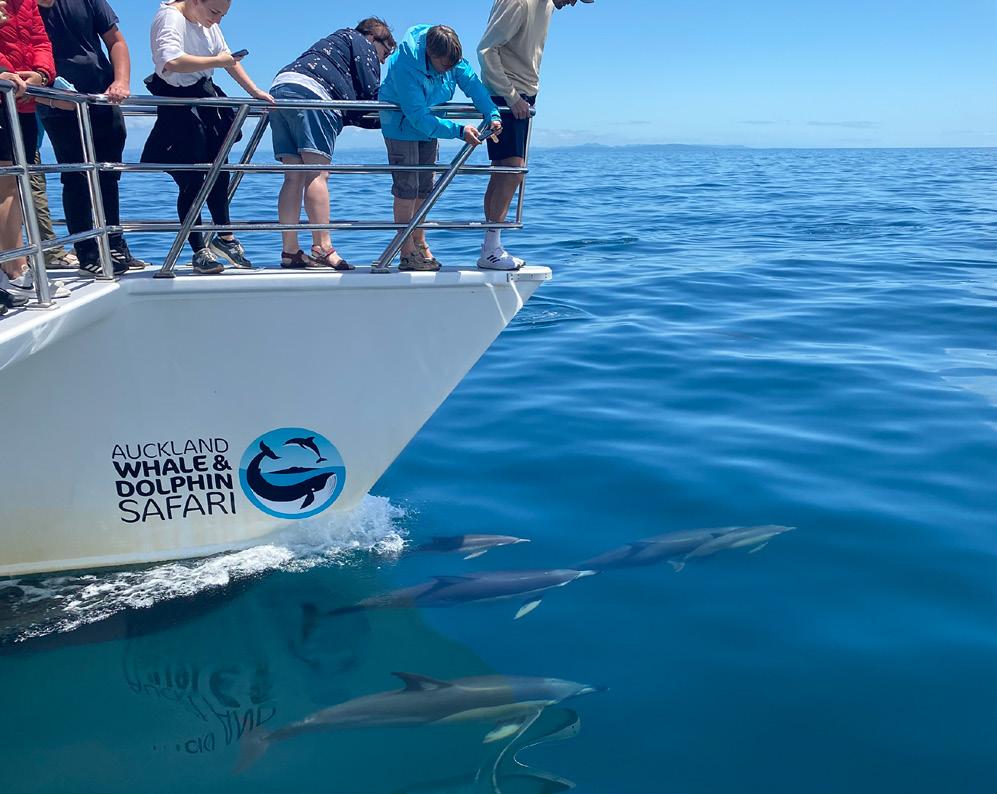
As we gently cruise back into Auckland’s harbour, there is a very rare sighting of a hammerhead shark. George gasps at the news mid-conversation, and I feel
the excitement of each sailing burning in each crew member, even after countless expeditions.
“I hope the Gulf will be granted more protection and that fisheries management will improve, especially surrounding bottom trawling,” says Zara Hopkins.
Trawler fishing and overfishing are the biggest threats to the Gulf, reducing the number of species present, as well as kelp beds and kina barrens.
“If you see a native forest being destroyed, people are up in arms about it, but you can’t see the damage caused by bottom trawling,” adds Zara.
“The destruction of the ocean floor and the animals is invisible, so people are less likely to do something about it.”
Speaking to these passionate crew members about their work makes me feel there is hope the Hauraki Gulf can be returned to its original state of health.
The experience of seeing these rare animals close up, alongside the education provided by the crew, leaves a lasting impression on every passenger. It certainly did for me.
Auckland Whale & Dolphin Safari offers encounters with marine wildlife, including whales, dolphins, seabirds, and seals. Trips leave from downtown Auckland. For more information, go to whalewatchingauckland.com.
Passengers spot common dolphins just off Auckland, in the Hauraki Gulf.
Jazmine Ropner
Crew members collect specimens during each trip.
Jazmine Ropner
59 Winter 2023 |
Bryde’s whale are often spotted in the Hauraki Gulf.
BIRD WORKS
Gretchen Carroll
items sold via Forest & Bird’s online shop. Her artworks are also sold at more than 100 stores nationwide.
“I decided a while ago that, if there’s anyone I wanted to support, it was Forest & Bird because they have a close link to what I am doing.”
It has been a tricky couple of years for the business with the Covid pandemic, but things are bouncing back now the tourist market is returning.
While most of her sales occur in New Zealand, Cathy loves it when she gets an overseas order online. “I enjoy sending something to the other side of the world. Often they have family in New Zealand or have travelled here.
Cathy is one of 13 artists who have volunteered to help celebrate Forest & Bird’s 100th birthday by taking part in our 26 Centena NZ writers and artists project.
Auckland-based Cathy Hansby started her company Hansby Design in 2015, an art print and gift product range that mainly features birds. Her favourite subjects are iconic locals, such as kākāpō, kororā, kea, and of course the kiwi.


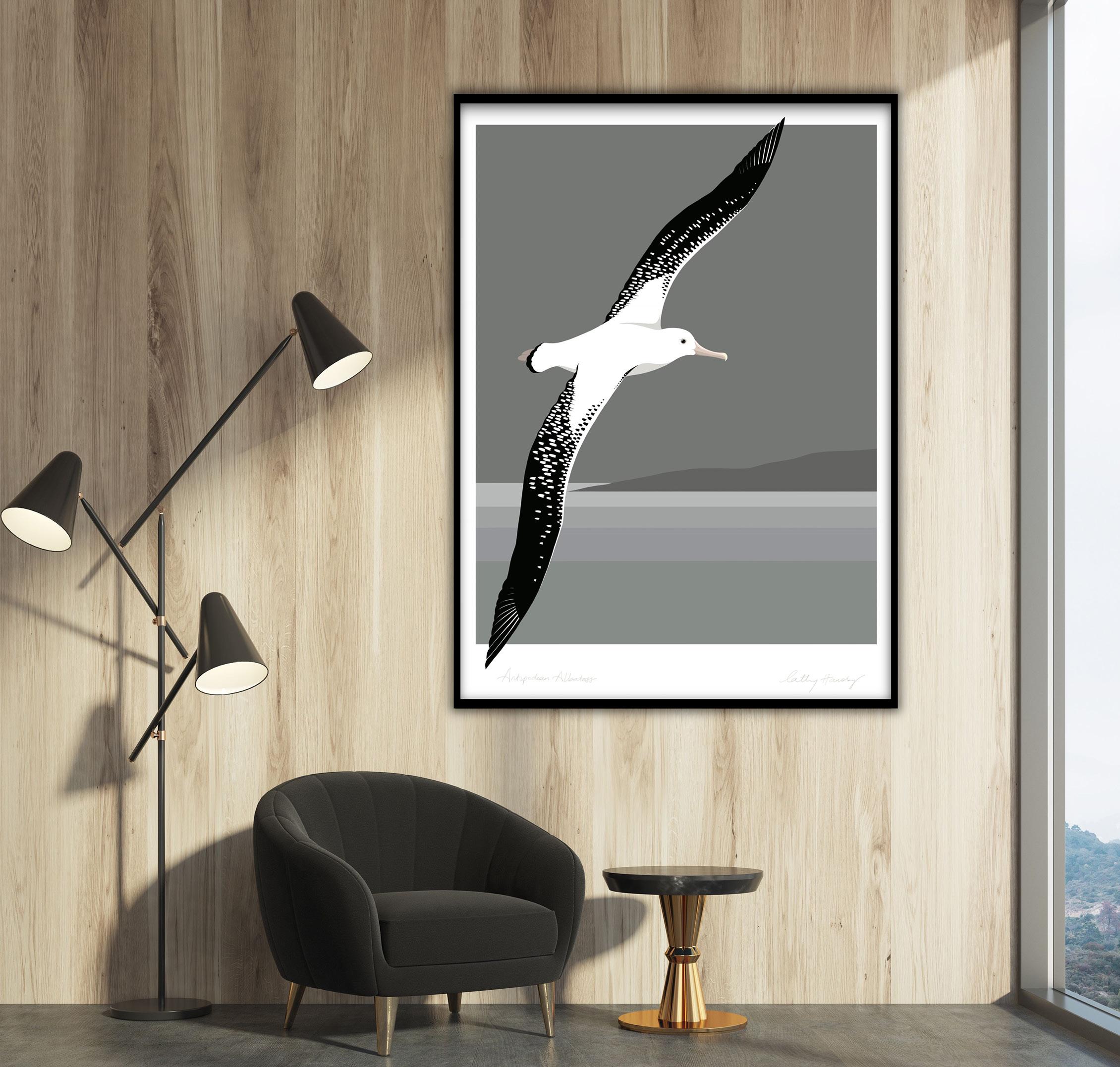
Cathy comes from a fashion background and had her own clothing label for about five years. Then her children came along, and she decided to take a season or two off.
“While I was at home with the kids, I needed a creative outlet and so I started drawing again,” she explained.
“Around that time, Auckland Zoo opened its New Zealand area, and I took my kids to see it. I didn’t realise how many amazing birds we had and wanted to find out more
about our local species.
“Before humans, Zealandia was a land of birds. It must have been a noisy and vibrant place.”
Cathy enjoyed discovering more about Aotearoa New Zealand’s birds and started drawing them.
“I love all animals, but I’ve always had a fascination with birds. The variation in size and shape, the beautiful colours and detailed feathers, I love their character and quirky behaviour.
“My favourite birds to draw are stilts or herons, anything with big wings and long legs.”
Originally, it was only New Zealand birds, but this has widened to include flora, as well as wildlife from Australia, the Pacific Islands, and Indonesia.
“You realise they’ve all got a story to tell and they are all beautiful animals at risk.”
Cathy donates 5% of Hansby Design’s website sales to Forest & Bird and makes a generous donation for any

She will be visiting our Ark in the Park project and creating an original artwork inspired by her visit. We can’t wait to see what she comes up with!
You can check out the Hansby Design range at www. Hansbydesign.com or go to www.shop.forestandbird.org.nz.
OUR PARTNERS
A Kiwi artist has turned her passion into a thriving business with a conscience.
| Forest & Bird Te Reo o te Taiao 60
MARINE LIFE CHAMPION
Ken was a member of the British Airborne Services and served in the 1956 Suez Crisis before emigrating to Aotearoa. In New Zealand, he worked in the boating industry and was President of the Boating Industries Association, where he saw first-hand the damage being done to the marine environment.

Upon his retirement, he began to get active in Forest & Bird. He became Secretary of the Waitākere Branch in 1990 and was “a real powerhouse”, according to the branch, which he chaired for three years. Ken was also on the National Executive of the Society, where he convened the animal pest committee, and served on the marine and administration committees.
Chief among his conservation
interests was a concern for marine life. Ken initiated a successful campaign, with the support of his branch and a local bird rescue organisation, to use funds accumulated from a government levy following an oil spill incident.
In 1994, this led to the establishment of a centre for the treatment of oiled and injured wildlife, known as the New Zealand Wildlife Rehabilitation Trust. This was based near Auckland Zoo and initially run by the Department of Conservation. Later, it moved to Massey University, where it remains to this day.
Ken served on Auckland’s regional marine reserves forum and prepared many submissions on ocean issues. When he received his Old Blue Award in 1998, the branch noted with appreciation his “prodigious” attendance at hearings and dogged persistence with submissions, including at least 100 on the Waitākere District Plan.
He also promoted plans for a West Coast Marine Park, but these did not go forward after strong opposition from commercial fishers.
Together with Dr Peter Maddison, Ken successfully lobbied for the establishment of a marine reserve at Pollen Island, within sight of the Auckland Harbour Bridge, in 1996, and

participated in a group that was successful in stopping the Ports of Auckland from dumping in the shallow waters of the Hauraki Gulf.
In the late 1990s, Ken and Mike Percy, of the Waitākere Branch, campaigned for DOC to save the Hector’s dolphin, which Ken had learned was in danger of extinction. He persuaded the then Minister of Conservation, Sandra Lee, to declare the species endangered in 1997 and allocate funding into research on the population size and locations.

A set net ban was declared on the whole coast on the west of the North Island where the dolphins had been sighted. For this, he was awarded a Certificate of Appreciation by the Society.
Ken supported the Society’s work in many areas, including the protection of West Coast forests. In addition to receiving an Old Blue, he was made a Distinguished Life Member in 2001. In 2005, he was awarded a Queen’s Service Medal for Public Service.
Ken passed away in April 2023 at Waratah Retirement Home, Auckland. He was the dearly loved husband of the late Patricia Catt and step-father of Lynne and Mike. He will be greatly missed by the Society and his friends in the Waitākere Branch.
TRIBUTE
Forest & Bird has lost one of its great stalwarts and tireless workers with the death of Ken Catt QSM in April at the age of 93. Michael Pringle
Pollen Island. Kent Xie
61 Winter 2023 |
Ken receiving his Old Blue award.
‘Carry less, enjoy more’
Come explore with us!
NATURE
Stay overnight at a Nature Reserve. Enjoy the dawn chorus, native birds, the forest, nature walks and serenity.
PHILPROOF PEST CONTROL PRODUCTS
WIPE OUT: Possums, Rodents, Mustelids,
Rabbits
Standard & Mini Possum Bait Stations & Timms Traps
■ Rodent Bait Stations and Block Baits ■ Rodent Snap Traps ■ Fenn Traps (MK4 & 6) ■ Trap Covers ■ DOC 200 trap and lightweight cover.
Also available: Monitoring Tunnels, Flagging Tape, Rabbit Bait Stations.
PHONE
07 859 2943
MOBILE 021 270 5896 PO Box 4385 Hamilton 3247
WEB:
www.philproof.co.nz
EMAIL: philproof@gmail.com
FOREST & BIRD’S WILDLIFE LODGES
Arethusa Lodge
Near Pukenui, Northland
Sleeps 6 herbit@xtra.co.nz
03 219 1337

Ruapehu Lodge
Whakapapa Village, Tongariro National Park
Sleeps 32
office@forestandbird.org.nz
04 385 7374
Mangarākau Swamp Lodge
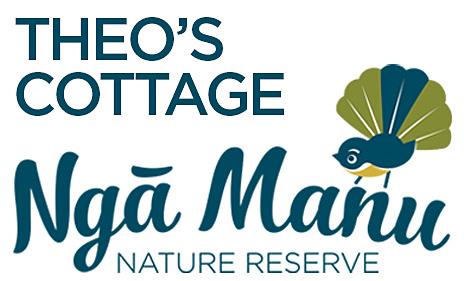
North-west Nelson
Sleeps 10
mangarakauswamp@gmail.com
03 524 8266
http://www.mangarakauswamp.com
• Heaphy Track
• Abel Tasman
• Old Ghost Road
• Cobb Valley
www.kahurangiwalks.co.nz
Phone: 03 3914120
The trust provides financial support for projects advancing the conservation and protection of New Zealand’s natural resources, particularly flora and fauna, marine life, geology, atmosphere, and waters.

More information is available from the Trust at PO Box 10-359, Wellington.
Tai Haruru Lodge
Piha, West Auckland
Sleeps 5+4
hop0018@slingshot.co.nz
09 812 8064
Tautuku Forest Cabins
Owaka, Otago
Sleeps 16
tautukucabins@gmail.com 0273764120
Forest & Bird members can book all of these lodges at reasonable rates. Join today and feel good knowing you are making a difference for New Zealand’s nature. See www.forestandbird.org.nz/joinus
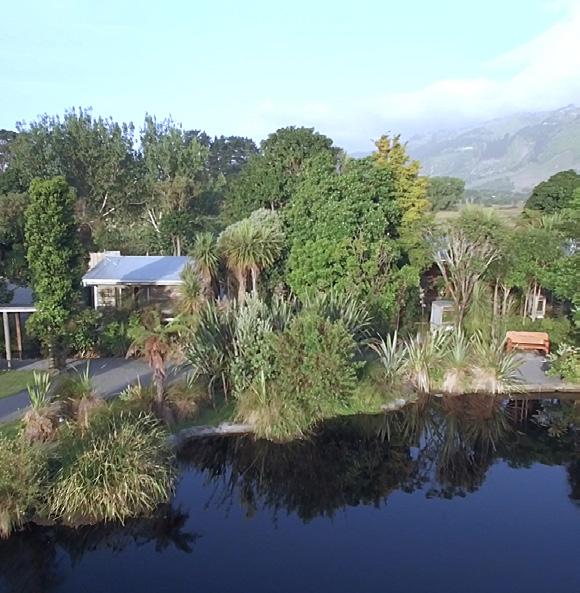

MARKET PLACE
| Forest & Bird Te Reo o te Taiao 62
Ron and Edna Greenwood Environmental TRUST
Book now at ngamanu.org.nz or call 04 2934131
RESERVE, WAIKANAE
Join our knowledgeable local guides on walking tours in the stunning Glacier Country region.

Learn about glaciology, flora & fauna, geomorphology, geology & history of this world renowned landscape. We cater for all ages & abilities, with 2 hr, half day & full day tours in our small groups, at your pace.
0800 925 586
www.glaciervalley.co.nz
Bush Lifestyle For Sale
Well-kept 3-bedroom character bungalow on 4 hectares of covenanted diverse native forest with a grand view of Bethells Beach and the ocean in the northern Waitakere Ranges. First time on the market in 50 years, close to Ark in the Park, and adjacent to the Society’s large Matuku Reserve, its ranger being the vendor.

INFORMATION: https://bit.ly/44CDIKc
Grey Ghost is a limited edition artwork by Tara Swan ($60+p&p). Just 300 prints are available and all profits go to Forest & Bird.
SHOP FOR NATURE
We have lots of other beautiful New Zealand-made gifts in our online shop. Every sale raises funds for Forest & Bird’s conservation work. See https://shop.forestandbird.org.nz

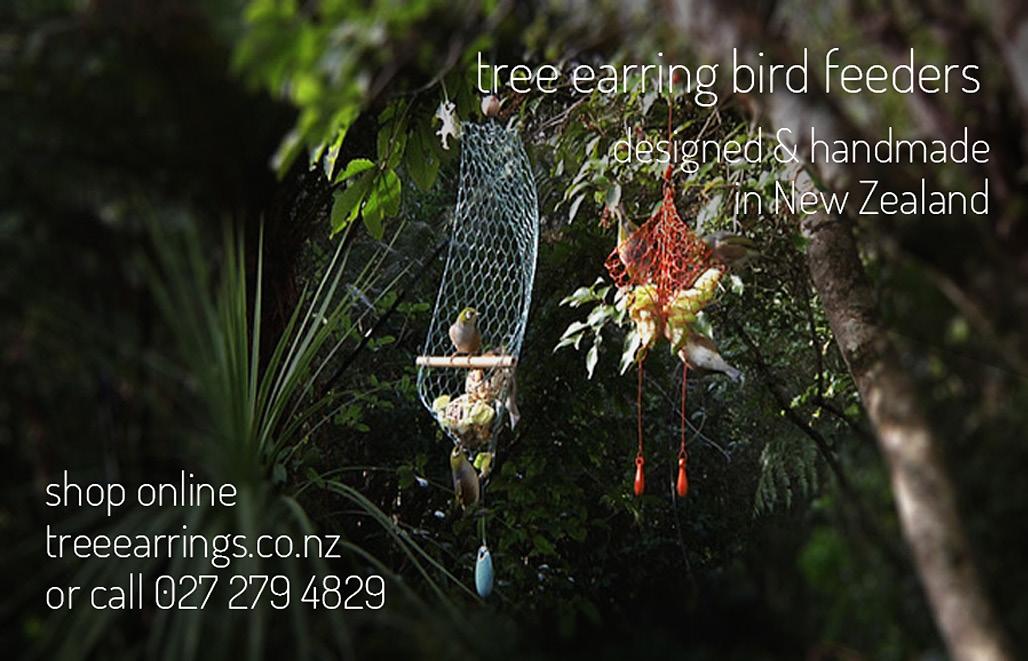

Advertise to Forest & Bird readers here
contact
Condon PHONE 0275 420 338 EMAIL karen.condon@xtra.co.nz and reach 80,000 people who are passionate about nature and the outdoors.
Please
Karen
63 Winter 2023 |
A CLEVER BIRD THING
Do sea gulls navigate by roads? Jo Danilo

I’ve had several odd encounters with birds over the years, and I’m always on the lookout for interesting avian antics. Last week, I witnessed something I’d never seen before.
Driving home through the countryside, my car caught up to the bright flash of a white seagull flying above the road, level with the treetops. There was no traffic behind me, so I knocked my speed down to keep up with the bird, and it kept peering down at me every so often, close enough for me to see its curious eye.
After a couple of kilometres, we reached a T-junction with the main highway together, where I expected to lose the bird. I indicated right and noticed the seagull also turn right directly above the road ahead of me.
“Strange,” I thought to myself, pulling onto the highway (and narrowly missing an oncoming truck in my distraction). I’d never seen a bird following roads before and just assumed it was a coincidence.
A few hundred metres later, there was a turn off the highway to the left. I kept going straight, but the bird turned left! As I watched it fly purposefully down its chosen route, it swivelled its head to look at me one last
time with its curious eye. Clever bird.
So, do seagulls or any other avian aviators navigate by roads?
After a long search, I came across a 2004 article based on a study by Oxford University that found homing pigeons and crows can find their way by following roads.
“Roads and important things like roundabouts do appear to be very attractive to birds,” said Professor Tim Guilford, of the Department of Zoology, Oxford University.
“If they have made the journey before, the pigeons are more likely to say, ‘Well, I know this is south – the way I want to be going – but rather than fiddle around with my inbuilt compass I’m going to follow the A34, which will take me home nicely.’”
So, unless my seagull was a glorious anomaly, perhaps seagulls in Aotearoa New Zealand do this too?
Jo Danilo is a creative writer from Northland, who has been many things in her life, including a zoo keeper and Egyptologist. You can read more of her stories at jodanilo.com.
LAST WORD
The fish and chip shop? Easy peasy ... take a right and then third exit off the roundabout. Can’t miss it!
What do you reckon? Have you spotted any seagulls following SH1 north? Let us know your thoughts. We’d also love to hear from any bird navigation experts who happen to be reading, email editor@forestandbird.org.nz
| Forest & Bird Te Reo o te Taiao 64
Red-billed gull. Michelle Martin
Parting shot
This juvenile korimako bellbird was feeding on flax flowers when it encountered a honey bee intent on sharing the same pollen. I love the look on the bird’s face as it stares down the bee. It was taken at Governor’s Bay, Canterbury. My passion for photography was ignited after the passing of my beautiful mum. I have been taking photos for four years, and being out in nature and at one with the birds, the ocean and wildlife, allowed me to find comfort and solitude in my healing.

WILD ABOUT NATURE | PHOTO COMPETITION
How to enter: Share your images of native birds, trees, flowers, insects, lizards, marine animals, or natural landscapes, and be in to win.
Send your high-res digital file and brief details about your photo to Caroline Wood at editor@forestandbird. org.nz. The best entry will be published in the next issue of Forest & Bird magazine.

The prize: The next winner will receive this stunning Hannah Shand limited edition fine art print Majestic Mr Tūī (A3, RRP $220). Hannah’s artwork features Aotearoa New Zealand’s native honeyeater, beloved for its beautiful bird song and boisterous behaviour. Each of Hannah’s meticulous pen-and-ink artworks takes four to 16 weeks to create. For this artwork, Hannah photographed a tūī at Zealandia, in Wellington, one of her favourite bird-watching spots. The artwork is being used to support Forest & Bird’s centennial celebrations –tūī featured on the Society’s first logo.
Majestic Mr Tūī by Hannah Shand. For more of Hannah’s artworks, see www.hannahshandart.com
 Leanne Buchan
Leanne Buchan
For over thirty years Bivouac Outdoor has been proudly 100% New Zealand owned and committed to providing you with the best outdoor clothing and equipment available in the world. Gear to keep you dry, warm and safe either in-bounds, sidecountry or backcountry this season. Ski, board and gear hire plus full workshop and servicing facilities available this season at our Tower Junction (Christchurch) store.

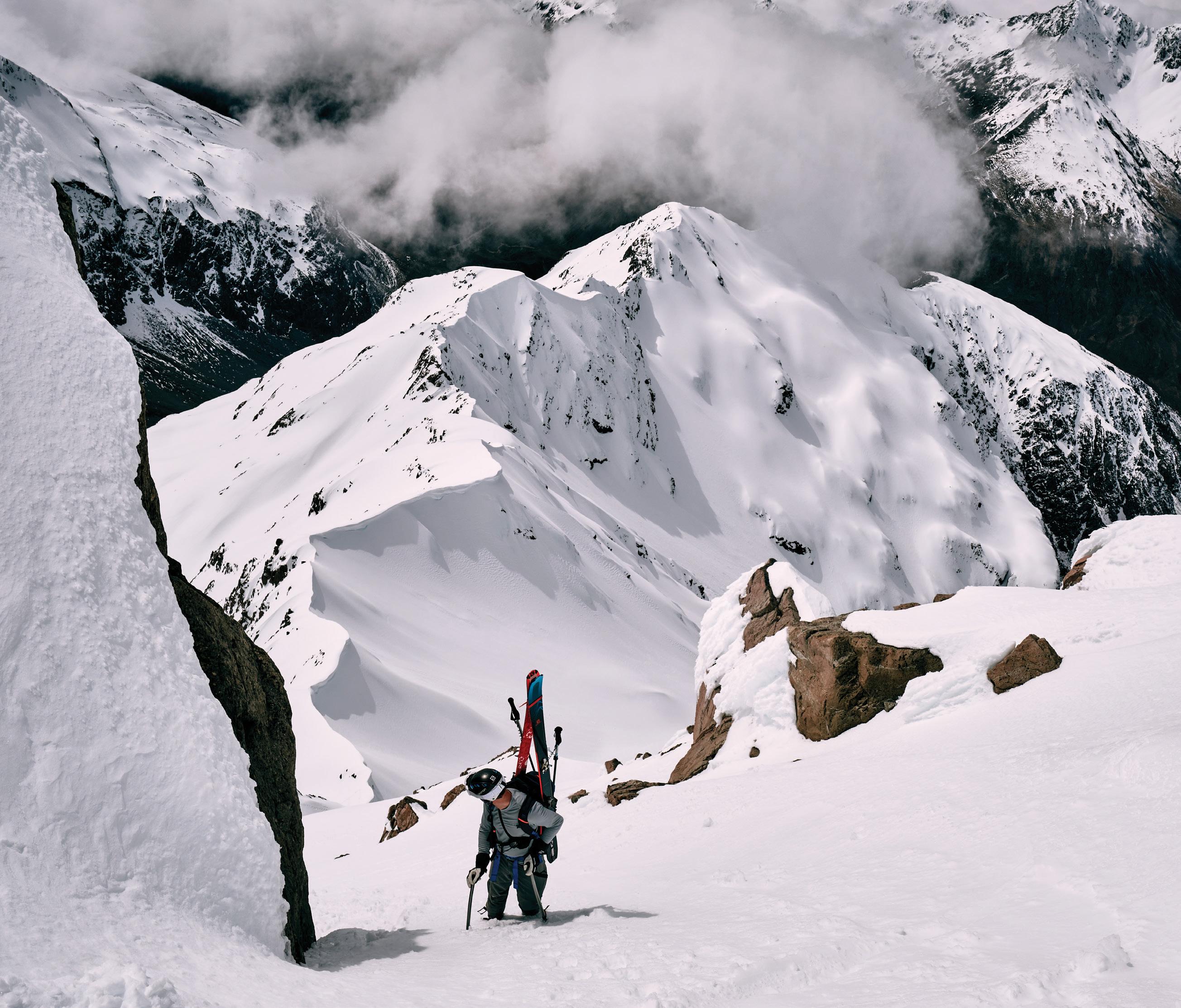 Earning your turns; about to ski off Mt Rolleston, Arthur’s Pass National Park, New Zealand.
Photo by Tom Hoyle.
Supporting Aotearoa's Backcountry Heritage
Earning your turns; about to ski off Mt Rolleston, Arthur’s Pass National Park, New Zealand.
Photo by Tom Hoyle.
Supporting Aotearoa's Backcountry Heritage




























 Force of Nature concert, Auckland Arts Festival Andi Crown.
Esther Williams and Matai Moore, Bushy Park Tarapuruhi.
Sanderson in his Paekākāriki garden, circa 1930s.
Force of Nature concert, Auckland Arts Festival Andi Crown.
Esther Williams and Matai Moore, Bushy Park Tarapuruhi.
Sanderson in his Paekākāriki garden, circa 1930s.



















 A leaf-eating kererū. Heidi Benson
Bathtime for one happy pīwakawaka fantail. John Nelson
A leaf-eating kererū. Heidi Benson
Bathtime for one happy pīwakawaka fantail. John Nelson




















 Tom Kay in front of Redclyffe Bridge, Hawke’s Bay. Chantal Pagel
Tom Kay in front of Redclyffe Bridge, Hawke’s Bay. Chantal Pagel














 Nicola Toki and Jesse Mulligan in the studio for Friday’s Critter of the Week.
Critter of the Week editors Mike Dickison, Marshall Clark, and Tamsin Braisher collaborate on the strap-toothed whale article at Wellington Wikicon, in March 2023 Stephen A’Court
Nicola Toki and Jesse Mulligan in the studio for Friday’s Critter of the Week.
Critter of the Week editors Mike Dickison, Marshall Clark, and Tamsin Braisher collaborate on the strap-toothed whale article at Wellington Wikicon, in March 2023 Stephen A’Court
























 Pérrine Moncrieff. Nelson provincial Museum
Amy Hodgson (centre) collected plants during family picnics and during Forest & Bird trips. Lucy Hodgson collection
Pérrine Moncrieff. Nelson provincial Museum
Amy Hodgson (centre) collected plants during family picnics and during Forest & Bird trips. Lucy Hodgson collection



 Tess
Tess





 Chelsea McGaw
Chelsea McGaw







 Lawrence Gullery
Lawrence Gullery


















 ← First day cover
Miniature sheet →
Tea towel ↓
Postcards ↓
Greeting cards ↓
← First day cover
Miniature sheet →
Tea towel ↓
Postcards ↓
Greeting cards ↓











 Source: Timaru District Significant Natural Areas Survey, Arowhenua Station, prepared for Timaru District Council by Mike Harding, February 2008.
Source: Timaru District Significant Natural Areas Survey, Arowhenua Station, prepared for Timaru District Council by Mike Harding, February 2008.



 The Banks Peninsula is home to an important population of Hector’s dolphins. Jeremy Wood
Peaceful surface of a Hector’s dolphin off Banks Peninsula, Canterbury. Steph Bennington
The Banks Peninsula is home to an important population of Hector’s dolphins. Jeremy Wood
Peaceful surface of a Hector’s dolphin off Banks Peninsula, Canterbury. Steph Bennington















 Kauri tree being felled by loggers, 1950.
Ruatoki camp leaders, 1959: Bernard Teague (bottom right), Violet Rucroft (top left), Bessie Jarram (blue cardigan), and Alfred Morris-Jones (holding taiaha). Forest & Bird Archives
The 43ha Walter Scott Reserve was gifted to Forest & Bird in 1963 by sisters Mary and Lilian Valder. It is located in the Waikato. This photo shows a fencing party there in 1964. Forest & Bird Archives
Kauri tree being felled by loggers, 1950.
Ruatoki camp leaders, 1959: Bernard Teague (bottom right), Violet Rucroft (top left), Bessie Jarram (blue cardigan), and Alfred Morris-Jones (holding taiaha). Forest & Bird Archives
The 43ha Walter Scott Reserve was gifted to Forest & Bird in 1963 by sisters Mary and Lilian Valder. It is located in the Waikato. This photo shows a fencing party there in 1964. Forest & Bird Archives
































 Leanne Buchan
Leanne Buchan

 Earning your turns; about to ski off Mt Rolleston, Arthur’s Pass National Park, New Zealand.
Photo by Tom Hoyle.
Supporting Aotearoa's Backcountry Heritage
Earning your turns; about to ski off Mt Rolleston, Arthur’s Pass National Park, New Zealand.
Photo by Tom Hoyle.
Supporting Aotearoa's Backcountry Heritage